Built Environment Professional Practice 1.
VerifiedAdded on 2023/03/17
|38
|13548
|29
AI Summary
Contribute Materials
Your contribution can guide someone’s learning journey. Share your
documents today.
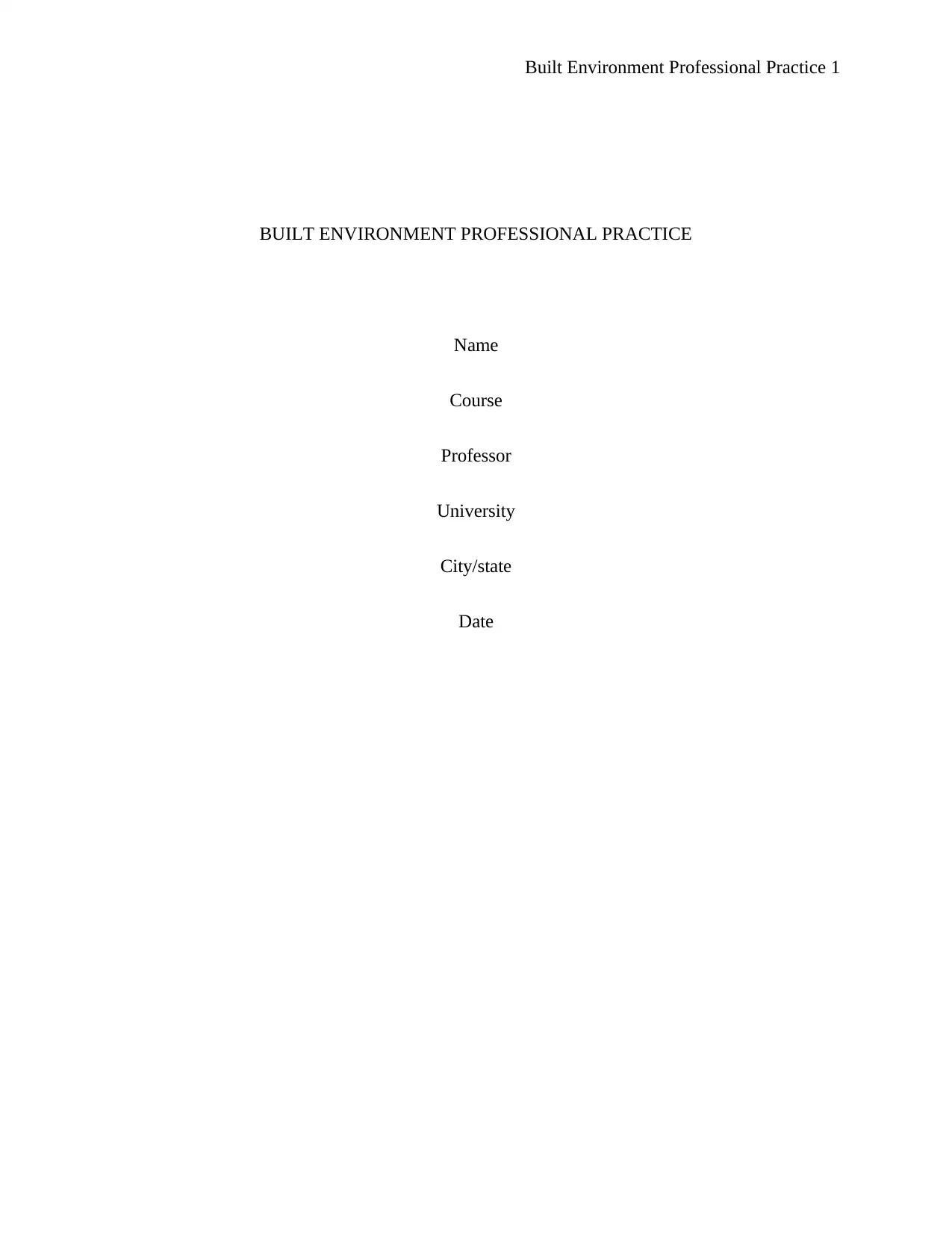
Built Environment Professional Practice 1
BUILT ENVIRONMENT PROFESSIONAL PRACTICE
Name
Course
Professor
University
City/state
Date
BUILT ENVIRONMENT PROFESSIONAL PRACTICE
Name
Course
Professor
University
City/state
Date
Secure Best Marks with AI Grader
Need help grading? Try our AI Grader for instant feedback on your assignments.
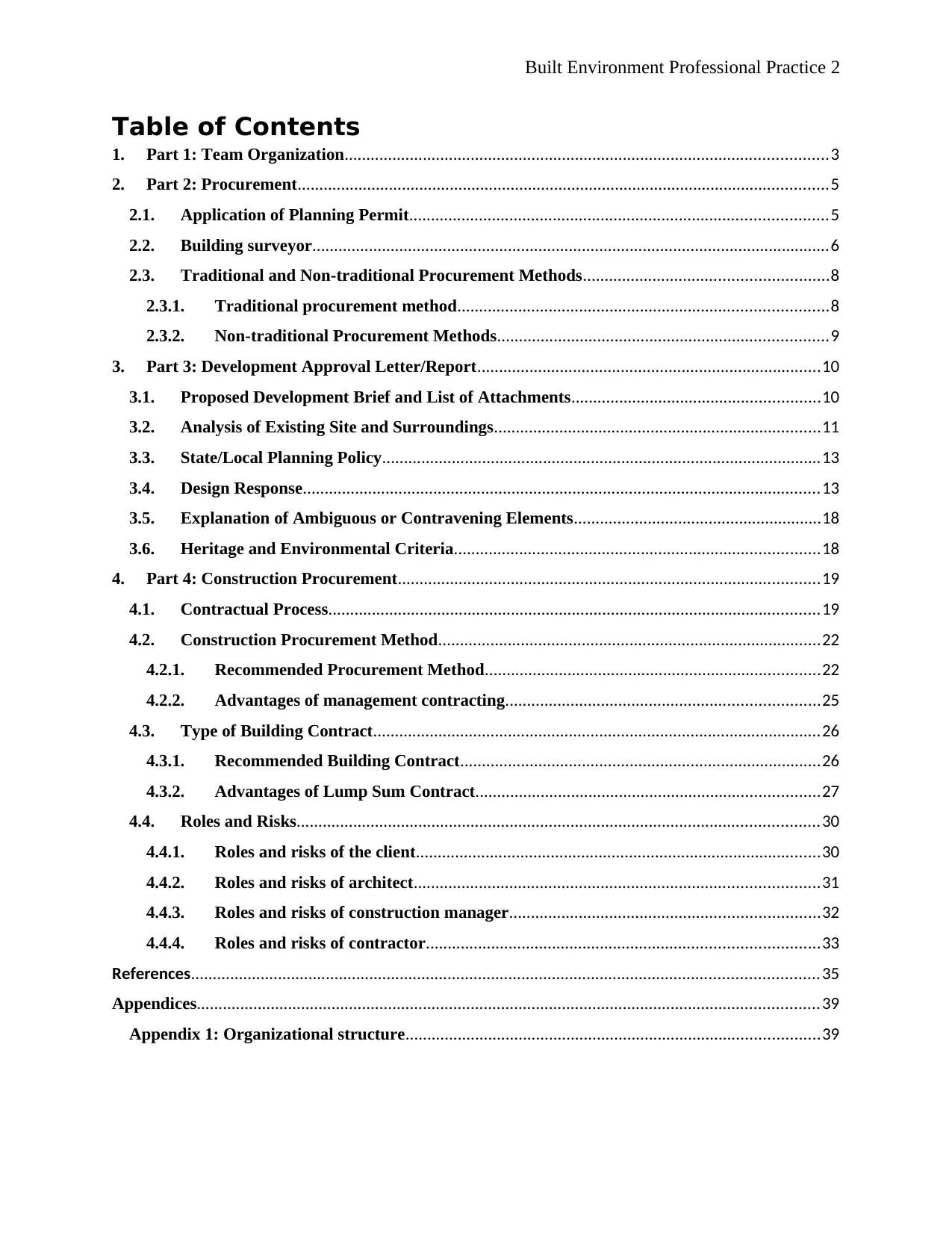
Built Environment Professional Practice 2
Table of Contents
1. Part 1: Team Organization...............................................................................................................3
2. Part 2: Procurement..........................................................................................................................5
2.1. Application of Planning Permit................................................................................................5
2.2. Building surveyor.......................................................................................................................6
2.3. Traditional and Non-traditional Procurement Methods........................................................8
2.3.1. Traditional procurement method.....................................................................................8
2.3.2. Non-traditional Procurement Methods............................................................................9
3. Part 3: Development Approval Letter/Report...............................................................................10
3.1. Proposed Development Brief and List of Attachments.........................................................10
3.2. Analysis of Existing Site and Surroundings...........................................................................11
3.3. State/Local Planning Policy.....................................................................................................13
3.4. Design Response.......................................................................................................................13
3.5. Explanation of Ambiguous or Contravening Elements.........................................................18
3.6. Heritage and Environmental Criteria....................................................................................18
4. Part 4: Construction Procurement.................................................................................................19
4.1. Contractual Process.................................................................................................................19
4.2. Construction Procurement Method........................................................................................22
4.2.1. Recommended Procurement Method.............................................................................22
4.2.2. Advantages of management contracting........................................................................25
4.3. Type of Building Contract.......................................................................................................26
4.3.1. Recommended Building Contract...................................................................................26
4.3.2. Advantages of Lump Sum Contract...............................................................................27
4.4. Roles and Risks........................................................................................................................30
4.4.1. Roles and risks of the client.............................................................................................30
4.4.2. Roles and risks of architect.............................................................................................31
4.4.3. Roles and risks of construction manager.......................................................................32
4.4.4. Roles and risks of contractor..........................................................................................33
References................................................................................................................................................35
Appendices...............................................................................................................................................39
Appendix 1: Organizational structure...............................................................................................39
Table of Contents
1. Part 1: Team Organization...............................................................................................................3
2. Part 2: Procurement..........................................................................................................................5
2.1. Application of Planning Permit................................................................................................5
2.2. Building surveyor.......................................................................................................................6
2.3. Traditional and Non-traditional Procurement Methods........................................................8
2.3.1. Traditional procurement method.....................................................................................8
2.3.2. Non-traditional Procurement Methods............................................................................9
3. Part 3: Development Approval Letter/Report...............................................................................10
3.1. Proposed Development Brief and List of Attachments.........................................................10
3.2. Analysis of Existing Site and Surroundings...........................................................................11
3.3. State/Local Planning Policy.....................................................................................................13
3.4. Design Response.......................................................................................................................13
3.5. Explanation of Ambiguous or Contravening Elements.........................................................18
3.6. Heritage and Environmental Criteria....................................................................................18
4. Part 4: Construction Procurement.................................................................................................19
4.1. Contractual Process.................................................................................................................19
4.2. Construction Procurement Method........................................................................................22
4.2.1. Recommended Procurement Method.............................................................................22
4.2.2. Advantages of management contracting........................................................................25
4.3. Type of Building Contract.......................................................................................................26
4.3.1. Recommended Building Contract...................................................................................26
4.3.2. Advantages of Lump Sum Contract...............................................................................27
4.4. Roles and Risks........................................................................................................................30
4.4.1. Roles and risks of the client.............................................................................................30
4.4.2. Roles and risks of architect.............................................................................................31
4.4.3. Roles and risks of construction manager.......................................................................32
4.4.4. Roles and risks of contractor..........................................................................................33
References................................................................................................................................................35
Appendices...............................................................................................................................................39
Appendix 1: Organizational structure...............................................................................................39
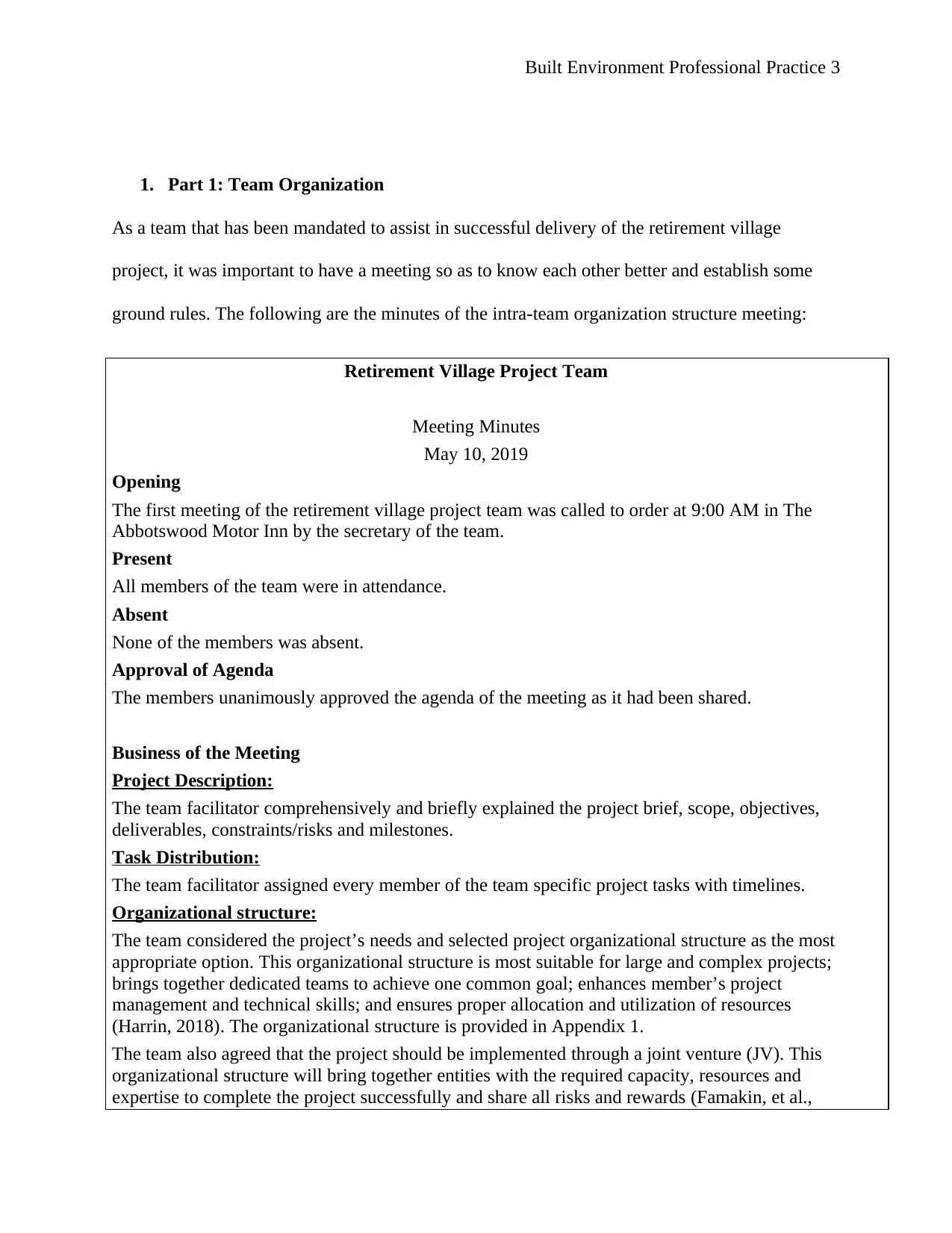
Built Environment Professional Practice 3
1. Part 1: Team Organization
As a team that has been mandated to assist in successful delivery of the retirement village
project, it was important to have a meeting so as to know each other better and establish some
ground rules. The following are the minutes of the intra-team organization structure meeting:
Retirement Village Project Team
Meeting Minutes
May 10, 2019
Opening
The first meeting of the retirement village project team was called to order at 9:00 AM in The
Abbotswood Motor Inn by the secretary of the team.
Present
All members of the team were in attendance.
Absent
None of the members was absent.
Approval of Agenda
The members unanimously approved the agenda of the meeting as it had been shared.
Business of the Meeting
Project Description:
The team facilitator comprehensively and briefly explained the project brief, scope, objectives,
deliverables, constraints/risks and milestones.
Task Distribution:
The team facilitator assigned every member of the team specific project tasks with timelines.
Organizational structure:
The team considered the project’s needs and selected project organizational structure as the most
appropriate option. This organizational structure is most suitable for large and complex projects;
brings together dedicated teams to achieve one common goal; enhances member’s project
management and technical skills; and ensures proper allocation and utilization of resources
(Harrin, 2018). The organizational structure is provided in Appendix 1.
The team also agreed that the project should be implemented through a joint venture (JV). This
organizational structure will bring together entities with the required capacity, resources and
expertise to complete the project successfully and share all risks and rewards (Famakin, et al.,
1. Part 1: Team Organization
As a team that has been mandated to assist in successful delivery of the retirement village
project, it was important to have a meeting so as to know each other better and establish some
ground rules. The following are the minutes of the intra-team organization structure meeting:
Retirement Village Project Team
Meeting Minutes
May 10, 2019
Opening
The first meeting of the retirement village project team was called to order at 9:00 AM in The
Abbotswood Motor Inn by the secretary of the team.
Present
All members of the team were in attendance.
Absent
None of the members was absent.
Approval of Agenda
The members unanimously approved the agenda of the meeting as it had been shared.
Business of the Meeting
Project Description:
The team facilitator comprehensively and briefly explained the project brief, scope, objectives,
deliverables, constraints/risks and milestones.
Task Distribution:
The team facilitator assigned every member of the team specific project tasks with timelines.
Organizational structure:
The team considered the project’s needs and selected project organizational structure as the most
appropriate option. This organizational structure is most suitable for large and complex projects;
brings together dedicated teams to achieve one common goal; enhances member’s project
management and technical skills; and ensures proper allocation and utilization of resources
(Harrin, 2018). The organizational structure is provided in Appendix 1.
The team also agreed that the project should be implemented through a joint venture (JV). This
organizational structure will bring together entities with the required capacity, resources and
expertise to complete the project successfully and share all risks and rewards (Famakin, et al.,
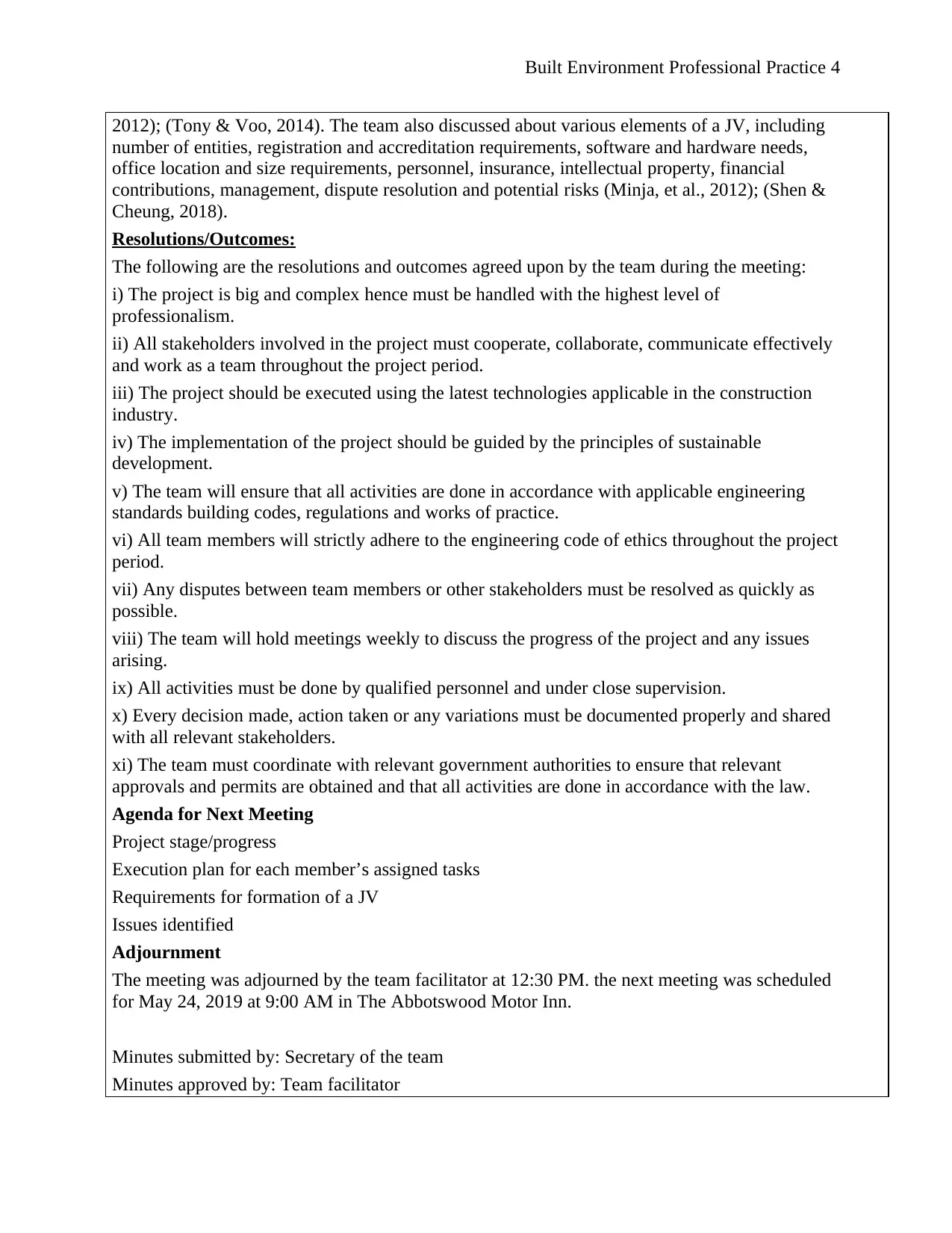
Built Environment Professional Practice 4
2012); (Tony & Voo, 2014). The team also discussed about various elements of a JV, including
number of entities, registration and accreditation requirements, software and hardware needs,
office location and size requirements, personnel, insurance, intellectual property, financial
contributions, management, dispute resolution and potential risks (Minja, et al., 2012); (Shen &
Cheung, 2018).
Resolutions/Outcomes:
The following are the resolutions and outcomes agreed upon by the team during the meeting:
i) The project is big and complex hence must be handled with the highest level of
professionalism.
ii) All stakeholders involved in the project must cooperate, collaborate, communicate effectively
and work as a team throughout the project period.
iii) The project should be executed using the latest technologies applicable in the construction
industry.
iv) The implementation of the project should be guided by the principles of sustainable
development.
v) The team will ensure that all activities are done in accordance with applicable engineering
standards building codes, regulations and works of practice.
vi) All team members will strictly adhere to the engineering code of ethics throughout the project
period.
vii) Any disputes between team members or other stakeholders must be resolved as quickly as
possible.
viii) The team will hold meetings weekly to discuss the progress of the project and any issues
arising.
ix) All activities must be done by qualified personnel and under close supervision.
x) Every decision made, action taken or any variations must be documented properly and shared
with all relevant stakeholders.
xi) The team must coordinate with relevant government authorities to ensure that relevant
approvals and permits are obtained and that all activities are done in accordance with the law.
Agenda for Next Meeting
Project stage/progress
Execution plan for each member’s assigned tasks
Requirements for formation of a JV
Issues identified
Adjournment
The meeting was adjourned by the team facilitator at 12:30 PM. the next meeting was scheduled
for May 24, 2019 at 9:00 AM in The Abbotswood Motor Inn.
Minutes submitted by: Secretary of the team
Minutes approved by: Team facilitator
2012); (Tony & Voo, 2014). The team also discussed about various elements of a JV, including
number of entities, registration and accreditation requirements, software and hardware needs,
office location and size requirements, personnel, insurance, intellectual property, financial
contributions, management, dispute resolution and potential risks (Minja, et al., 2012); (Shen &
Cheung, 2018).
Resolutions/Outcomes:
The following are the resolutions and outcomes agreed upon by the team during the meeting:
i) The project is big and complex hence must be handled with the highest level of
professionalism.
ii) All stakeholders involved in the project must cooperate, collaborate, communicate effectively
and work as a team throughout the project period.
iii) The project should be executed using the latest technologies applicable in the construction
industry.
iv) The implementation of the project should be guided by the principles of sustainable
development.
v) The team will ensure that all activities are done in accordance with applicable engineering
standards building codes, regulations and works of practice.
vi) All team members will strictly adhere to the engineering code of ethics throughout the project
period.
vii) Any disputes between team members or other stakeholders must be resolved as quickly as
possible.
viii) The team will hold meetings weekly to discuss the progress of the project and any issues
arising.
ix) All activities must be done by qualified personnel and under close supervision.
x) Every decision made, action taken or any variations must be documented properly and shared
with all relevant stakeholders.
xi) The team must coordinate with relevant government authorities to ensure that relevant
approvals and permits are obtained and that all activities are done in accordance with the law.
Agenda for Next Meeting
Project stage/progress
Execution plan for each member’s assigned tasks
Requirements for formation of a JV
Issues identified
Adjournment
The meeting was adjourned by the team facilitator at 12:30 PM. the next meeting was scheduled
for May 24, 2019 at 9:00 AM in The Abbotswood Motor Inn.
Minutes submitted by: Secretary of the team
Minutes approved by: Team facilitator
Paraphrase This Document
Need a fresh take? Get an instant paraphrase of this document with our AI Paraphraser

Built Environment Professional Practice 5
2. Part 2: Procurement
2.1. Application of Planning Permit
This project represents stage 6 & 7 of the larger retirement village development and a
planning permit must be obtained for the development of these stages to proceed. This means
that it is mandatory to apply for the planning permit as required by the relevant Australian
Standards including Building Regulations 2012, Building Act 2011, National Construction Code
(NCC) Building Code of Australia (BCA) and Planning and Environment Act 1987. The main
requirements for a planning permit include: site plans, elevation drawings and a written report.
The general procedure of applying for a planning permit is as follows:
Pre-preparation: it is important to find out more information about planning schemes
from Greater Geelong Council; discuss the proposal with the planning department of
Geelong Council (council planner) to be advised about the additional information that
must be provided when lodging the planning permit and the procedure for processing the
application; talk to the neighboring residents that may be affected by the project so as to
understand their concerns; and find a professional advisor for guidance (Victoria State
Government, 2018).
Preparing the application: this entails gathering the information that is required, filling
the planning permit application forms, and attaching relevant files. As aforementioned,
some of the requirements include: sketches, drawings (site plans, floor plans, elevations
and sections), photographs and a written report about different elements of the project
such as project description, estimated project cost, title information, owner’s consent,
impacts of the project (environmental, social and economic impacts), existing land use,
consistency or relevance of the proposed development to the natural setting,
2. Part 2: Procurement
2.1. Application of Planning Permit
This project represents stage 6 & 7 of the larger retirement village development and a
planning permit must be obtained for the development of these stages to proceed. This means
that it is mandatory to apply for the planning permit as required by the relevant Australian
Standards including Building Regulations 2012, Building Act 2011, National Construction Code
(NCC) Building Code of Australia (BCA) and Planning and Environment Act 1987. The main
requirements for a planning permit include: site plans, elevation drawings and a written report.
The general procedure of applying for a planning permit is as follows:
Pre-preparation: it is important to find out more information about planning schemes
from Greater Geelong Council; discuss the proposal with the planning department of
Geelong Council (council planner) to be advised about the additional information that
must be provided when lodging the planning permit and the procedure for processing the
application; talk to the neighboring residents that may be affected by the project so as to
understand their concerns; and find a professional advisor for guidance (Victoria State
Government, 2018).
Preparing the application: this entails gathering the information that is required, filling
the planning permit application forms, and attaching relevant files. As aforementioned,
some of the requirements include: sketches, drawings (site plans, floor plans, elevations
and sections), photographs and a written report about different elements of the project
such as project description, estimated project cost, title information, owner’s consent,
impacts of the project (environmental, social and economic impacts), existing land use,
consistency or relevance of the proposed development to the natural setting,
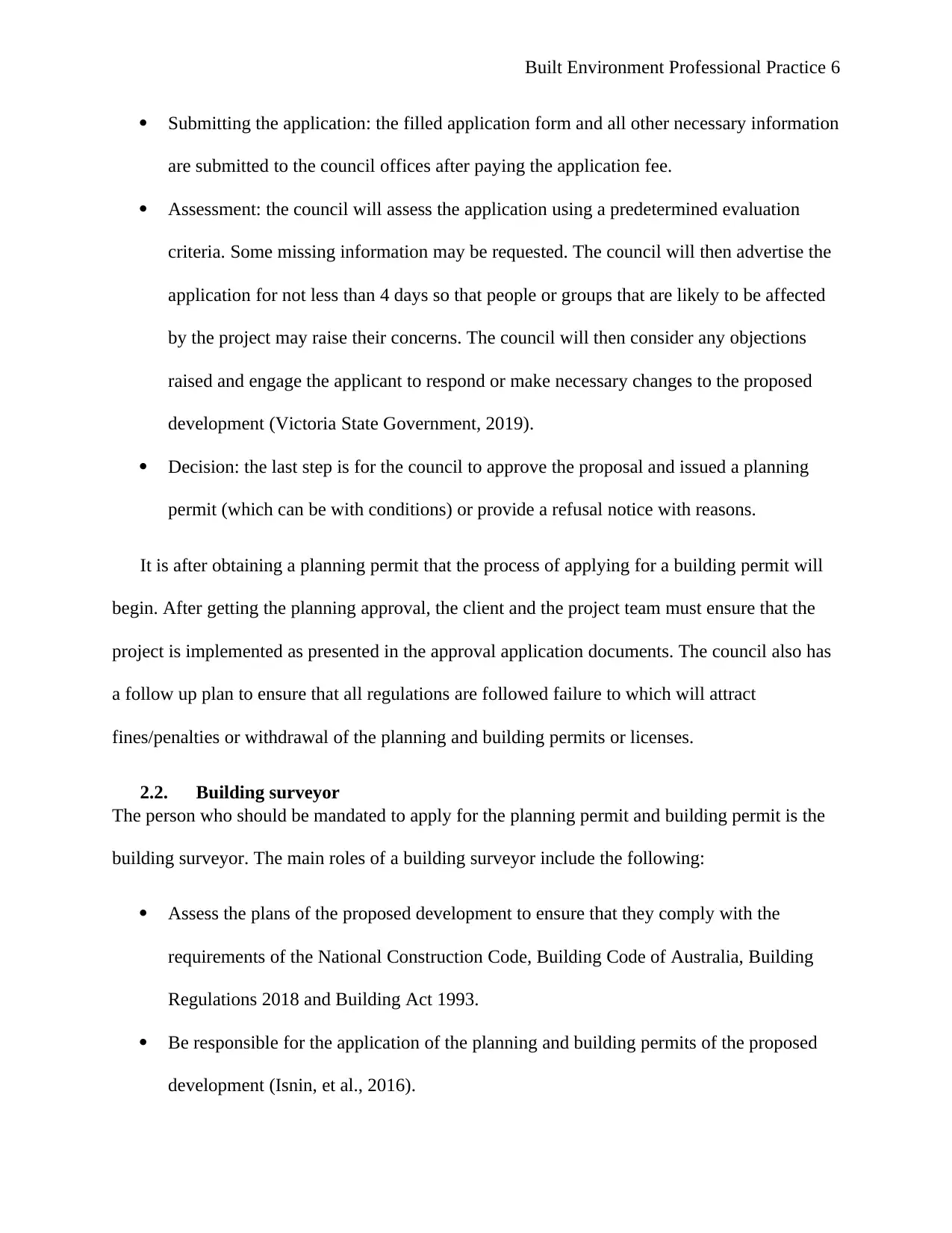
Built Environment Professional Practice 6
Submitting the application: the filled application form and all other necessary information
are submitted to the council offices after paying the application fee.
Assessment: the council will assess the application using a predetermined evaluation
criteria. Some missing information may be requested. The council will then advertise the
application for not less than 4 days so that people or groups that are likely to be affected
by the project may raise their concerns. The council will then consider any objections
raised and engage the applicant to respond or make necessary changes to the proposed
development (Victoria State Government, 2019).
Decision: the last step is for the council to approve the proposal and issued a planning
permit (which can be with conditions) or provide a refusal notice with reasons.
It is after obtaining a planning permit that the process of applying for a building permit will
begin. After getting the planning approval, the client and the project team must ensure that the
project is implemented as presented in the approval application documents. The council also has
a follow up plan to ensure that all regulations are followed failure to which will attract
fines/penalties or withdrawal of the planning and building permits or licenses.
2.2. Building surveyor
The person who should be mandated to apply for the planning permit and building permit is the
building surveyor. The main roles of a building surveyor include the following:
Assess the plans of the proposed development to ensure that they comply with the
requirements of the National Construction Code, Building Code of Australia, Building
Regulations 2018 and Building Act 1993.
Be responsible for the application of the planning and building permits of the proposed
development (Isnin, et al., 2016).
Submitting the application: the filled application form and all other necessary information
are submitted to the council offices after paying the application fee.
Assessment: the council will assess the application using a predetermined evaluation
criteria. Some missing information may be requested. The council will then advertise the
application for not less than 4 days so that people or groups that are likely to be affected
by the project may raise their concerns. The council will then consider any objections
raised and engage the applicant to respond or make necessary changes to the proposed
development (Victoria State Government, 2019).
Decision: the last step is for the council to approve the proposal and issued a planning
permit (which can be with conditions) or provide a refusal notice with reasons.
It is after obtaining a planning permit that the process of applying for a building permit will
begin. After getting the planning approval, the client and the project team must ensure that the
project is implemented as presented in the approval application documents. The council also has
a follow up plan to ensure that all regulations are followed failure to which will attract
fines/penalties or withdrawal of the planning and building permits or licenses.
2.2. Building surveyor
The person who should be mandated to apply for the planning permit and building permit is the
building surveyor. The main roles of a building surveyor include the following:
Assess the plans of the proposed development to ensure that they comply with the
requirements of the National Construction Code, Building Code of Australia, Building
Regulations 2018 and Building Act 1993.
Be responsible for the application of the planning and building permits of the proposed
development (Isnin, et al., 2016).
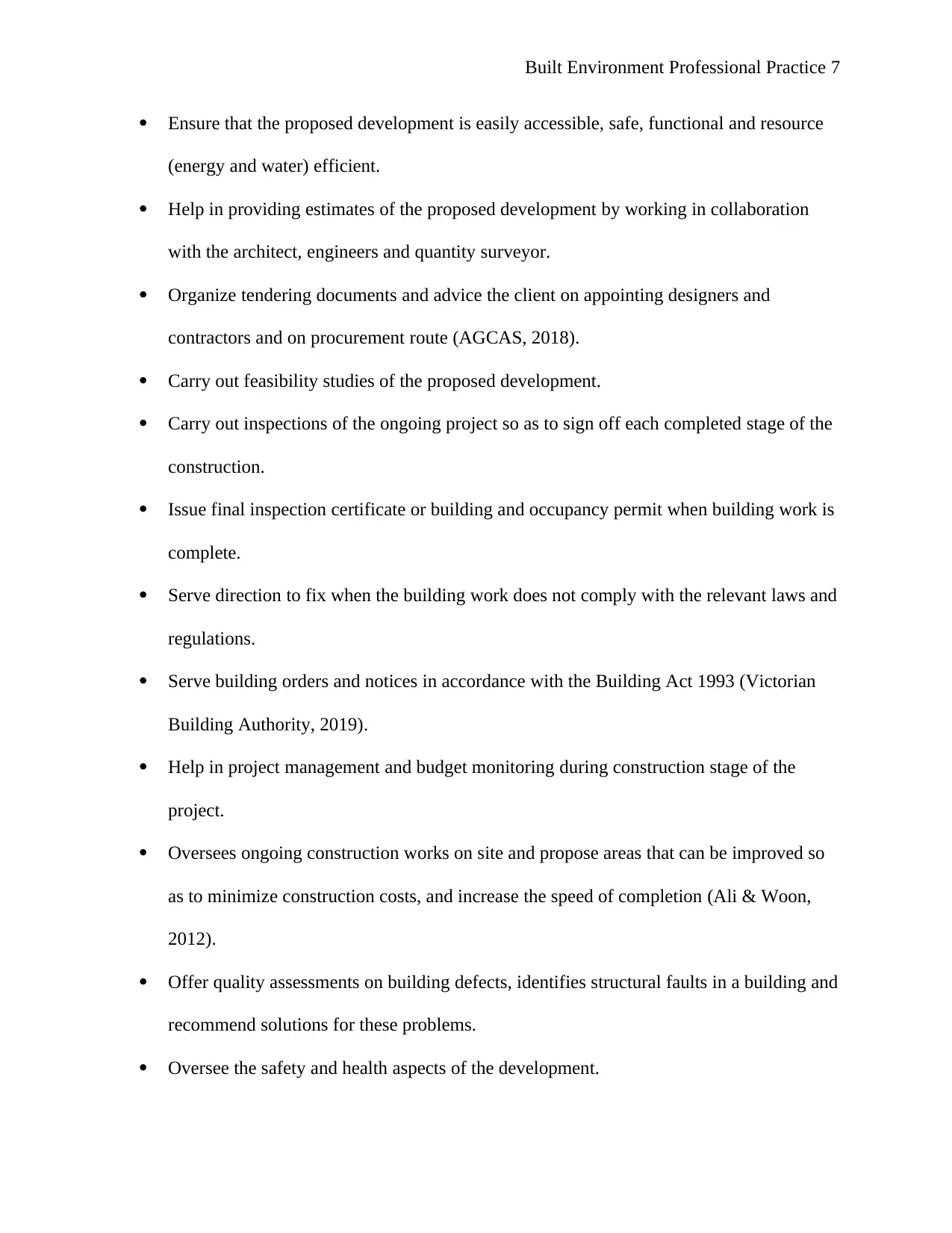
Built Environment Professional Practice 7
Ensure that the proposed development is easily accessible, safe, functional and resource
(energy and water) efficient.
Help in providing estimates of the proposed development by working in collaboration
with the architect, engineers and quantity surveyor.
Organize tendering documents and advice the client on appointing designers and
contractors and on procurement route (AGCAS, 2018).
Carry out feasibility studies of the proposed development.
Carry out inspections of the ongoing project so as to sign off each completed stage of the
construction.
Issue final inspection certificate or building and occupancy permit when building work is
complete.
Serve direction to fix when the building work does not comply with the relevant laws and
regulations.
Serve building orders and notices in accordance with the Building Act 1993 (Victorian
Building Authority, 2019).
Help in project management and budget monitoring during construction stage of the
project.
Oversees ongoing construction works on site and propose areas that can be improved so
as to minimize construction costs, and increase the speed of completion (Ali & Woon,
2012).
Offer quality assessments on building defects, identifies structural faults in a building and
recommend solutions for these problems.
Oversee the safety and health aspects of the development.
Ensure that the proposed development is easily accessible, safe, functional and resource
(energy and water) efficient.
Help in providing estimates of the proposed development by working in collaboration
with the architect, engineers and quantity surveyor.
Organize tendering documents and advice the client on appointing designers and
contractors and on procurement route (AGCAS, 2018).
Carry out feasibility studies of the proposed development.
Carry out inspections of the ongoing project so as to sign off each completed stage of the
construction.
Issue final inspection certificate or building and occupancy permit when building work is
complete.
Serve direction to fix when the building work does not comply with the relevant laws and
regulations.
Serve building orders and notices in accordance with the Building Act 1993 (Victorian
Building Authority, 2019).
Help in project management and budget monitoring during construction stage of the
project.
Oversees ongoing construction works on site and propose areas that can be improved so
as to minimize construction costs, and increase the speed of completion (Ali & Woon,
2012).
Offer quality assessments on building defects, identifies structural faults in a building and
recommend solutions for these problems.
Oversee the safety and health aspects of the development.
Secure Best Marks with AI Grader
Need help grading? Try our AI Grader for instant feedback on your assignments.
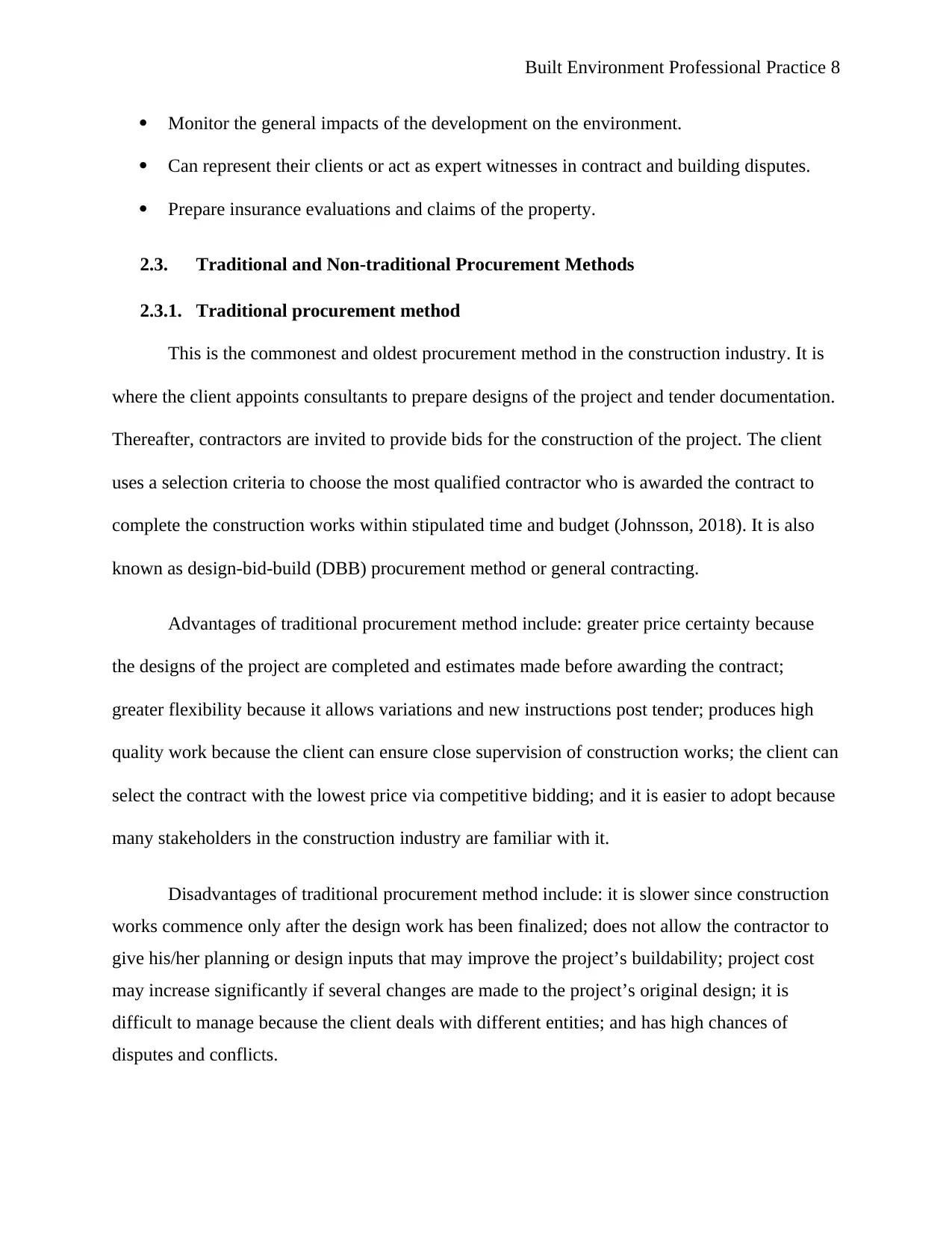
Built Environment Professional Practice 8
Monitor the general impacts of the development on the environment.
Can represent their clients or act as expert witnesses in contract and building disputes.
Prepare insurance evaluations and claims of the property.
2.3. Traditional and Non-traditional Procurement Methods
2.3.1. Traditional procurement method
This is the commonest and oldest procurement method in the construction industry. It is
where the client appoints consultants to prepare designs of the project and tender documentation.
Thereafter, contractors are invited to provide bids for the construction of the project. The client
uses a selection criteria to choose the most qualified contractor who is awarded the contract to
complete the construction works within stipulated time and budget (Johnsson, 2018). It is also
known as design-bid-build (DBB) procurement method or general contracting.
Advantages of traditional procurement method include: greater price certainty because
the designs of the project are completed and estimates made before awarding the contract;
greater flexibility because it allows variations and new instructions post tender; produces high
quality work because the client can ensure close supervision of construction works; the client can
select the contract with the lowest price via competitive bidding; and it is easier to adopt because
many stakeholders in the construction industry are familiar with it.
Disadvantages of traditional procurement method include: it is slower since construction
works commence only after the design work has been finalized; does not allow the contractor to
give his/her planning or design inputs that may improve the project’s buildability; project cost
may increase significantly if several changes are made to the project’s original design; it is
difficult to manage because the client deals with different entities; and has high chances of
disputes and conflicts.
Monitor the general impacts of the development on the environment.
Can represent their clients or act as expert witnesses in contract and building disputes.
Prepare insurance evaluations and claims of the property.
2.3. Traditional and Non-traditional Procurement Methods
2.3.1. Traditional procurement method
This is the commonest and oldest procurement method in the construction industry. It is
where the client appoints consultants to prepare designs of the project and tender documentation.
Thereafter, contractors are invited to provide bids for the construction of the project. The client
uses a selection criteria to choose the most qualified contractor who is awarded the contract to
complete the construction works within stipulated time and budget (Johnsson, 2018). It is also
known as design-bid-build (DBB) procurement method or general contracting.
Advantages of traditional procurement method include: greater price certainty because
the designs of the project are completed and estimates made before awarding the contract;
greater flexibility because it allows variations and new instructions post tender; produces high
quality work because the client can ensure close supervision of construction works; the client can
select the contract with the lowest price via competitive bidding; and it is easier to adopt because
many stakeholders in the construction industry are familiar with it.
Disadvantages of traditional procurement method include: it is slower since construction
works commence only after the design work has been finalized; does not allow the contractor to
give his/her planning or design inputs that may improve the project’s buildability; project cost
may increase significantly if several changes are made to the project’s original design; it is
difficult to manage because the client deals with different entities; and has high chances of
disputes and conflicts.
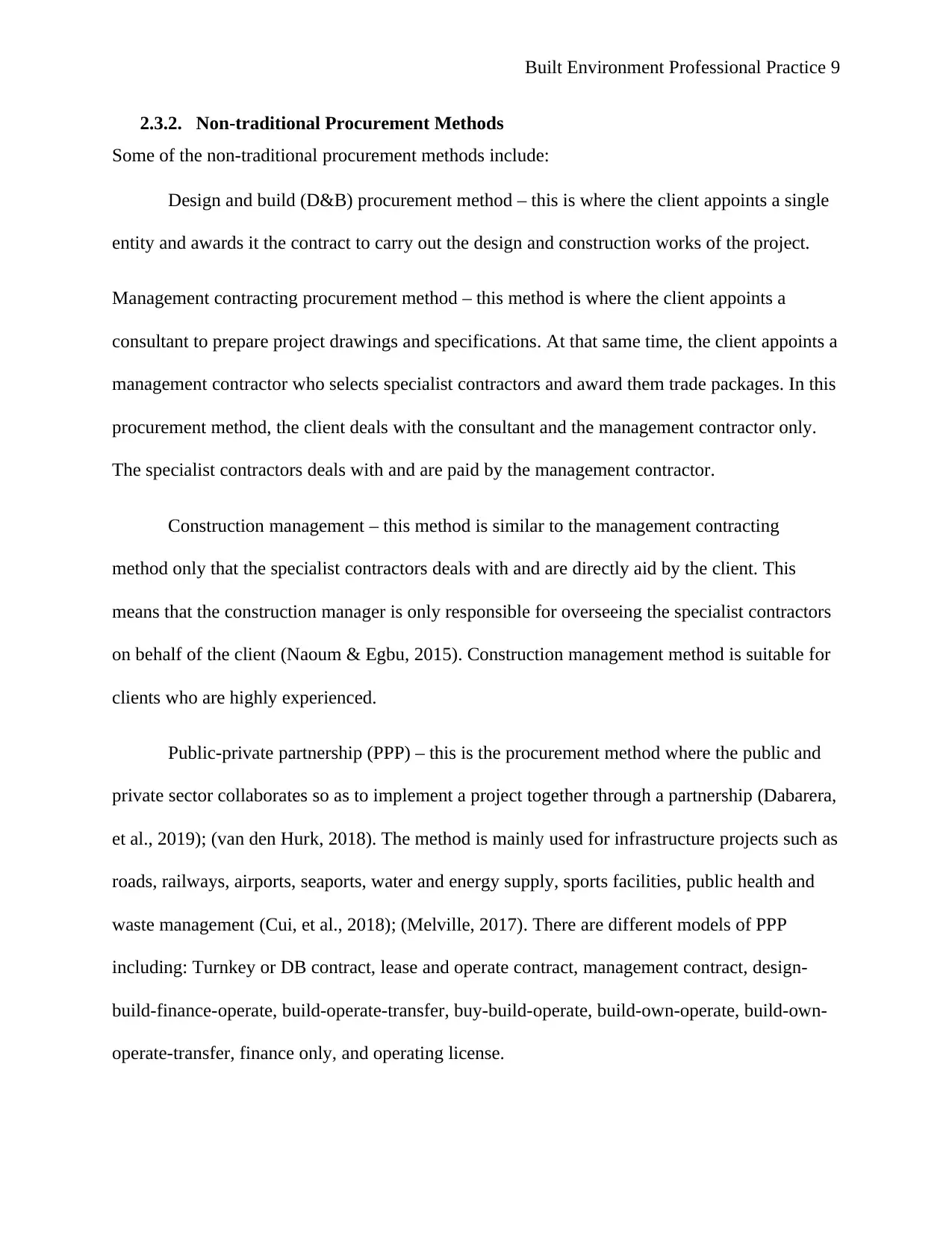
Built Environment Professional Practice 9
2.3.2. Non-traditional Procurement Methods
Some of the non-traditional procurement methods include:
Design and build (D&B) procurement method – this is where the client appoints a single
entity and awards it the contract to carry out the design and construction works of the project.
Management contracting procurement method – this method is where the client appoints a
consultant to prepare project drawings and specifications. At that same time, the client appoints a
management contractor who selects specialist contractors and award them trade packages. In this
procurement method, the client deals with the consultant and the management contractor only.
The specialist contractors deals with and are paid by the management contractor.
Construction management – this method is similar to the management contracting
method only that the specialist contractors deals with and are directly aid by the client. This
means that the construction manager is only responsible for overseeing the specialist contractors
on behalf of the client (Naoum & Egbu, 2015). Construction management method is suitable for
clients who are highly experienced.
Public-private partnership (PPP) – this is the procurement method where the public and
private sector collaborates so as to implement a project together through a partnership (Dabarera,
et al., 2019); (van den Hurk, 2018). The method is mainly used for infrastructure projects such as
roads, railways, airports, seaports, water and energy supply, sports facilities, public health and
waste management (Cui, et al., 2018); (Melville, 2017). There are different models of PPP
including: Turnkey or DB contract, lease and operate contract, management contract, design-
build-finance-operate, build-operate-transfer, buy-build-operate, build-own-operate, build-own-
operate-transfer, finance only, and operating license.
2.3.2. Non-traditional Procurement Methods
Some of the non-traditional procurement methods include:
Design and build (D&B) procurement method – this is where the client appoints a single
entity and awards it the contract to carry out the design and construction works of the project.
Management contracting procurement method – this method is where the client appoints a
consultant to prepare project drawings and specifications. At that same time, the client appoints a
management contractor who selects specialist contractors and award them trade packages. In this
procurement method, the client deals with the consultant and the management contractor only.
The specialist contractors deals with and are paid by the management contractor.
Construction management – this method is similar to the management contracting
method only that the specialist contractors deals with and are directly aid by the client. This
means that the construction manager is only responsible for overseeing the specialist contractors
on behalf of the client (Naoum & Egbu, 2015). Construction management method is suitable for
clients who are highly experienced.
Public-private partnership (PPP) – this is the procurement method where the public and
private sector collaborates so as to implement a project together through a partnership (Dabarera,
et al., 2019); (van den Hurk, 2018). The method is mainly used for infrastructure projects such as
roads, railways, airports, seaports, water and energy supply, sports facilities, public health and
waste management (Cui, et al., 2018); (Melville, 2017). There are different models of PPP
including: Turnkey or DB contract, lease and operate contract, management contract, design-
build-finance-operate, build-operate-transfer, buy-build-operate, build-own-operate, build-own-
operate-transfer, finance only, and operating license.
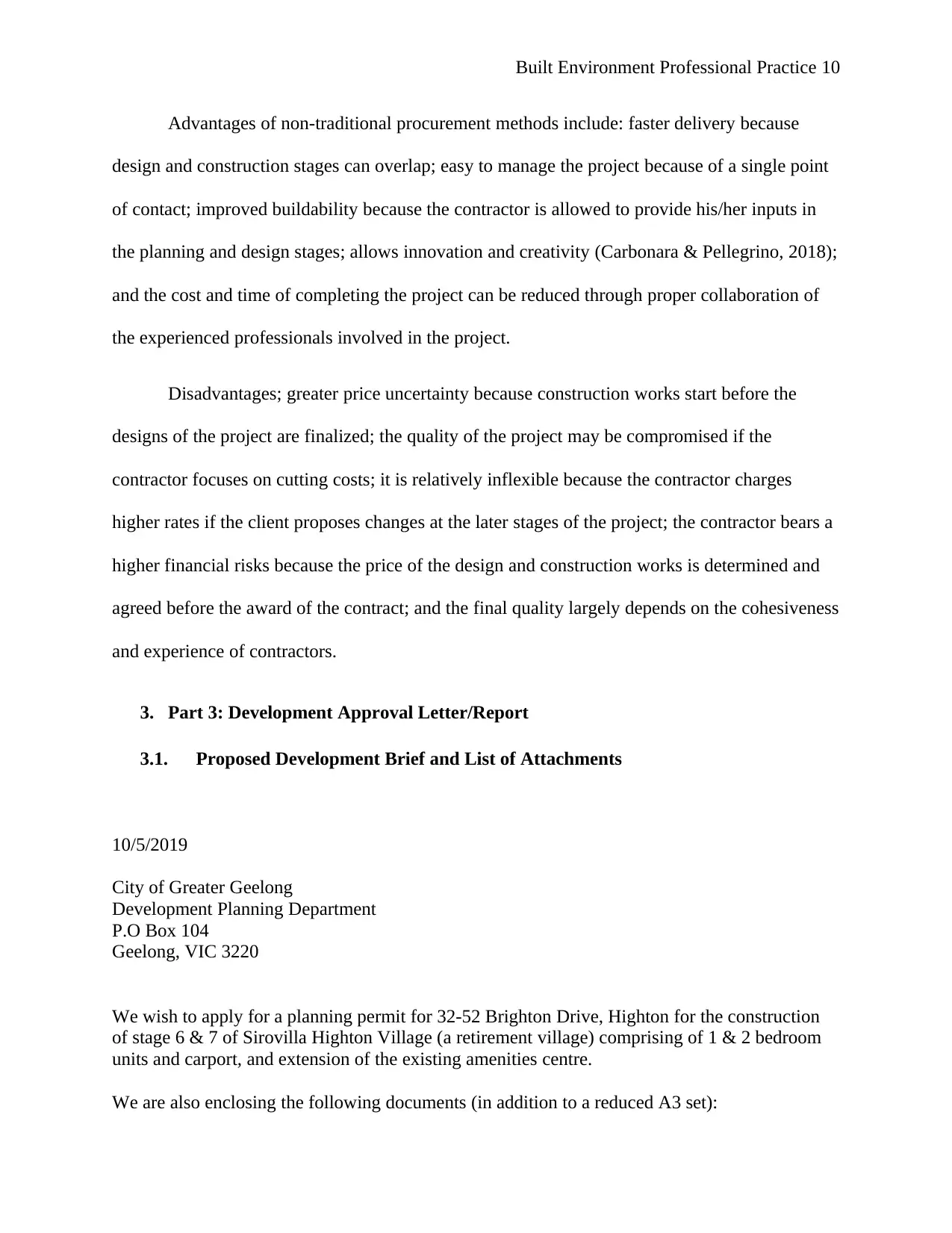
Built Environment Professional Practice 10
Advantages of non-traditional procurement methods include: faster delivery because
design and construction stages can overlap; easy to manage the project because of a single point
of contact; improved buildability because the contractor is allowed to provide his/her inputs in
the planning and design stages; allows innovation and creativity (Carbonara & Pellegrino, 2018);
and the cost and time of completing the project can be reduced through proper collaboration of
the experienced professionals involved in the project.
Disadvantages; greater price uncertainty because construction works start before the
designs of the project are finalized; the quality of the project may be compromised if the
contractor focuses on cutting costs; it is relatively inflexible because the contractor charges
higher rates if the client proposes changes at the later stages of the project; the contractor bears a
higher financial risks because the price of the design and construction works is determined and
agreed before the award of the contract; and the final quality largely depends on the cohesiveness
and experience of contractors.
3. Part 3: Development Approval Letter/Report
3.1. Proposed Development Brief and List of Attachments
10/5/2019
City of Greater Geelong
Development Planning Department
P.O Box 104
Geelong, VIC 3220
We wish to apply for a planning permit for 32-52 Brighton Drive, Highton for the construction
of stage 6 & 7 of Sirovilla Highton Village (a retirement village) comprising of 1 & 2 bedroom
units and carport, and extension of the existing amenities centre.
We are also enclosing the following documents (in addition to a reduced A3 set):
Advantages of non-traditional procurement methods include: faster delivery because
design and construction stages can overlap; easy to manage the project because of a single point
of contact; improved buildability because the contractor is allowed to provide his/her inputs in
the planning and design stages; allows innovation and creativity (Carbonara & Pellegrino, 2018);
and the cost and time of completing the project can be reduced through proper collaboration of
the experienced professionals involved in the project.
Disadvantages; greater price uncertainty because construction works start before the
designs of the project are finalized; the quality of the project may be compromised if the
contractor focuses on cutting costs; it is relatively inflexible because the contractor charges
higher rates if the client proposes changes at the later stages of the project; the contractor bears a
higher financial risks because the price of the design and construction works is determined and
agreed before the award of the contract; and the final quality largely depends on the cohesiveness
and experience of contractors.
3. Part 3: Development Approval Letter/Report
3.1. Proposed Development Brief and List of Attachments
10/5/2019
City of Greater Geelong
Development Planning Department
P.O Box 104
Geelong, VIC 3220
We wish to apply for a planning permit for 32-52 Brighton Drive, Highton for the construction
of stage 6 & 7 of Sirovilla Highton Village (a retirement village) comprising of 1 & 2 bedroom
units and carport, and extension of the existing amenities centre.
We are also enclosing the following documents (in addition to a reduced A3 set):
Paraphrase This Document
Need a fresh take? Get an instant paraphrase of this document with our AI Paraphraser
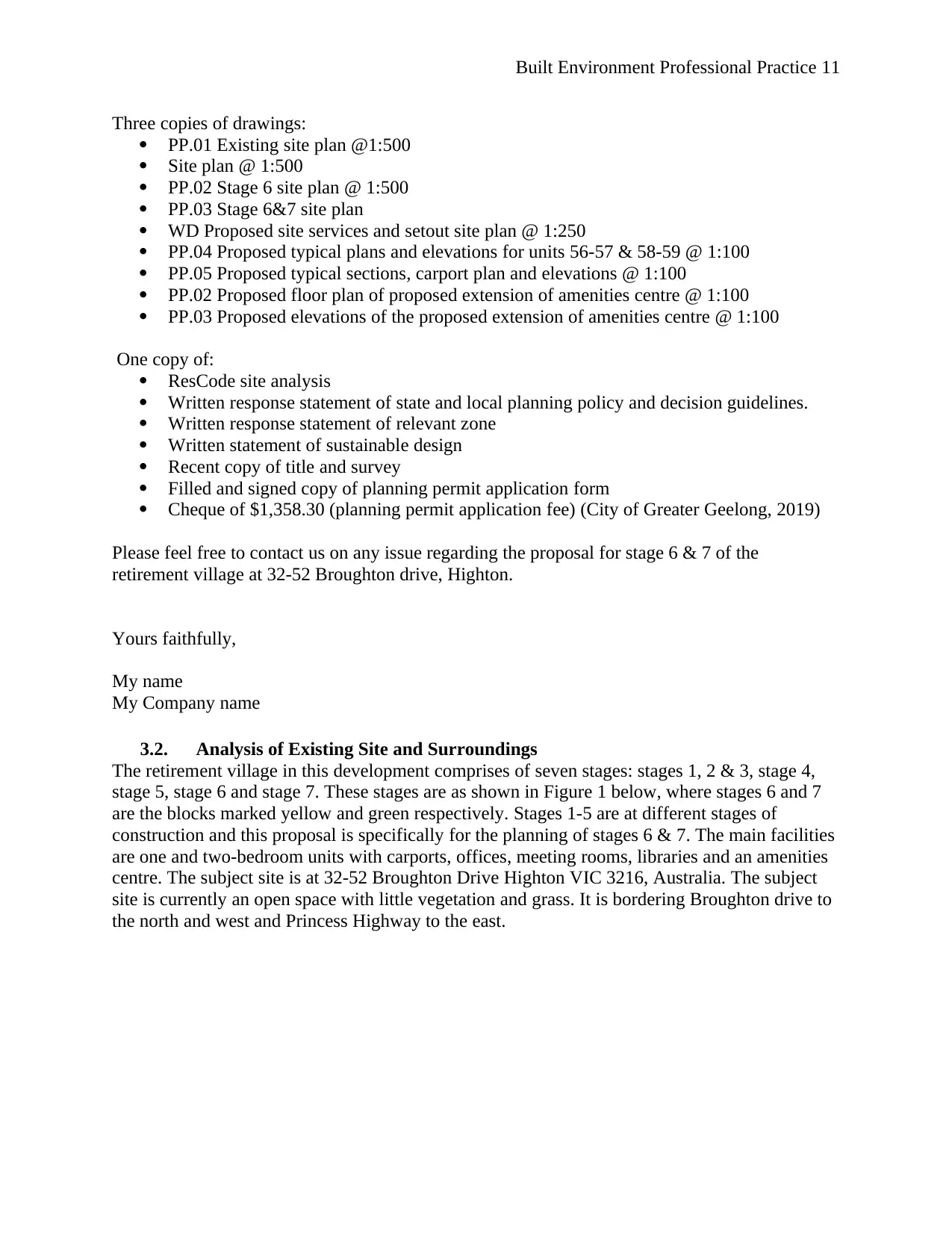
Built Environment Professional Practice 11
Three copies of drawings:
PP.01 Existing site plan @1:500
Site plan @ 1:500
PP.02 Stage 6 site plan @ 1:500
PP.03 Stage 6&7 site plan
WD Proposed site services and setout site plan @ 1:250
PP.04 Proposed typical plans and elevations for units 56-57 & 58-59 @ 1:100
PP.05 Proposed typical sections, carport plan and elevations @ 1:100
PP.02 Proposed floor plan of proposed extension of amenities centre @ 1:100
PP.03 Proposed elevations of the proposed extension of amenities centre @ 1:100
One copy of:
ResCode site analysis
Written response statement of state and local planning policy and decision guidelines.
Written response statement of relevant zone
Written statement of sustainable design
Recent copy of title and survey
Filled and signed copy of planning permit application form
Cheque of $1,358.30 (planning permit application fee) (City of Greater Geelong, 2019)
Please feel free to contact us on any issue regarding the proposal for stage 6 & 7 of the
retirement village at 32-52 Broughton drive, Highton.
Yours faithfully,
My name
My Company name
3.2. Analysis of Existing Site and Surroundings
The retirement village in this development comprises of seven stages: stages 1, 2 & 3, stage 4,
stage 5, stage 6 and stage 7. These stages are as shown in Figure 1 below, where stages 6 and 7
are the blocks marked yellow and green respectively. Stages 1-5 are at different stages of
construction and this proposal is specifically for the planning of stages 6 & 7. The main facilities
are one and two-bedroom units with carports, offices, meeting rooms, libraries and an amenities
centre. The subject site is at 32-52 Broughton Drive Highton VIC 3216, Australia. The subject
site is currently an open space with little vegetation and grass. It is bordering Broughton drive to
the north and west and Princess Highway to the east.
Three copies of drawings:
PP.01 Existing site plan @1:500
Site plan @ 1:500
PP.02 Stage 6 site plan @ 1:500
PP.03 Stage 6&7 site plan
WD Proposed site services and setout site plan @ 1:250
PP.04 Proposed typical plans and elevations for units 56-57 & 58-59 @ 1:100
PP.05 Proposed typical sections, carport plan and elevations @ 1:100
PP.02 Proposed floor plan of proposed extension of amenities centre @ 1:100
PP.03 Proposed elevations of the proposed extension of amenities centre @ 1:100
One copy of:
ResCode site analysis
Written response statement of state and local planning policy and decision guidelines.
Written response statement of relevant zone
Written statement of sustainable design
Recent copy of title and survey
Filled and signed copy of planning permit application form
Cheque of $1,358.30 (planning permit application fee) (City of Greater Geelong, 2019)
Please feel free to contact us on any issue regarding the proposal for stage 6 & 7 of the
retirement village at 32-52 Broughton drive, Highton.
Yours faithfully,
My name
My Company name
3.2. Analysis of Existing Site and Surroundings
The retirement village in this development comprises of seven stages: stages 1, 2 & 3, stage 4,
stage 5, stage 6 and stage 7. These stages are as shown in Figure 1 below, where stages 6 and 7
are the blocks marked yellow and green respectively. Stages 1-5 are at different stages of
construction and this proposal is specifically for the planning of stages 6 & 7. The main facilities
are one and two-bedroom units with carports, offices, meeting rooms, libraries and an amenities
centre. The subject site is at 32-52 Broughton Drive Highton VIC 3216, Australia. The subject
site is currently an open space with little vegetation and grass. It is bordering Broughton drive to
the north and west and Princess Highway to the east.
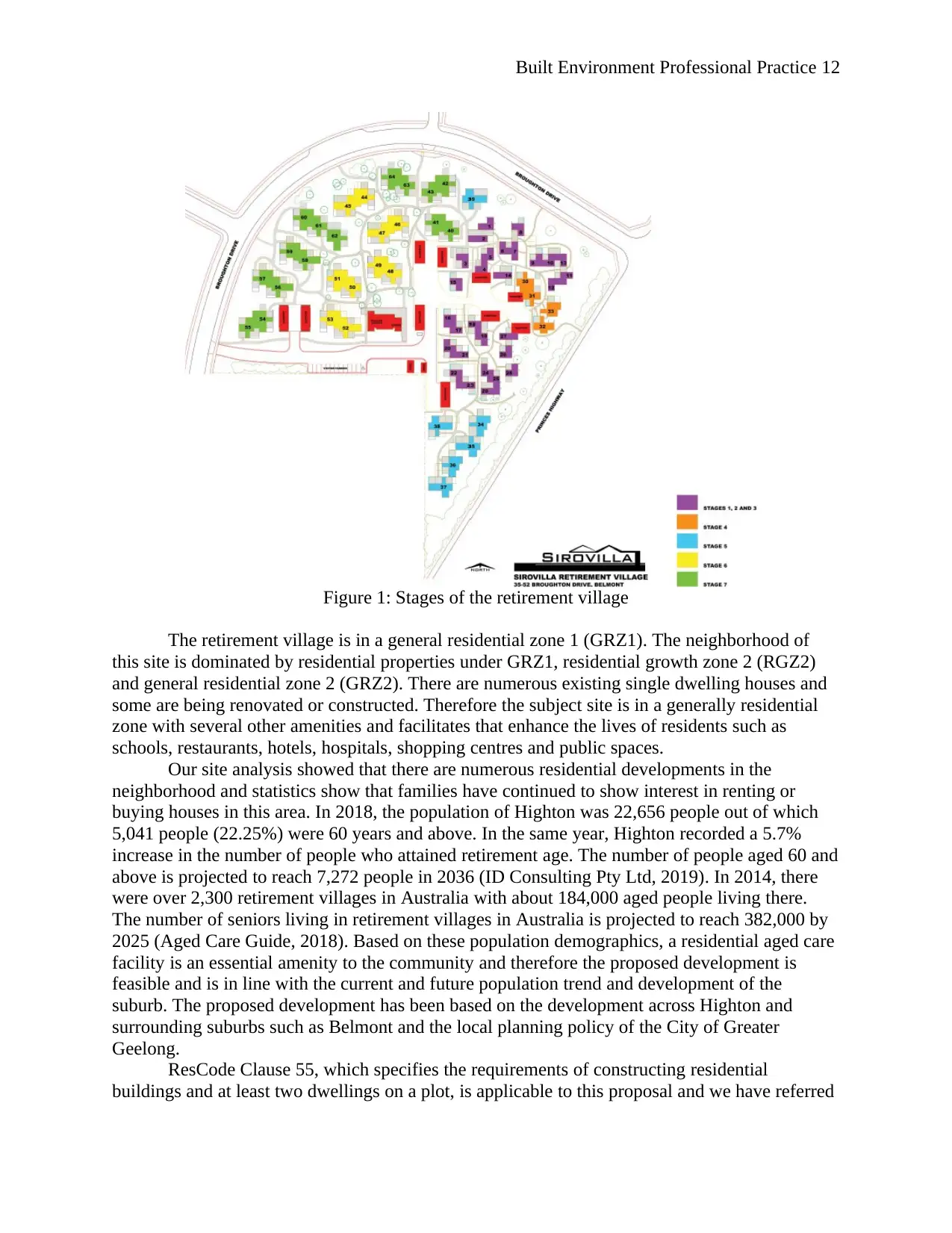
Built Environment Professional Practice 12
Figure 1: Stages of the retirement village
The retirement village is in a general residential zone 1 (GRZ1). The neighborhood of
this site is dominated by residential properties under GRZ1, residential growth zone 2 (RGZ2)
and general residential zone 2 (GRZ2). There are numerous existing single dwelling houses and
some are being renovated or constructed. Therefore the subject site is in a generally residential
zone with several other amenities and facilitates that enhance the lives of residents such as
schools, restaurants, hotels, hospitals, shopping centres and public spaces.
Our site analysis showed that there are numerous residential developments in the
neighborhood and statistics show that families have continued to show interest in renting or
buying houses in this area. In 2018, the population of Highton was 22,656 people out of which
5,041 people (22.25%) were 60 years and above. In the same year, Highton recorded a 5.7%
increase in the number of people who attained retirement age. The number of people aged 60 and
above is projected to reach 7,272 people in 2036 (ID Consulting Pty Ltd, 2019). In 2014, there
were over 2,300 retirement villages in Australia with about 184,000 aged people living there.
The number of seniors living in retirement villages in Australia is projected to reach 382,000 by
2025 (Aged Care Guide, 2018). Based on these population demographics, a residential aged care
facility is an essential amenity to the community and therefore the proposed development is
feasible and is in line with the current and future population trend and development of the
suburb. The proposed development has been based on the development across Highton and
surrounding suburbs such as Belmont and the local planning policy of the City of Greater
Geelong.
ResCode Clause 55, which specifies the requirements of constructing residential
buildings and at least two dwellings on a plot, is applicable to this proposal and we have referred
Figure 1: Stages of the retirement village
The retirement village is in a general residential zone 1 (GRZ1). The neighborhood of
this site is dominated by residential properties under GRZ1, residential growth zone 2 (RGZ2)
and general residential zone 2 (GRZ2). There are numerous existing single dwelling houses and
some are being renovated or constructed. Therefore the subject site is in a generally residential
zone with several other amenities and facilitates that enhance the lives of residents such as
schools, restaurants, hotels, hospitals, shopping centres and public spaces.
Our site analysis showed that there are numerous residential developments in the
neighborhood and statistics show that families have continued to show interest in renting or
buying houses in this area. In 2018, the population of Highton was 22,656 people out of which
5,041 people (22.25%) were 60 years and above. In the same year, Highton recorded a 5.7%
increase in the number of people who attained retirement age. The number of people aged 60 and
above is projected to reach 7,272 people in 2036 (ID Consulting Pty Ltd, 2019). In 2014, there
were over 2,300 retirement villages in Australia with about 184,000 aged people living there.
The number of seniors living in retirement villages in Australia is projected to reach 382,000 by
2025 (Aged Care Guide, 2018). Based on these population demographics, a residential aged care
facility is an essential amenity to the community and therefore the proposed development is
feasible and is in line with the current and future population trend and development of the
suburb. The proposed development has been based on the development across Highton and
surrounding suburbs such as Belmont and the local planning policy of the City of Greater
Geelong.
ResCode Clause 55, which specifies the requirements of constructing residential
buildings and at least two dwellings on a plot, is applicable to this proposal and we have referred
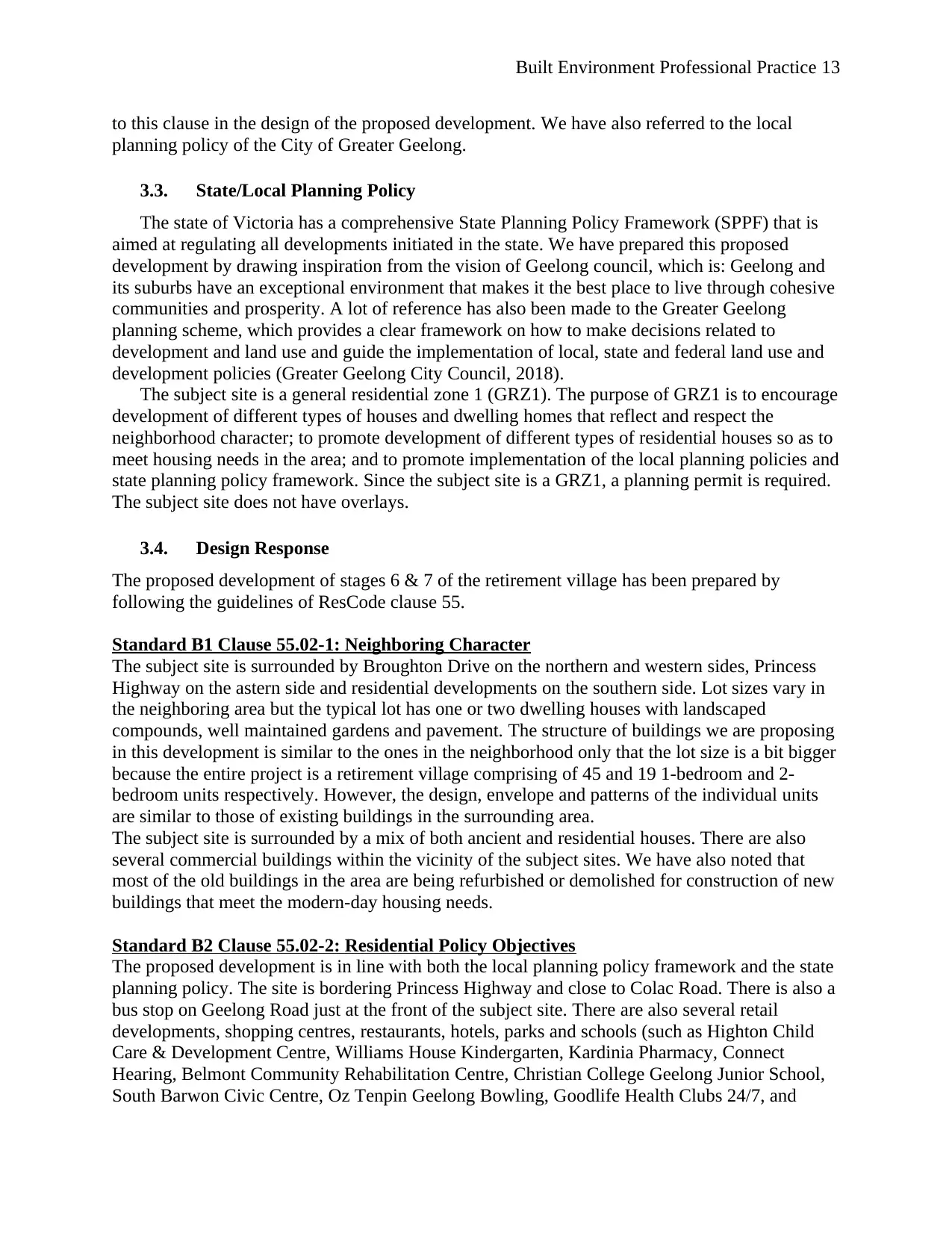
Built Environment Professional Practice 13
to this clause in the design of the proposed development. We have also referred to the local
planning policy of the City of Greater Geelong.
3.3. State/Local Planning Policy
The state of Victoria has a comprehensive State Planning Policy Framework (SPPF) that is
aimed at regulating all developments initiated in the state. We have prepared this proposed
development by drawing inspiration from the vision of Geelong council, which is: Geelong and
its suburbs have an exceptional environment that makes it the best place to live through cohesive
communities and prosperity. A lot of reference has also been made to the Greater Geelong
planning scheme, which provides a clear framework on how to make decisions related to
development and land use and guide the implementation of local, state and federal land use and
development policies (Greater Geelong City Council, 2018).
The subject site is a general residential zone 1 (GRZ1). The purpose of GRZ1 is to encourage
development of different types of houses and dwelling homes that reflect and respect the
neighborhood character; to promote development of different types of residential houses so as to
meet housing needs in the area; and to promote implementation of the local planning policies and
state planning policy framework. Since the subject site is a GRZ1, a planning permit is required.
The subject site does not have overlays.
3.4. Design Response
The proposed development of stages 6 & 7 of the retirement village has been prepared by
following the guidelines of ResCode clause 55.
Standard B1 Clause 55.02-1: Neighboring Character
The subject site is surrounded by Broughton Drive on the northern and western sides, Princess
Highway on the astern side and residential developments on the southern side. Lot sizes vary in
the neighboring area but the typical lot has one or two dwelling houses with landscaped
compounds, well maintained gardens and pavement. The structure of buildings we are proposing
in this development is similar to the ones in the neighborhood only that the lot size is a bit bigger
because the entire project is a retirement village comprising of 45 and 19 1-bedroom and 2-
bedroom units respectively. However, the design, envelope and patterns of the individual units
are similar to those of existing buildings in the surrounding area.
The subject site is surrounded by a mix of both ancient and residential houses. There are also
several commercial buildings within the vicinity of the subject sites. We have also noted that
most of the old buildings in the area are being refurbished or demolished for construction of new
buildings that meet the modern-day housing needs.
Standard B2 Clause 55.02-2: Residential Policy Objectives
The proposed development is in line with both the local planning policy framework and the state
planning policy. The site is bordering Princess Highway and close to Colac Road. There is also a
bus stop on Geelong Road just at the front of the subject site. There are also several retail
developments, shopping centres, restaurants, hotels, parks and schools (such as Highton Child
Care & Development Centre, Williams House Kindergarten, Kardinia Pharmacy, Connect
Hearing, Belmont Community Rehabilitation Centre, Christian College Geelong Junior School,
South Barwon Civic Centre, Oz Tenpin Geelong Bowling, Goodlife Health Clubs 24/7, and
to this clause in the design of the proposed development. We have also referred to the local
planning policy of the City of Greater Geelong.
3.3. State/Local Planning Policy
The state of Victoria has a comprehensive State Planning Policy Framework (SPPF) that is
aimed at regulating all developments initiated in the state. We have prepared this proposed
development by drawing inspiration from the vision of Geelong council, which is: Geelong and
its suburbs have an exceptional environment that makes it the best place to live through cohesive
communities and prosperity. A lot of reference has also been made to the Greater Geelong
planning scheme, which provides a clear framework on how to make decisions related to
development and land use and guide the implementation of local, state and federal land use and
development policies (Greater Geelong City Council, 2018).
The subject site is a general residential zone 1 (GRZ1). The purpose of GRZ1 is to encourage
development of different types of houses and dwelling homes that reflect and respect the
neighborhood character; to promote development of different types of residential houses so as to
meet housing needs in the area; and to promote implementation of the local planning policies and
state planning policy framework. Since the subject site is a GRZ1, a planning permit is required.
The subject site does not have overlays.
3.4. Design Response
The proposed development of stages 6 & 7 of the retirement village has been prepared by
following the guidelines of ResCode clause 55.
Standard B1 Clause 55.02-1: Neighboring Character
The subject site is surrounded by Broughton Drive on the northern and western sides, Princess
Highway on the astern side and residential developments on the southern side. Lot sizes vary in
the neighboring area but the typical lot has one or two dwelling houses with landscaped
compounds, well maintained gardens and pavement. The structure of buildings we are proposing
in this development is similar to the ones in the neighborhood only that the lot size is a bit bigger
because the entire project is a retirement village comprising of 45 and 19 1-bedroom and 2-
bedroom units respectively. However, the design, envelope and patterns of the individual units
are similar to those of existing buildings in the surrounding area.
The subject site is surrounded by a mix of both ancient and residential houses. There are also
several commercial buildings within the vicinity of the subject sites. We have also noted that
most of the old buildings in the area are being refurbished or demolished for construction of new
buildings that meet the modern-day housing needs.
Standard B2 Clause 55.02-2: Residential Policy Objectives
The proposed development is in line with both the local planning policy framework and the state
planning policy. The site is bordering Princess Highway and close to Colac Road. There is also a
bus stop on Geelong Road just at the front of the subject site. There are also several retail
developments, shopping centres, restaurants, hotels, parks and schools (such as Highton Child
Care & Development Centre, Williams House Kindergarten, Kardinia Pharmacy, Connect
Hearing, Belmont Community Rehabilitation Centre, Christian College Geelong Junior School,
South Barwon Civic Centre, Oz Tenpin Geelong Bowling, Goodlife Health Clubs 24/7, and
Secure Best Marks with AI Grader
Need help grading? Try our AI Grader for instant feedback on your assignments.
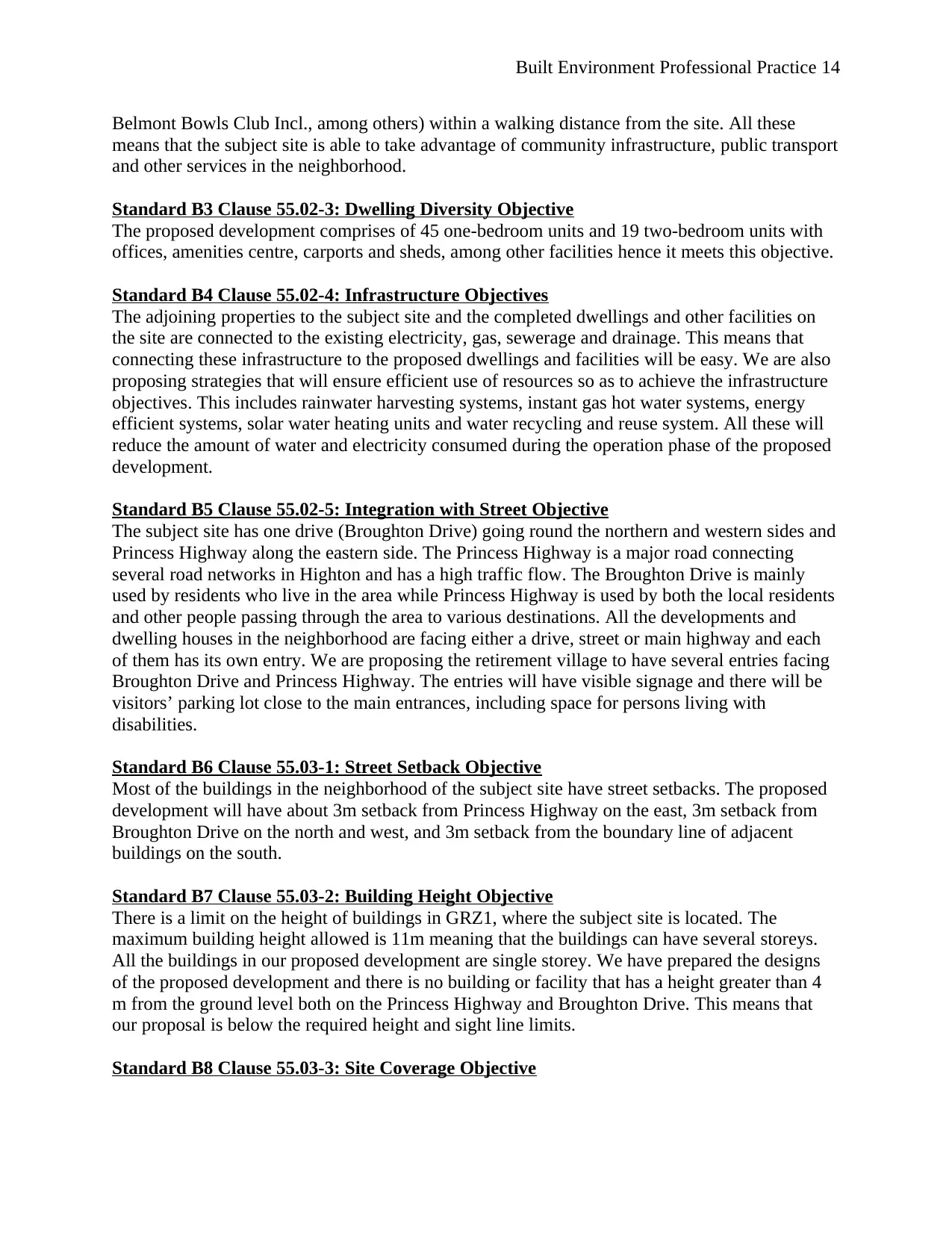
Built Environment Professional Practice 14
Belmont Bowls Club Incl., among others) within a walking distance from the site. All these
means that the subject site is able to take advantage of community infrastructure, public transport
and other services in the neighborhood.
Standard B3 Clause 55.02-3: Dwelling Diversity Objective
The proposed development comprises of 45 one-bedroom units and 19 two-bedroom units with
offices, amenities centre, carports and sheds, among other facilities hence it meets this objective.
Standard B4 Clause 55.02-4: Infrastructure Objectives
The adjoining properties to the subject site and the completed dwellings and other facilities on
the site are connected to the existing electricity, gas, sewerage and drainage. This means that
connecting these infrastructure to the proposed dwellings and facilities will be easy. We are also
proposing strategies that will ensure efficient use of resources so as to achieve the infrastructure
objectives. This includes rainwater harvesting systems, instant gas hot water systems, energy
efficient systems, solar water heating units and water recycling and reuse system. All these will
reduce the amount of water and electricity consumed during the operation phase of the proposed
development.
Standard B5 Clause 55.02-5: Integration with Street Objective
The subject site has one drive (Broughton Drive) going round the northern and western sides and
Princess Highway along the eastern side. The Princess Highway is a major road connecting
several road networks in Highton and has a high traffic flow. The Broughton Drive is mainly
used by residents who live in the area while Princess Highway is used by both the local residents
and other people passing through the area to various destinations. All the developments and
dwelling houses in the neighborhood are facing either a drive, street or main highway and each
of them has its own entry. We are proposing the retirement village to have several entries facing
Broughton Drive and Princess Highway. The entries will have visible signage and there will be
visitors’ parking lot close to the main entrances, including space for persons living with
disabilities.
Standard B6 Clause 55.03-1: Street Setback Objective
Most of the buildings in the neighborhood of the subject site have street setbacks. The proposed
development will have about 3m setback from Princess Highway on the east, 3m setback from
Broughton Drive on the north and west, and 3m setback from the boundary line of adjacent
buildings on the south.
Standard B7 Clause 55.03-2: Building Height Objective
There is a limit on the height of buildings in GRZ1, where the subject site is located. The
maximum building height allowed is 11m meaning that the buildings can have several storeys.
All the buildings in our proposed development are single storey. We have prepared the designs
of the proposed development and there is no building or facility that has a height greater than 4
m from the ground level both on the Princess Highway and Broughton Drive. This means that
our proposal is below the required height and sight line limits.
Standard B8 Clause 55.03-3: Site Coverage Objective
Belmont Bowls Club Incl., among others) within a walking distance from the site. All these
means that the subject site is able to take advantage of community infrastructure, public transport
and other services in the neighborhood.
Standard B3 Clause 55.02-3: Dwelling Diversity Objective
The proposed development comprises of 45 one-bedroom units and 19 two-bedroom units with
offices, amenities centre, carports and sheds, among other facilities hence it meets this objective.
Standard B4 Clause 55.02-4: Infrastructure Objectives
The adjoining properties to the subject site and the completed dwellings and other facilities on
the site are connected to the existing electricity, gas, sewerage and drainage. This means that
connecting these infrastructure to the proposed dwellings and facilities will be easy. We are also
proposing strategies that will ensure efficient use of resources so as to achieve the infrastructure
objectives. This includes rainwater harvesting systems, instant gas hot water systems, energy
efficient systems, solar water heating units and water recycling and reuse system. All these will
reduce the amount of water and electricity consumed during the operation phase of the proposed
development.
Standard B5 Clause 55.02-5: Integration with Street Objective
The subject site has one drive (Broughton Drive) going round the northern and western sides and
Princess Highway along the eastern side. The Princess Highway is a major road connecting
several road networks in Highton and has a high traffic flow. The Broughton Drive is mainly
used by residents who live in the area while Princess Highway is used by both the local residents
and other people passing through the area to various destinations. All the developments and
dwelling houses in the neighborhood are facing either a drive, street or main highway and each
of them has its own entry. We are proposing the retirement village to have several entries facing
Broughton Drive and Princess Highway. The entries will have visible signage and there will be
visitors’ parking lot close to the main entrances, including space for persons living with
disabilities.
Standard B6 Clause 55.03-1: Street Setback Objective
Most of the buildings in the neighborhood of the subject site have street setbacks. The proposed
development will have about 3m setback from Princess Highway on the east, 3m setback from
Broughton Drive on the north and west, and 3m setback from the boundary line of adjacent
buildings on the south.
Standard B7 Clause 55.03-2: Building Height Objective
There is a limit on the height of buildings in GRZ1, where the subject site is located. The
maximum building height allowed is 11m meaning that the buildings can have several storeys.
All the buildings in our proposed development are single storey. We have prepared the designs
of the proposed development and there is no building or facility that has a height greater than 4
m from the ground level both on the Princess Highway and Broughton Drive. This means that
our proposal is below the required height and sight line limits.
Standard B8 Clause 55.03-3: Site Coverage Objective
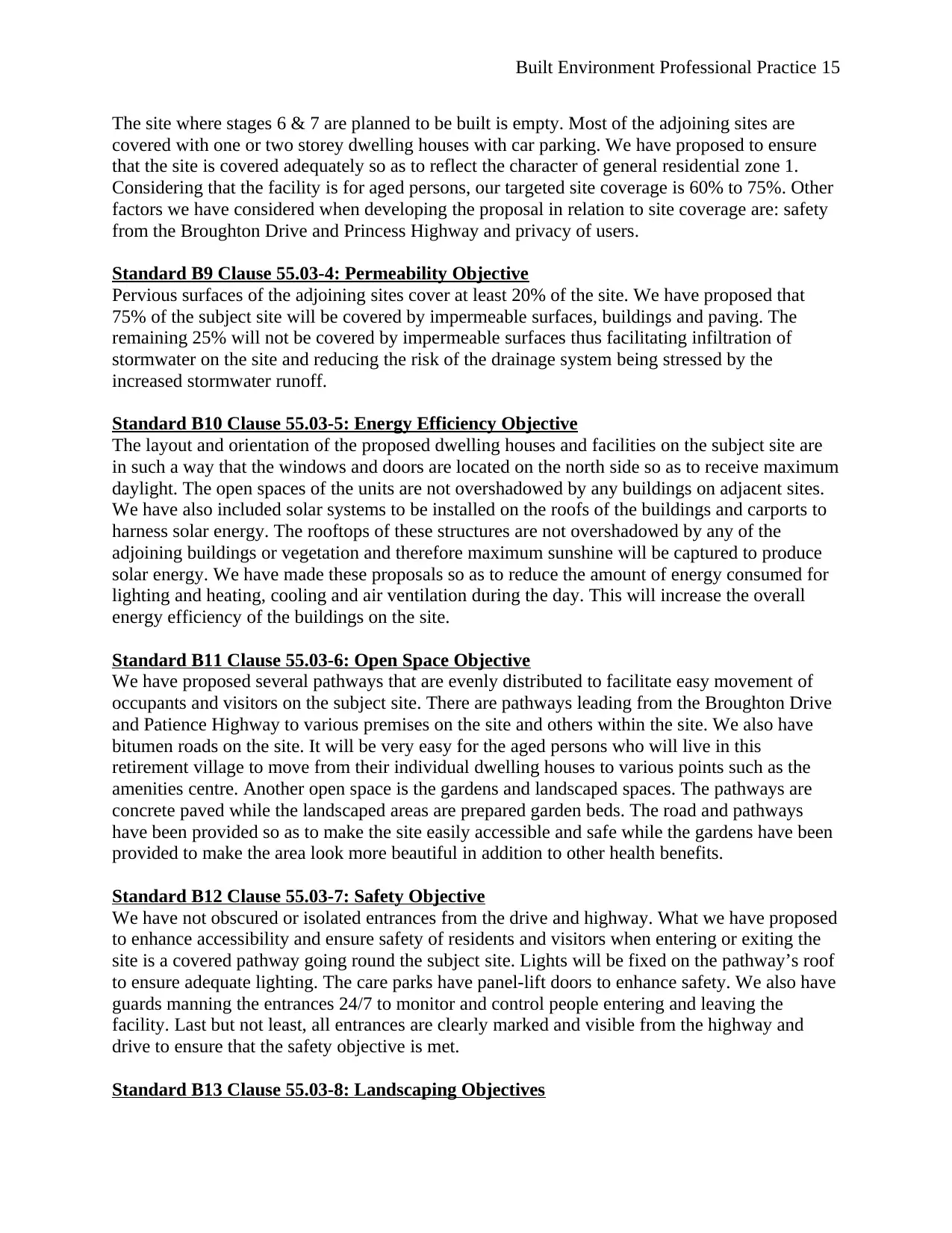
Built Environment Professional Practice 15
The site where stages 6 & 7 are planned to be built is empty. Most of the adjoining sites are
covered with one or two storey dwelling houses with car parking. We have proposed to ensure
that the site is covered adequately so as to reflect the character of general residential zone 1.
Considering that the facility is for aged persons, our targeted site coverage is 60% to 75%. Other
factors we have considered when developing the proposal in relation to site coverage are: safety
from the Broughton Drive and Princess Highway and privacy of users.
Standard B9 Clause 55.03-4: Permeability Objective
Pervious surfaces of the adjoining sites cover at least 20% of the site. We have proposed that
75% of the subject site will be covered by impermeable surfaces, buildings and paving. The
remaining 25% will not be covered by impermeable surfaces thus facilitating infiltration of
stormwater on the site and reducing the risk of the drainage system being stressed by the
increased stormwater runoff.
Standard B10 Clause 55.03-5: Energy Efficiency Objective
The layout and orientation of the proposed dwelling houses and facilities on the subject site are
in such a way that the windows and doors are located on the north side so as to receive maximum
daylight. The open spaces of the units are not overshadowed by any buildings on adjacent sites.
We have also included solar systems to be installed on the roofs of the buildings and carports to
harness solar energy. The rooftops of these structures are not overshadowed by any of the
adjoining buildings or vegetation and therefore maximum sunshine will be captured to produce
solar energy. We have made these proposals so as to reduce the amount of energy consumed for
lighting and heating, cooling and air ventilation during the day. This will increase the overall
energy efficiency of the buildings on the site.
Standard B11 Clause 55.03-6: Open Space Objective
We have proposed several pathways that are evenly distributed to facilitate easy movement of
occupants and visitors on the subject site. There are pathways leading from the Broughton Drive
and Patience Highway to various premises on the site and others within the site. We also have
bitumen roads on the site. It will be very easy for the aged persons who will live in this
retirement village to move from their individual dwelling houses to various points such as the
amenities centre. Another open space is the gardens and landscaped spaces. The pathways are
concrete paved while the landscaped areas are prepared garden beds. The road and pathways
have been provided so as to make the site easily accessible and safe while the gardens have been
provided to make the area look more beautiful in addition to other health benefits.
Standard B12 Clause 55.03-7: Safety Objective
We have not obscured or isolated entrances from the drive and highway. What we have proposed
to enhance accessibility and ensure safety of residents and visitors when entering or exiting the
site is a covered pathway going round the subject site. Lights will be fixed on the pathway’s roof
to ensure adequate lighting. The care parks have panel-lift doors to enhance safety. We also have
guards manning the entrances 24/7 to monitor and control people entering and leaving the
facility. Last but not least, all entrances are clearly marked and visible from the highway and
drive to ensure that the safety objective is met.
Standard B13 Clause 55.03-8: Landscaping Objectives
The site where stages 6 & 7 are planned to be built is empty. Most of the adjoining sites are
covered with one or two storey dwelling houses with car parking. We have proposed to ensure
that the site is covered adequately so as to reflect the character of general residential zone 1.
Considering that the facility is for aged persons, our targeted site coverage is 60% to 75%. Other
factors we have considered when developing the proposal in relation to site coverage are: safety
from the Broughton Drive and Princess Highway and privacy of users.
Standard B9 Clause 55.03-4: Permeability Objective
Pervious surfaces of the adjoining sites cover at least 20% of the site. We have proposed that
75% of the subject site will be covered by impermeable surfaces, buildings and paving. The
remaining 25% will not be covered by impermeable surfaces thus facilitating infiltration of
stormwater on the site and reducing the risk of the drainage system being stressed by the
increased stormwater runoff.
Standard B10 Clause 55.03-5: Energy Efficiency Objective
The layout and orientation of the proposed dwelling houses and facilities on the subject site are
in such a way that the windows and doors are located on the north side so as to receive maximum
daylight. The open spaces of the units are not overshadowed by any buildings on adjacent sites.
We have also included solar systems to be installed on the roofs of the buildings and carports to
harness solar energy. The rooftops of these structures are not overshadowed by any of the
adjoining buildings or vegetation and therefore maximum sunshine will be captured to produce
solar energy. We have made these proposals so as to reduce the amount of energy consumed for
lighting and heating, cooling and air ventilation during the day. This will increase the overall
energy efficiency of the buildings on the site.
Standard B11 Clause 55.03-6: Open Space Objective
We have proposed several pathways that are evenly distributed to facilitate easy movement of
occupants and visitors on the subject site. There are pathways leading from the Broughton Drive
and Patience Highway to various premises on the site and others within the site. We also have
bitumen roads on the site. It will be very easy for the aged persons who will live in this
retirement village to move from their individual dwelling houses to various points such as the
amenities centre. Another open space is the gardens and landscaped spaces. The pathways are
concrete paved while the landscaped areas are prepared garden beds. The road and pathways
have been provided so as to make the site easily accessible and safe while the gardens have been
provided to make the area look more beautiful in addition to other health benefits.
Standard B12 Clause 55.03-7: Safety Objective
We have not obscured or isolated entrances from the drive and highway. What we have proposed
to enhance accessibility and ensure safety of residents and visitors when entering or exiting the
site is a covered pathway going round the subject site. Lights will be fixed on the pathway’s roof
to ensure adequate lighting. The care parks have panel-lift doors to enhance safety. We also have
guards manning the entrances 24/7 to monitor and control people entering and leaving the
facility. Last but not least, all entrances are clearly marked and visible from the highway and
drive to ensure that the safety objective is met.
Standard B13 Clause 55.03-8: Landscaping Objectives
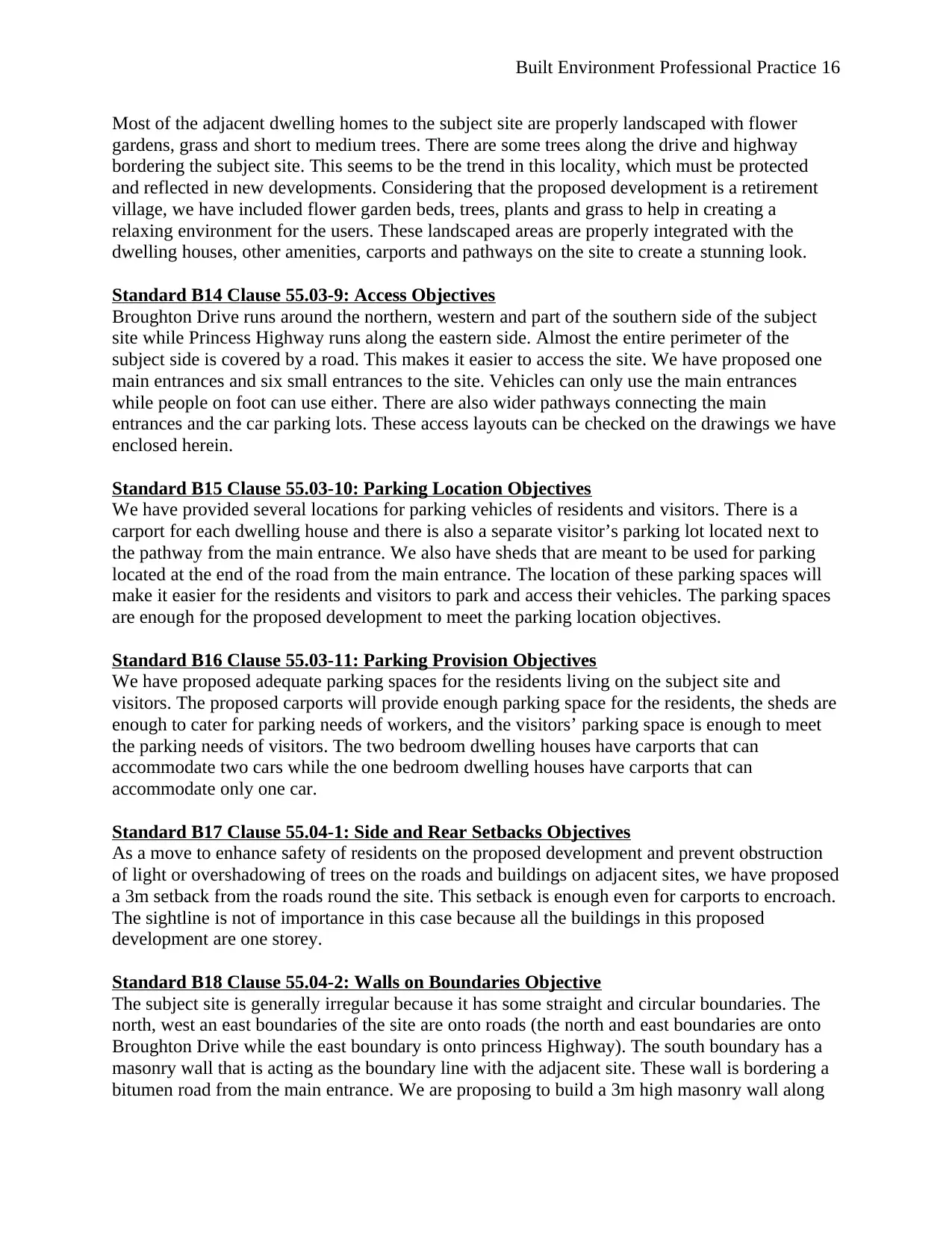
Built Environment Professional Practice 16
Most of the adjacent dwelling homes to the subject site are properly landscaped with flower
gardens, grass and short to medium trees. There are some trees along the drive and highway
bordering the subject site. This seems to be the trend in this locality, which must be protected
and reflected in new developments. Considering that the proposed development is a retirement
village, we have included flower garden beds, trees, plants and grass to help in creating a
relaxing environment for the users. These landscaped areas are properly integrated with the
dwelling houses, other amenities, carports and pathways on the site to create a stunning look.
Standard B14 Clause 55.03-9: Access Objectives
Broughton Drive runs around the northern, western and part of the southern side of the subject
site while Princess Highway runs along the eastern side. Almost the entire perimeter of the
subject side is covered by a road. This makes it easier to access the site. We have proposed one
main entrances and six small entrances to the site. Vehicles can only use the main entrances
while people on foot can use either. There are also wider pathways connecting the main
entrances and the car parking lots. These access layouts can be checked on the drawings we have
enclosed herein.
Standard B15 Clause 55.03-10: Parking Location Objectives
We have provided several locations for parking vehicles of residents and visitors. There is a
carport for each dwelling house and there is also a separate visitor’s parking lot located next to
the pathway from the main entrance. We also have sheds that are meant to be used for parking
located at the end of the road from the main entrance. The location of these parking spaces will
make it easier for the residents and visitors to park and access their vehicles. The parking spaces
are enough for the proposed development to meet the parking location objectives.
Standard B16 Clause 55.03-11: Parking Provision Objectives
We have proposed adequate parking spaces for the residents living on the subject site and
visitors. The proposed carports will provide enough parking space for the residents, the sheds are
enough to cater for parking needs of workers, and the visitors’ parking space is enough to meet
the parking needs of visitors. The two bedroom dwelling houses have carports that can
accommodate two cars while the one bedroom dwelling houses have carports that can
accommodate only one car.
Standard B17 Clause 55.04-1: Side and Rear Setbacks Objectives
As a move to enhance safety of residents on the proposed development and prevent obstruction
of light or overshadowing of trees on the roads and buildings on adjacent sites, we have proposed
a 3m setback from the roads round the site. This setback is enough even for carports to encroach.
The sightline is not of importance in this case because all the buildings in this proposed
development are one storey.
Standard B18 Clause 55.04-2: Walls on Boundaries Objective
The subject site is generally irregular because it has some straight and circular boundaries. The
north, west an east boundaries of the site are onto roads (the north and east boundaries are onto
Broughton Drive while the east boundary is onto princess Highway). The south boundary has a
masonry wall that is acting as the boundary line with the adjacent site. These wall is bordering a
bitumen road from the main entrance. We are proposing to build a 3m high masonry wall along
Most of the adjacent dwelling homes to the subject site are properly landscaped with flower
gardens, grass and short to medium trees. There are some trees along the drive and highway
bordering the subject site. This seems to be the trend in this locality, which must be protected
and reflected in new developments. Considering that the proposed development is a retirement
village, we have included flower garden beds, trees, plants and grass to help in creating a
relaxing environment for the users. These landscaped areas are properly integrated with the
dwelling houses, other amenities, carports and pathways on the site to create a stunning look.
Standard B14 Clause 55.03-9: Access Objectives
Broughton Drive runs around the northern, western and part of the southern side of the subject
site while Princess Highway runs along the eastern side. Almost the entire perimeter of the
subject side is covered by a road. This makes it easier to access the site. We have proposed one
main entrances and six small entrances to the site. Vehicles can only use the main entrances
while people on foot can use either. There are also wider pathways connecting the main
entrances and the car parking lots. These access layouts can be checked on the drawings we have
enclosed herein.
Standard B15 Clause 55.03-10: Parking Location Objectives
We have provided several locations for parking vehicles of residents and visitors. There is a
carport for each dwelling house and there is also a separate visitor’s parking lot located next to
the pathway from the main entrance. We also have sheds that are meant to be used for parking
located at the end of the road from the main entrance. The location of these parking spaces will
make it easier for the residents and visitors to park and access their vehicles. The parking spaces
are enough for the proposed development to meet the parking location objectives.
Standard B16 Clause 55.03-11: Parking Provision Objectives
We have proposed adequate parking spaces for the residents living on the subject site and
visitors. The proposed carports will provide enough parking space for the residents, the sheds are
enough to cater for parking needs of workers, and the visitors’ parking space is enough to meet
the parking needs of visitors. The two bedroom dwelling houses have carports that can
accommodate two cars while the one bedroom dwelling houses have carports that can
accommodate only one car.
Standard B17 Clause 55.04-1: Side and Rear Setbacks Objectives
As a move to enhance safety of residents on the proposed development and prevent obstruction
of light or overshadowing of trees on the roads and buildings on adjacent sites, we have proposed
a 3m setback from the roads round the site. This setback is enough even for carports to encroach.
The sightline is not of importance in this case because all the buildings in this proposed
development are one storey.
Standard B18 Clause 55.04-2: Walls on Boundaries Objective
The subject site is generally irregular because it has some straight and circular boundaries. The
north, west an east boundaries of the site are onto roads (the north and east boundaries are onto
Broughton Drive while the east boundary is onto princess Highway). The south boundary has a
masonry wall that is acting as the boundary line with the adjacent site. These wall is bordering a
bitumen road from the main entrance. We are proposing to build a 3m high masonry wall along
Paraphrase This Document
Need a fresh take? Get an instant paraphrase of this document with our AI Paraphraser
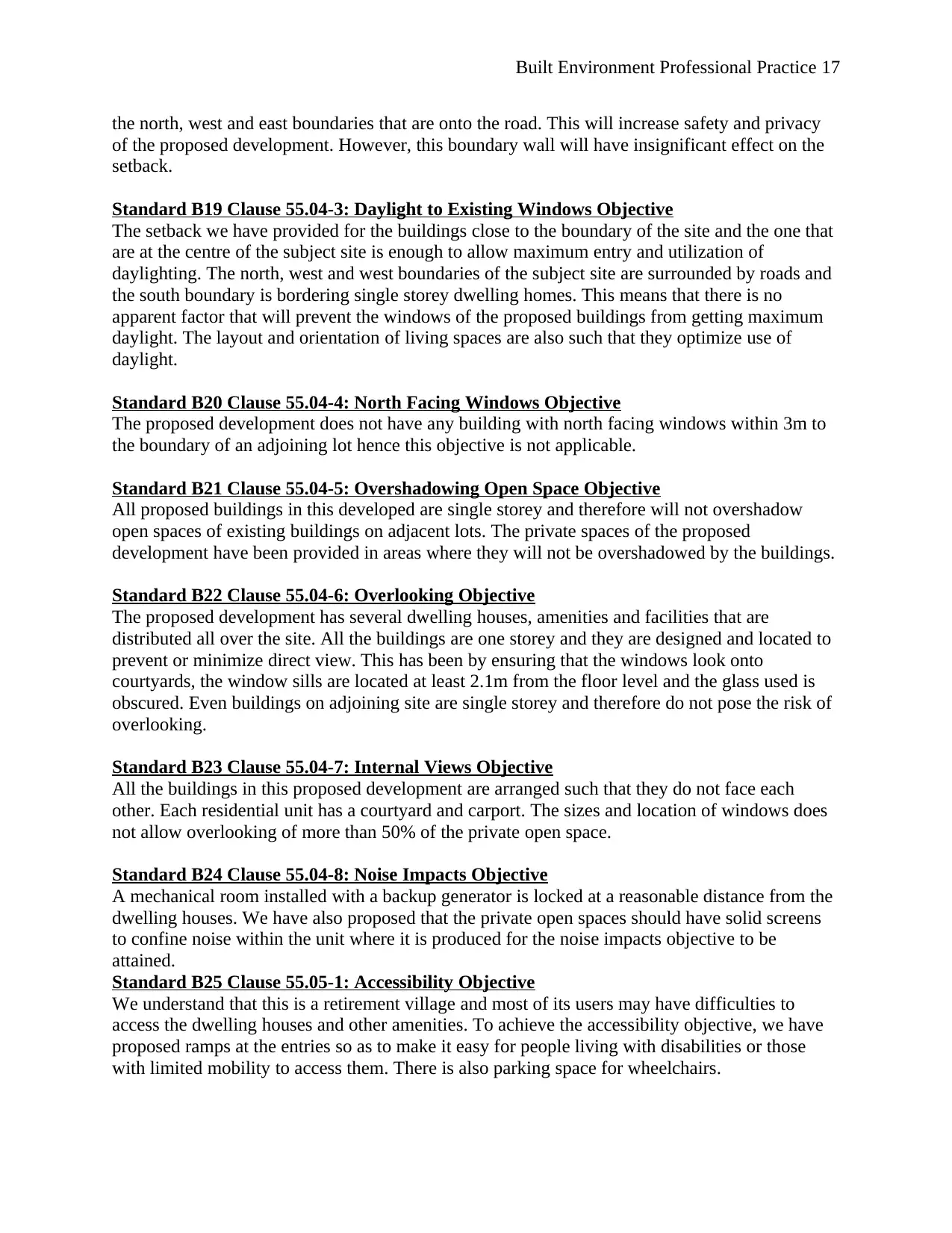
Built Environment Professional Practice 17
the north, west and east boundaries that are onto the road. This will increase safety and privacy
of the proposed development. However, this boundary wall will have insignificant effect on the
setback.
Standard B19 Clause 55.04-3: Daylight to Existing Windows Objective
The setback we have provided for the buildings close to the boundary of the site and the one that
are at the centre of the subject site is enough to allow maximum entry and utilization of
daylighting. The north, west and west boundaries of the subject site are surrounded by roads and
the south boundary is bordering single storey dwelling homes. This means that there is no
apparent factor that will prevent the windows of the proposed buildings from getting maximum
daylight. The layout and orientation of living spaces are also such that they optimize use of
daylight.
Standard B20 Clause 55.04-4: North Facing Windows Objective
The proposed development does not have any building with north facing windows within 3m to
the boundary of an adjoining lot hence this objective is not applicable.
Standard B21 Clause 55.04-5: Overshadowing Open Space Objective
All proposed buildings in this developed are single storey and therefore will not overshadow
open spaces of existing buildings on adjacent lots. The private spaces of the proposed
development have been provided in areas where they will not be overshadowed by the buildings.
Standard B22 Clause 55.04-6: Overlooking Objective
The proposed development has several dwelling houses, amenities and facilities that are
distributed all over the site. All the buildings are one storey and they are designed and located to
prevent or minimize direct view. This has been by ensuring that the windows look onto
courtyards, the window sills are located at least 2.1m from the floor level and the glass used is
obscured. Even buildings on adjoining site are single storey and therefore do not pose the risk of
overlooking.
Standard B23 Clause 55.04-7: Internal Views Objective
All the buildings in this proposed development are arranged such that they do not face each
other. Each residential unit has a courtyard and carport. The sizes and location of windows does
not allow overlooking of more than 50% of the private open space.
Standard B24 Clause 55.04-8: Noise Impacts Objective
A mechanical room installed with a backup generator is locked at a reasonable distance from the
dwelling houses. We have also proposed that the private open spaces should have solid screens
to confine noise within the unit where it is produced for the noise impacts objective to be
attained.
Standard B25 Clause 55.05-1: Accessibility Objective
We understand that this is a retirement village and most of its users may have difficulties to
access the dwelling houses and other amenities. To achieve the accessibility objective, we have
proposed ramps at the entries so as to make it easy for people living with disabilities or those
with limited mobility to access them. There is also parking space for wheelchairs.
the north, west and east boundaries that are onto the road. This will increase safety and privacy
of the proposed development. However, this boundary wall will have insignificant effect on the
setback.
Standard B19 Clause 55.04-3: Daylight to Existing Windows Objective
The setback we have provided for the buildings close to the boundary of the site and the one that
are at the centre of the subject site is enough to allow maximum entry and utilization of
daylighting. The north, west and west boundaries of the subject site are surrounded by roads and
the south boundary is bordering single storey dwelling homes. This means that there is no
apparent factor that will prevent the windows of the proposed buildings from getting maximum
daylight. The layout and orientation of living spaces are also such that they optimize use of
daylight.
Standard B20 Clause 55.04-4: North Facing Windows Objective
The proposed development does not have any building with north facing windows within 3m to
the boundary of an adjoining lot hence this objective is not applicable.
Standard B21 Clause 55.04-5: Overshadowing Open Space Objective
All proposed buildings in this developed are single storey and therefore will not overshadow
open spaces of existing buildings on adjacent lots. The private spaces of the proposed
development have been provided in areas where they will not be overshadowed by the buildings.
Standard B22 Clause 55.04-6: Overlooking Objective
The proposed development has several dwelling houses, amenities and facilities that are
distributed all over the site. All the buildings are one storey and they are designed and located to
prevent or minimize direct view. This has been by ensuring that the windows look onto
courtyards, the window sills are located at least 2.1m from the floor level and the glass used is
obscured. Even buildings on adjoining site are single storey and therefore do not pose the risk of
overlooking.
Standard B23 Clause 55.04-7: Internal Views Objective
All the buildings in this proposed development are arranged such that they do not face each
other. Each residential unit has a courtyard and carport. The sizes and location of windows does
not allow overlooking of more than 50% of the private open space.
Standard B24 Clause 55.04-8: Noise Impacts Objective
A mechanical room installed with a backup generator is locked at a reasonable distance from the
dwelling houses. We have also proposed that the private open spaces should have solid screens
to confine noise within the unit where it is produced for the noise impacts objective to be
attained.
Standard B25 Clause 55.05-1: Accessibility Objective
We understand that this is a retirement village and most of its users may have difficulties to
access the dwelling houses and other amenities. To achieve the accessibility objective, we have
proposed ramps at the entries so as to make it easy for people living with disabilities or those
with limited mobility to access them. There is also parking space for wheelchairs.
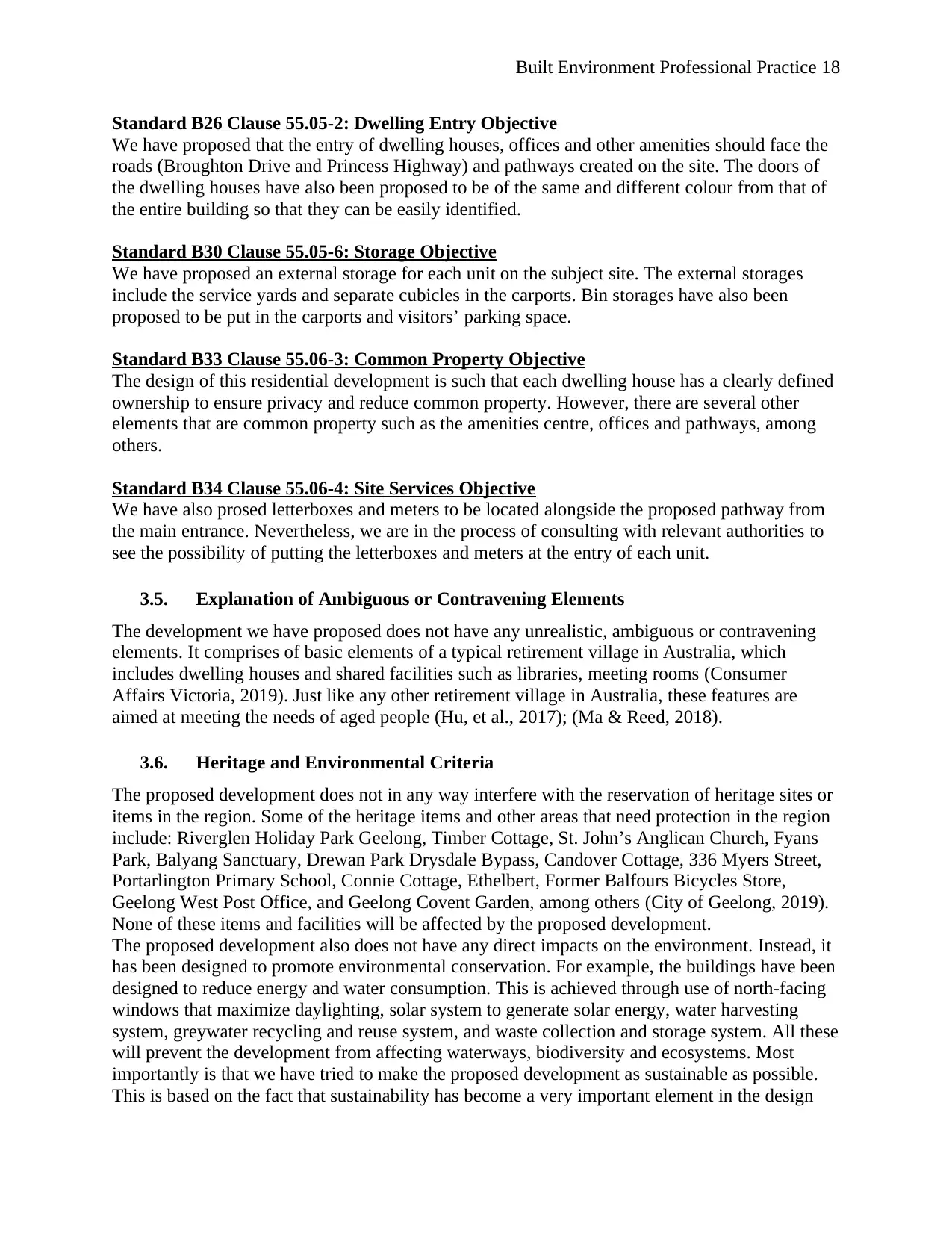
Built Environment Professional Practice 18
Standard B26 Clause 55.05-2: Dwelling Entry Objective
We have proposed that the entry of dwelling houses, offices and other amenities should face the
roads (Broughton Drive and Princess Highway) and pathways created on the site. The doors of
the dwelling houses have also been proposed to be of the same and different colour from that of
the entire building so that they can be easily identified.
Standard B30 Clause 55.05-6: Storage Objective
We have proposed an external storage for each unit on the subject site. The external storages
include the service yards and separate cubicles in the carports. Bin storages have also been
proposed to be put in the carports and visitors’ parking space.
Standard B33 Clause 55.06-3: Common Property Objective
The design of this residential development is such that each dwelling house has a clearly defined
ownership to ensure privacy and reduce common property. However, there are several other
elements that are common property such as the amenities centre, offices and pathways, among
others.
Standard B34 Clause 55.06-4: Site Services Objective
We have also prosed letterboxes and meters to be located alongside the proposed pathway from
the main entrance. Nevertheless, we are in the process of consulting with relevant authorities to
see the possibility of putting the letterboxes and meters at the entry of each unit.
3.5. Explanation of Ambiguous or Contravening Elements
The development we have proposed does not have any unrealistic, ambiguous or contravening
elements. It comprises of basic elements of a typical retirement village in Australia, which
includes dwelling houses and shared facilities such as libraries, meeting rooms (Consumer
Affairs Victoria, 2019). Just like any other retirement village in Australia, these features are
aimed at meeting the needs of aged people (Hu, et al., 2017); (Ma & Reed, 2018).
3.6. Heritage and Environmental Criteria
The proposed development does not in any way interfere with the reservation of heritage sites or
items in the region. Some of the heritage items and other areas that need protection in the region
include: Riverglen Holiday Park Geelong, Timber Cottage, St. John’s Anglican Church, Fyans
Park, Balyang Sanctuary, Drewan Park Drysdale Bypass, Candover Cottage, 336 Myers Street,
Portarlington Primary School, Connie Cottage, Ethelbert, Former Balfours Bicycles Store,
Geelong West Post Office, and Geelong Covent Garden, among others (City of Geelong, 2019).
None of these items and facilities will be affected by the proposed development.
The proposed development also does not have any direct impacts on the environment. Instead, it
has been designed to promote environmental conservation. For example, the buildings have been
designed to reduce energy and water consumption. This is achieved through use of north-facing
windows that maximize daylighting, solar system to generate solar energy, water harvesting
system, greywater recycling and reuse system, and waste collection and storage system. All these
will prevent the development from affecting waterways, biodiversity and ecosystems. Most
importantly is that we have tried to make the proposed development as sustainable as possible.
This is based on the fact that sustainability has become a very important element in the design
Standard B26 Clause 55.05-2: Dwelling Entry Objective
We have proposed that the entry of dwelling houses, offices and other amenities should face the
roads (Broughton Drive and Princess Highway) and pathways created on the site. The doors of
the dwelling houses have also been proposed to be of the same and different colour from that of
the entire building so that they can be easily identified.
Standard B30 Clause 55.05-6: Storage Objective
We have proposed an external storage for each unit on the subject site. The external storages
include the service yards and separate cubicles in the carports. Bin storages have also been
proposed to be put in the carports and visitors’ parking space.
Standard B33 Clause 55.06-3: Common Property Objective
The design of this residential development is such that each dwelling house has a clearly defined
ownership to ensure privacy and reduce common property. However, there are several other
elements that are common property such as the amenities centre, offices and pathways, among
others.
Standard B34 Clause 55.06-4: Site Services Objective
We have also prosed letterboxes and meters to be located alongside the proposed pathway from
the main entrance. Nevertheless, we are in the process of consulting with relevant authorities to
see the possibility of putting the letterboxes and meters at the entry of each unit.
3.5. Explanation of Ambiguous or Contravening Elements
The development we have proposed does not have any unrealistic, ambiguous or contravening
elements. It comprises of basic elements of a typical retirement village in Australia, which
includes dwelling houses and shared facilities such as libraries, meeting rooms (Consumer
Affairs Victoria, 2019). Just like any other retirement village in Australia, these features are
aimed at meeting the needs of aged people (Hu, et al., 2017); (Ma & Reed, 2018).
3.6. Heritage and Environmental Criteria
The proposed development does not in any way interfere with the reservation of heritage sites or
items in the region. Some of the heritage items and other areas that need protection in the region
include: Riverglen Holiday Park Geelong, Timber Cottage, St. John’s Anglican Church, Fyans
Park, Balyang Sanctuary, Drewan Park Drysdale Bypass, Candover Cottage, 336 Myers Street,
Portarlington Primary School, Connie Cottage, Ethelbert, Former Balfours Bicycles Store,
Geelong West Post Office, and Geelong Covent Garden, among others (City of Geelong, 2019).
None of these items and facilities will be affected by the proposed development.
The proposed development also does not have any direct impacts on the environment. Instead, it
has been designed to promote environmental conservation. For example, the buildings have been
designed to reduce energy and water consumption. This is achieved through use of north-facing
windows that maximize daylighting, solar system to generate solar energy, water harvesting
system, greywater recycling and reuse system, and waste collection and storage system. All these
will prevent the development from affecting waterways, biodiversity and ecosystems. Most
importantly is that we have tried to make the proposed development as sustainable as possible.
This is based on the fact that sustainability has become a very important element in the design
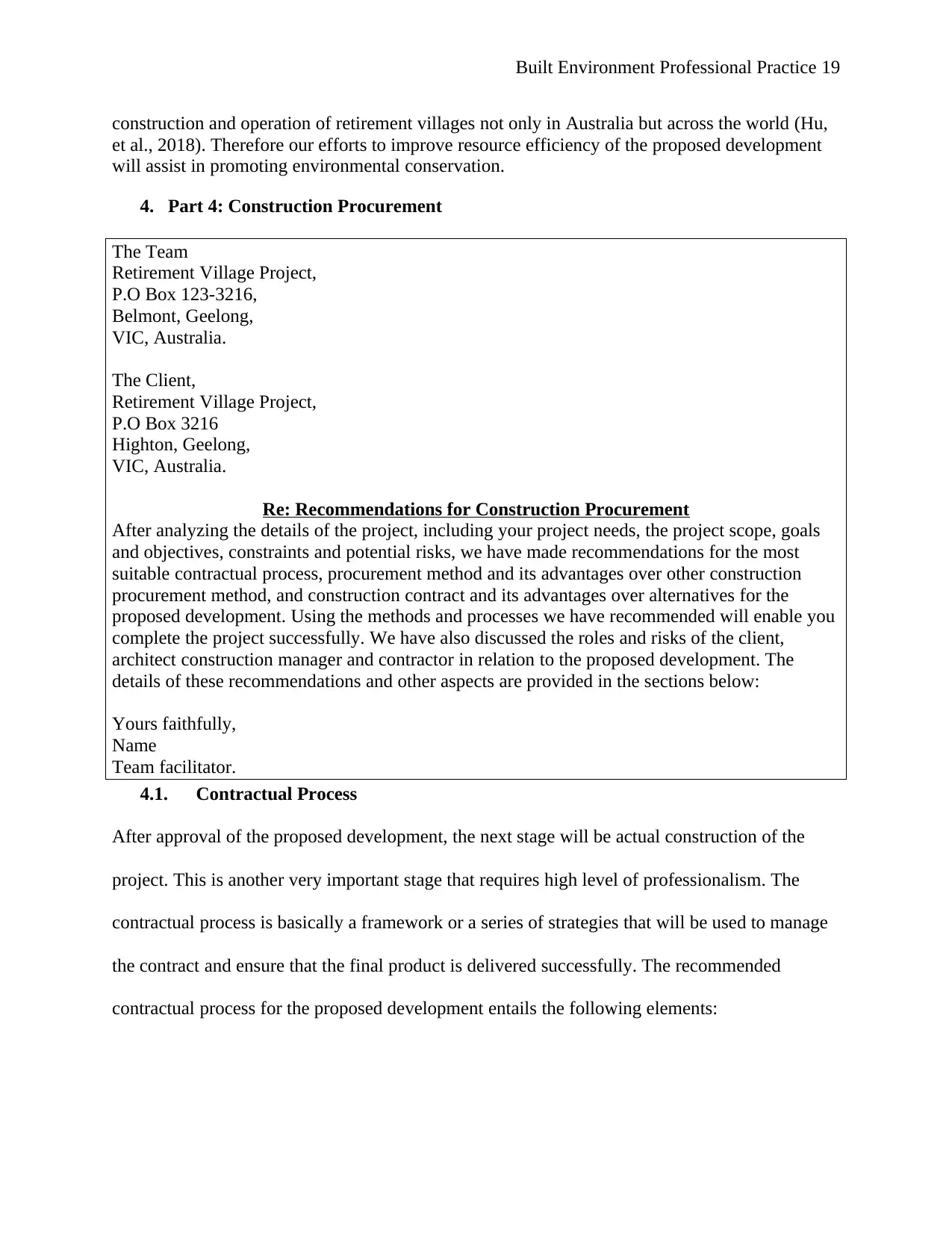
Built Environment Professional Practice 19
construction and operation of retirement villages not only in Australia but across the world (Hu,
et al., 2018). Therefore our efforts to improve resource efficiency of the proposed development
will assist in promoting environmental conservation.
4. Part 4: Construction Procurement
The Team
Retirement Village Project,
P.O Box 123-3216,
Belmont, Geelong,
VIC, Australia.
The Client,
Retirement Village Project,
P.O Box 3216
Highton, Geelong,
VIC, Australia.
Re: Recommendations for Construction Procurement
After analyzing the details of the project, including your project needs, the project scope, goals
and objectives, constraints and potential risks, we have made recommendations for the most
suitable contractual process, procurement method and its advantages over other construction
procurement method, and construction contract and its advantages over alternatives for the
proposed development. Using the methods and processes we have recommended will enable you
complete the project successfully. We have also discussed the roles and risks of the client,
architect construction manager and contractor in relation to the proposed development. The
details of these recommendations and other aspects are provided in the sections below:
Yours faithfully,
Name
Team facilitator.
4.1. Contractual Process
After approval of the proposed development, the next stage will be actual construction of the
project. This is another very important stage that requires high level of professionalism. The
contractual process is basically a framework or a series of strategies that will be used to manage
the contract and ensure that the final product is delivered successfully. The recommended
contractual process for the proposed development entails the following elements:
construction and operation of retirement villages not only in Australia but across the world (Hu,
et al., 2018). Therefore our efforts to improve resource efficiency of the proposed development
will assist in promoting environmental conservation.
4. Part 4: Construction Procurement
The Team
Retirement Village Project,
P.O Box 123-3216,
Belmont, Geelong,
VIC, Australia.
The Client,
Retirement Village Project,
P.O Box 3216
Highton, Geelong,
VIC, Australia.
Re: Recommendations for Construction Procurement
After analyzing the details of the project, including your project needs, the project scope, goals
and objectives, constraints and potential risks, we have made recommendations for the most
suitable contractual process, procurement method and its advantages over other construction
procurement method, and construction contract and its advantages over alternatives for the
proposed development. Using the methods and processes we have recommended will enable you
complete the project successfully. We have also discussed the roles and risks of the client,
architect construction manager and contractor in relation to the proposed development. The
details of these recommendations and other aspects are provided in the sections below:
Yours faithfully,
Name
Team facilitator.
4.1. Contractual Process
After approval of the proposed development, the next stage will be actual construction of the
project. This is another very important stage that requires high level of professionalism. The
contractual process is basically a framework or a series of strategies that will be used to manage
the contract and ensure that the final product is delivered successfully. The recommended
contractual process for the proposed development entails the following elements:
Secure Best Marks with AI Grader
Need help grading? Try our AI Grader for instant feedback on your assignments.

Built Environment Professional Practice 20
Monitoring: the management contractor should liaise with the project manager to
organize for frequent site visits so as to inspect ongoing works and ensure that they are being
carried out in accordance with the terms, conditions and requirements of the contract.
Reporting: contractors have the obligation of preparing regular reports of the progress of
their work. The management contractor should use these reports for evaluating the performance
of the contractors and also prepare progress reports for the client. There should be daily, weekly
and monthly reports.
Evaluation: the project manager in collaboration with the management contractor should
have a consistent process of evaluating the performance of every specialist contractor. The
process should have a set of objectives and expectations. As a matter of fact, every work by the
specialist contractor must be evaluated before proceeding to the nest stage.
Standardization an automation: considering that this project will involve different
specialist contractors, it is important to have standardized templates for responding to various
issues such as variations and reports. This will make it easier for the management contractor to
oversee the contractors because all variations, reports, enquires claims, etc., will have
standardized formats. It will also be better if these templates can be automated so that
stakeholders involved in the project can access them anytime, anywhere.
Centralized data collection: information sharing is very essential in successful delivery of
the proposed development. Numerous specialist contractors will be involved and they will be
seeking and sharing a lot of information. The most effective way of managing this is to have a
centralized system for collecting and sharing data and information. The centralized system
should allow stakeholders to access the information they want easily, share the information they
Monitoring: the management contractor should liaise with the project manager to
organize for frequent site visits so as to inspect ongoing works and ensure that they are being
carried out in accordance with the terms, conditions and requirements of the contract.
Reporting: contractors have the obligation of preparing regular reports of the progress of
their work. The management contractor should use these reports for evaluating the performance
of the contractors and also prepare progress reports for the client. There should be daily, weekly
and monthly reports.
Evaluation: the project manager in collaboration with the management contractor should
have a consistent process of evaluating the performance of every specialist contractor. The
process should have a set of objectives and expectations. As a matter of fact, every work by the
specialist contractor must be evaluated before proceeding to the nest stage.
Standardization an automation: considering that this project will involve different
specialist contractors, it is important to have standardized templates for responding to various
issues such as variations and reports. This will make it easier for the management contractor to
oversee the contractors because all variations, reports, enquires claims, etc., will have
standardized formats. It will also be better if these templates can be automated so that
stakeholders involved in the project can access them anytime, anywhere.
Centralized data collection: information sharing is very essential in successful delivery of
the proposed development. Numerous specialist contractors will be involved and they will be
seeking and sharing a lot of information. The most effective way of managing this is to have a
centralized system for collecting and sharing data and information. The centralized system
should allow stakeholders to access the information they want easily, share the information they
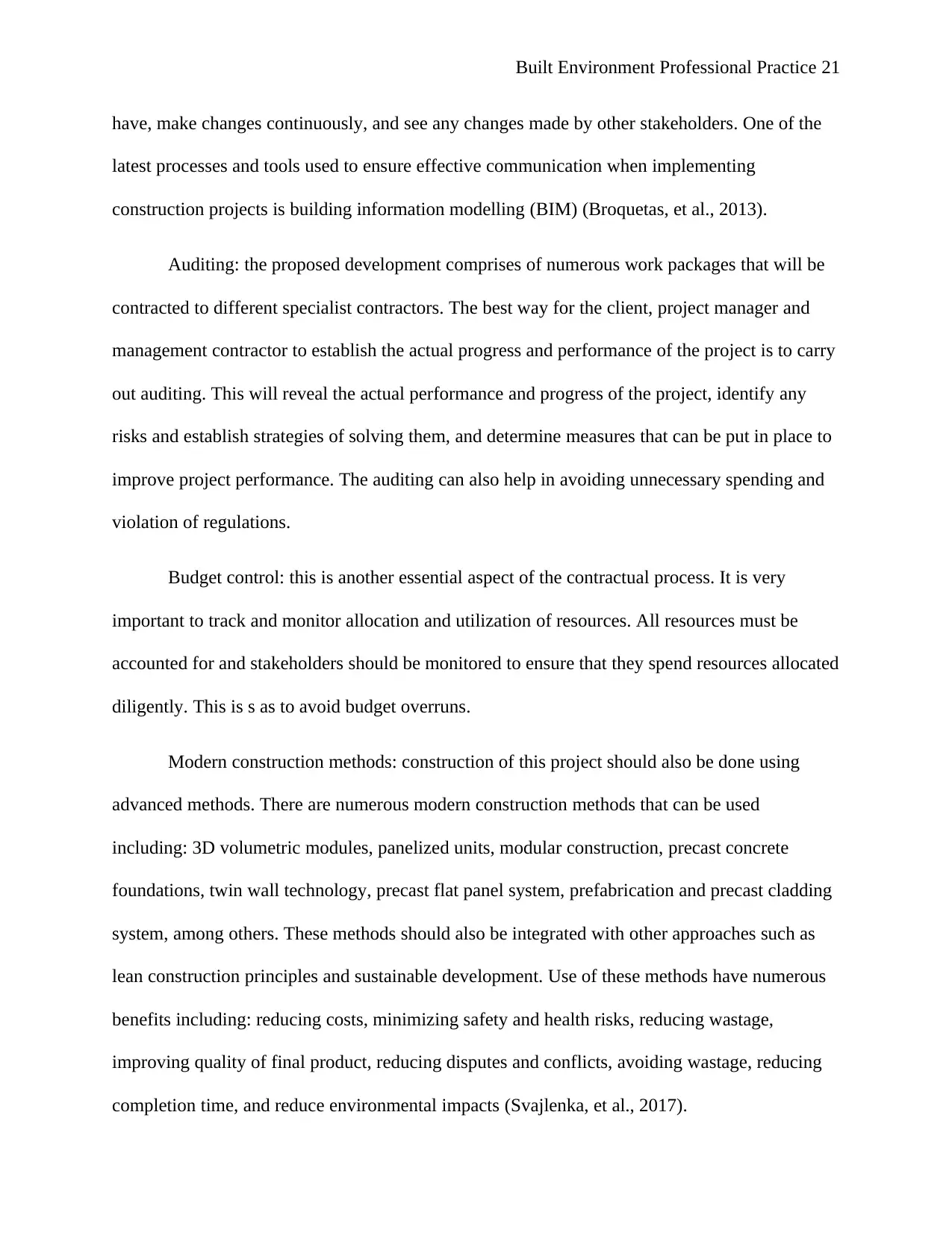
Built Environment Professional Practice 21
have, make changes continuously, and see any changes made by other stakeholders. One of the
latest processes and tools used to ensure effective communication when implementing
construction projects is building information modelling (BIM) (Broquetas, et al., 2013).
Auditing: the proposed development comprises of numerous work packages that will be
contracted to different specialist contractors. The best way for the client, project manager and
management contractor to establish the actual progress and performance of the project is to carry
out auditing. This will reveal the actual performance and progress of the project, identify any
risks and establish strategies of solving them, and determine measures that can be put in place to
improve project performance. The auditing can also help in avoiding unnecessary spending and
violation of regulations.
Budget control: this is another essential aspect of the contractual process. It is very
important to track and monitor allocation and utilization of resources. All resources must be
accounted for and stakeholders should be monitored to ensure that they spend resources allocated
diligently. This is s as to avoid budget overruns.
Modern construction methods: construction of this project should also be done using
advanced methods. There are numerous modern construction methods that can be used
including: 3D volumetric modules, panelized units, modular construction, precast concrete
foundations, twin wall technology, precast flat panel system, prefabrication and precast cladding
system, among others. These methods should also be integrated with other approaches such as
lean construction principles and sustainable development. Use of these methods have numerous
benefits including: reducing costs, minimizing safety and health risks, reducing wastage,
improving quality of final product, reducing disputes and conflicts, avoiding wastage, reducing
completion time, and reduce environmental impacts (Svajlenka, et al., 2017).
have, make changes continuously, and see any changes made by other stakeholders. One of the
latest processes and tools used to ensure effective communication when implementing
construction projects is building information modelling (BIM) (Broquetas, et al., 2013).
Auditing: the proposed development comprises of numerous work packages that will be
contracted to different specialist contractors. The best way for the client, project manager and
management contractor to establish the actual progress and performance of the project is to carry
out auditing. This will reveal the actual performance and progress of the project, identify any
risks and establish strategies of solving them, and determine measures that can be put in place to
improve project performance. The auditing can also help in avoiding unnecessary spending and
violation of regulations.
Budget control: this is another essential aspect of the contractual process. It is very
important to track and monitor allocation and utilization of resources. All resources must be
accounted for and stakeholders should be monitored to ensure that they spend resources allocated
diligently. This is s as to avoid budget overruns.
Modern construction methods: construction of this project should also be done using
advanced methods. There are numerous modern construction methods that can be used
including: 3D volumetric modules, panelized units, modular construction, precast concrete
foundations, twin wall technology, precast flat panel system, prefabrication and precast cladding
system, among others. These methods should also be integrated with other approaches such as
lean construction principles and sustainable development. Use of these methods have numerous
benefits including: reducing costs, minimizing safety and health risks, reducing wastage,
improving quality of final product, reducing disputes and conflicts, avoiding wastage, reducing
completion time, and reduce environmental impacts (Svajlenka, et al., 2017).

Built Environment Professional Practice 22
Rewards: this is another very important aspects of successful contractual process. The
client, project manager and management contractor should develop a mechanism of rewarding
specialist contractors who perform exceptionally. Some of the criteria that can be used to identify
contractors should be rewarded include: early completion, use of creative and innovative
construction methods, adoption of sustainable construction techniques, zero safety and health
issues, and exceptional quality. Rewarding contractors is one of the best ways of appreciating
their efforts and motivating them to perform better in the remaining work or future contracts.
4.2. Construction Procurement Method
4.2.1. Recommended Procurement Method
The procurement method selected has a significant impact on the successful delivery of a
construction project (Naoum & Egbu, 2016); (Naoum, et al., 2012). There are several factors that
must be considered when selecting a procurement method for construction projects (Mathonsi,
2012). These factors include: type of project, size of the project, complexity of the project,
project’s time constraints, financial capability of the client, client’s expertise, the level of quality
required, availability of experienced contractors, urgency of project completion, time and cost
certainty, trust of the client in other parties, regulatory framework, requirement of the client for
value for money, risk avoidance or allocation, project risks, and political constraints (El Agha,
2013). The factors can be summarized into the following: objectives and priorities of the client
and project constraints (Rajeh, et al., 2014). Considering the factors related to the client, cost,
time, risk and characteristics of the retirement village project, the most suitable procurement
method is management contracting.
Management contracting has proven to be a suitable procurement method for certain
construction projects since 1920s. In this method, the client appoints and remains in contact with
Rewards: this is another very important aspects of successful contractual process. The
client, project manager and management contractor should develop a mechanism of rewarding
specialist contractors who perform exceptionally. Some of the criteria that can be used to identify
contractors should be rewarded include: early completion, use of creative and innovative
construction methods, adoption of sustainable construction techniques, zero safety and health
issues, and exceptional quality. Rewarding contractors is one of the best ways of appreciating
their efforts and motivating them to perform better in the remaining work or future contracts.
4.2. Construction Procurement Method
4.2.1. Recommended Procurement Method
The procurement method selected has a significant impact on the successful delivery of a
construction project (Naoum & Egbu, 2016); (Naoum, et al., 2012). There are several factors that
must be considered when selecting a procurement method for construction projects (Mathonsi,
2012). These factors include: type of project, size of the project, complexity of the project,
project’s time constraints, financial capability of the client, client’s expertise, the level of quality
required, availability of experienced contractors, urgency of project completion, time and cost
certainty, trust of the client in other parties, regulatory framework, requirement of the client for
value for money, risk avoidance or allocation, project risks, and political constraints (El Agha,
2013). The factors can be summarized into the following: objectives and priorities of the client
and project constraints (Rajeh, et al., 2014). Considering the factors related to the client, cost,
time, risk and characteristics of the retirement village project, the most suitable procurement
method is management contracting.
Management contracting has proven to be a suitable procurement method for certain
construction projects since 1920s. In this method, the client appoints and remains in contact with
Paraphrase This Document
Need a fresh take? Get an instant paraphrase of this document with our AI Paraphraser

Built Environment Professional Practice 23
only three entities: project manager, consultants and management contractor, as shown in Figure
2 below. The consultants comprise of the project manager, architect/designer(s), structural
engineer(s), mechanical engineer(s), electrical engineer(s), quantity surveyor, building surveyor
and other specialist consultants such as accountants, legal experts and environmentalists. Both
entities are appointed and involved in the project at the early stages, giving the management
contractor the opportunity to make his contribution on how the project is planned and designed.
This helps in improving the buildability of the project and also reducing the project cost and
delivery time because the management contractor provides essential inputs based on his
experience. This signifies that it is important for the client to appoint a knowledgeable and
experienced management contractor.
The organization structure of management contracting procurement method is as shown in
Figure 2 below
Figure 2: Organizational structure of management contracting procurement method
Client/Owner
Management ContractorProject Manager Consultants
Specialist Contractor Specialist Contractor Specialist Contractor
SuppliersSuppliers Suppliers
only three entities: project manager, consultants and management contractor, as shown in Figure
2 below. The consultants comprise of the project manager, architect/designer(s), structural
engineer(s), mechanical engineer(s), electrical engineer(s), quantity surveyor, building surveyor
and other specialist consultants such as accountants, legal experts and environmentalists. Both
entities are appointed and involved in the project at the early stages, giving the management
contractor the opportunity to make his contribution on how the project is planned and designed.
This helps in improving the buildability of the project and also reducing the project cost and
delivery time because the management contractor provides essential inputs based on his
experience. This signifies that it is important for the client to appoint a knowledgeable and
experienced management contractor.
The organization structure of management contracting procurement method is as shown in
Figure 2 below
Figure 2: Organizational structure of management contracting procurement method
Client/Owner
Management ContractorProject Manager Consultants
Specialist Contractor Specialist Contractor Specialist Contractor
SuppliersSuppliers Suppliers
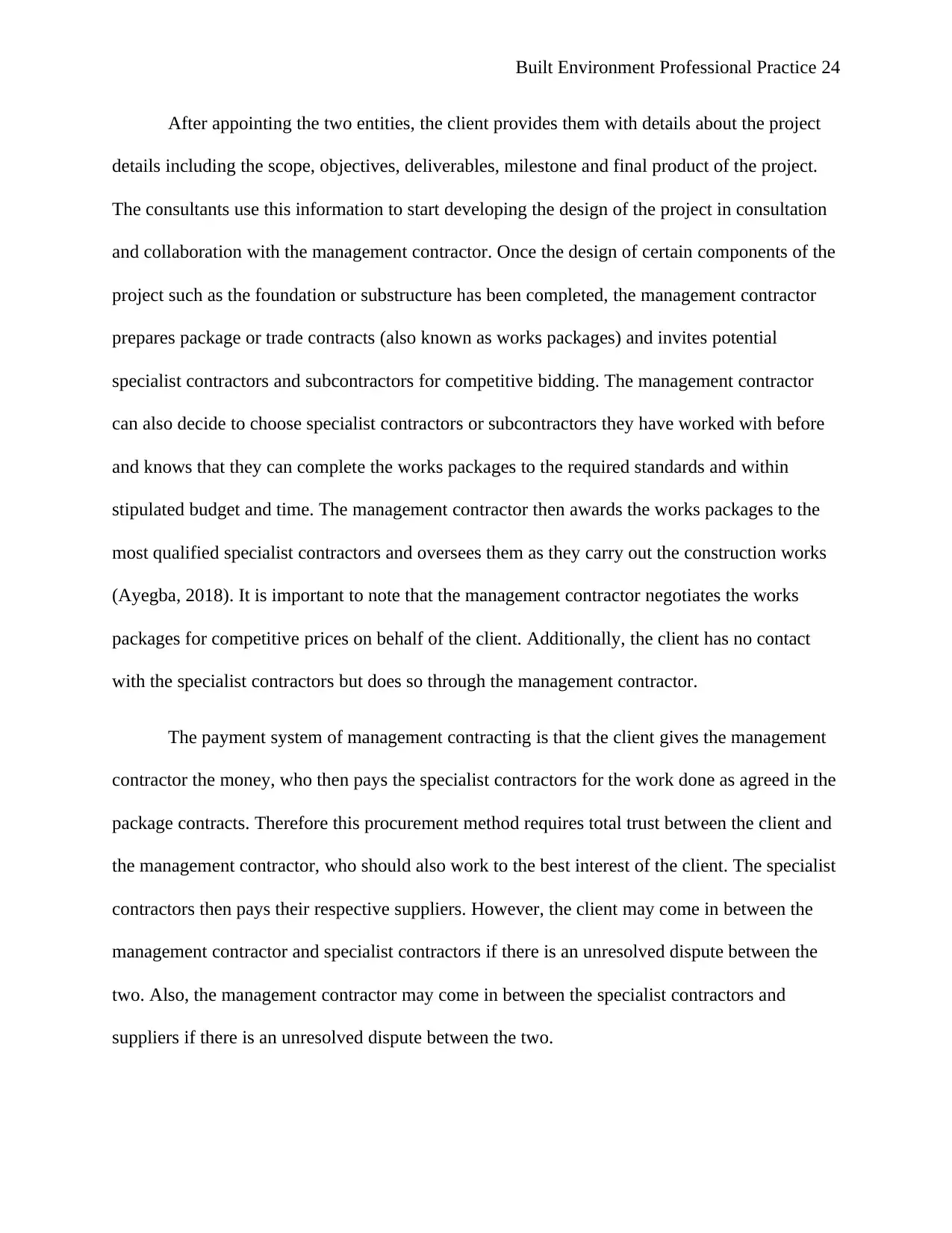
Built Environment Professional Practice 24
After appointing the two entities, the client provides them with details about the project
details including the scope, objectives, deliverables, milestone and final product of the project.
The consultants use this information to start developing the design of the project in consultation
and collaboration with the management contractor. Once the design of certain components of the
project such as the foundation or substructure has been completed, the management contractor
prepares package or trade contracts (also known as works packages) and invites potential
specialist contractors and subcontractors for competitive bidding. The management contractor
can also decide to choose specialist contractors or subcontractors they have worked with before
and knows that they can complete the works packages to the required standards and within
stipulated budget and time. The management contractor then awards the works packages to the
most qualified specialist contractors and oversees them as they carry out the construction works
(Ayegba, 2018). It is important to note that the management contractor negotiates the works
packages for competitive prices on behalf of the client. Additionally, the client has no contact
with the specialist contractors but does so through the management contractor.
The payment system of management contracting is that the client gives the management
contractor the money, who then pays the specialist contractors for the work done as agreed in the
package contracts. Therefore this procurement method requires total trust between the client and
the management contractor, who should also work to the best interest of the client. The specialist
contractors then pays their respective suppliers. However, the client may come in between the
management contractor and specialist contractors if there is an unresolved dispute between the
two. Also, the management contractor may come in between the specialist contractors and
suppliers if there is an unresolved dispute between the two.
After appointing the two entities, the client provides them with details about the project
details including the scope, objectives, deliverables, milestone and final product of the project.
The consultants use this information to start developing the design of the project in consultation
and collaboration with the management contractor. Once the design of certain components of the
project such as the foundation or substructure has been completed, the management contractor
prepares package or trade contracts (also known as works packages) and invites potential
specialist contractors and subcontractors for competitive bidding. The management contractor
can also decide to choose specialist contractors or subcontractors they have worked with before
and knows that they can complete the works packages to the required standards and within
stipulated budget and time. The management contractor then awards the works packages to the
most qualified specialist contractors and oversees them as they carry out the construction works
(Ayegba, 2018). It is important to note that the management contractor negotiates the works
packages for competitive prices on behalf of the client. Additionally, the client has no contact
with the specialist contractors but does so through the management contractor.
The payment system of management contracting is that the client gives the management
contractor the money, who then pays the specialist contractors for the work done as agreed in the
package contracts. Therefore this procurement method requires total trust between the client and
the management contractor, who should also work to the best interest of the client. The specialist
contractors then pays their respective suppliers. However, the client may come in between the
management contractor and specialist contractors if there is an unresolved dispute between the
two. Also, the management contractor may come in between the specialist contractors and
suppliers if there is an unresolved dispute between the two.
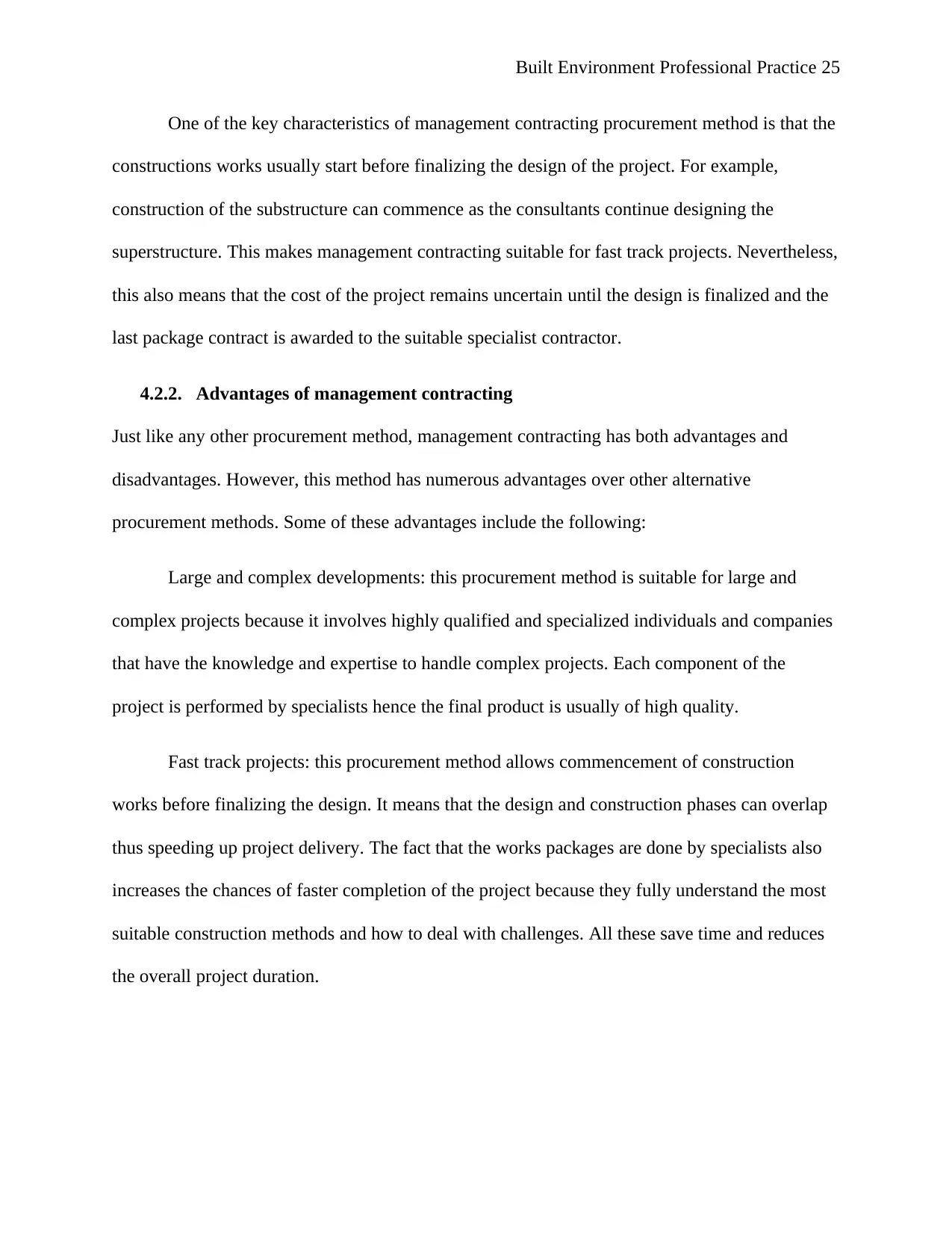
Built Environment Professional Practice 25
One of the key characteristics of management contracting procurement method is that the
constructions works usually start before finalizing the design of the project. For example,
construction of the substructure can commence as the consultants continue designing the
superstructure. This makes management contracting suitable for fast track projects. Nevertheless,
this also means that the cost of the project remains uncertain until the design is finalized and the
last package contract is awarded to the suitable specialist contractor.
4.2.2. Advantages of management contracting
Just like any other procurement method, management contracting has both advantages and
disadvantages. However, this method has numerous advantages over other alternative
procurement methods. Some of these advantages include the following:
Large and complex developments: this procurement method is suitable for large and
complex projects because it involves highly qualified and specialized individuals and companies
that have the knowledge and expertise to handle complex projects. Each component of the
project is performed by specialists hence the final product is usually of high quality.
Fast track projects: this procurement method allows commencement of construction
works before finalizing the design. It means that the design and construction phases can overlap
thus speeding up project delivery. The fact that the works packages are done by specialists also
increases the chances of faster completion of the project because they fully understand the most
suitable construction methods and how to deal with challenges. All these save time and reduces
the overall project duration.
One of the key characteristics of management contracting procurement method is that the
constructions works usually start before finalizing the design of the project. For example,
construction of the substructure can commence as the consultants continue designing the
superstructure. This makes management contracting suitable for fast track projects. Nevertheless,
this also means that the cost of the project remains uncertain until the design is finalized and the
last package contract is awarded to the suitable specialist contractor.
4.2.2. Advantages of management contracting
Just like any other procurement method, management contracting has both advantages and
disadvantages. However, this method has numerous advantages over other alternative
procurement methods. Some of these advantages include the following:
Large and complex developments: this procurement method is suitable for large and
complex projects because it involves highly qualified and specialized individuals and companies
that have the knowledge and expertise to handle complex projects. Each component of the
project is performed by specialists hence the final product is usually of high quality.
Fast track projects: this procurement method allows commencement of construction
works before finalizing the design. It means that the design and construction phases can overlap
thus speeding up project delivery. The fact that the works packages are done by specialists also
increases the chances of faster completion of the project because they fully understand the most
suitable construction methods and how to deal with challenges. All these save time and reduces
the overall project duration.
Secure Best Marks with AI Grader
Need help grading? Try our AI Grader for instant feedback on your assignments.
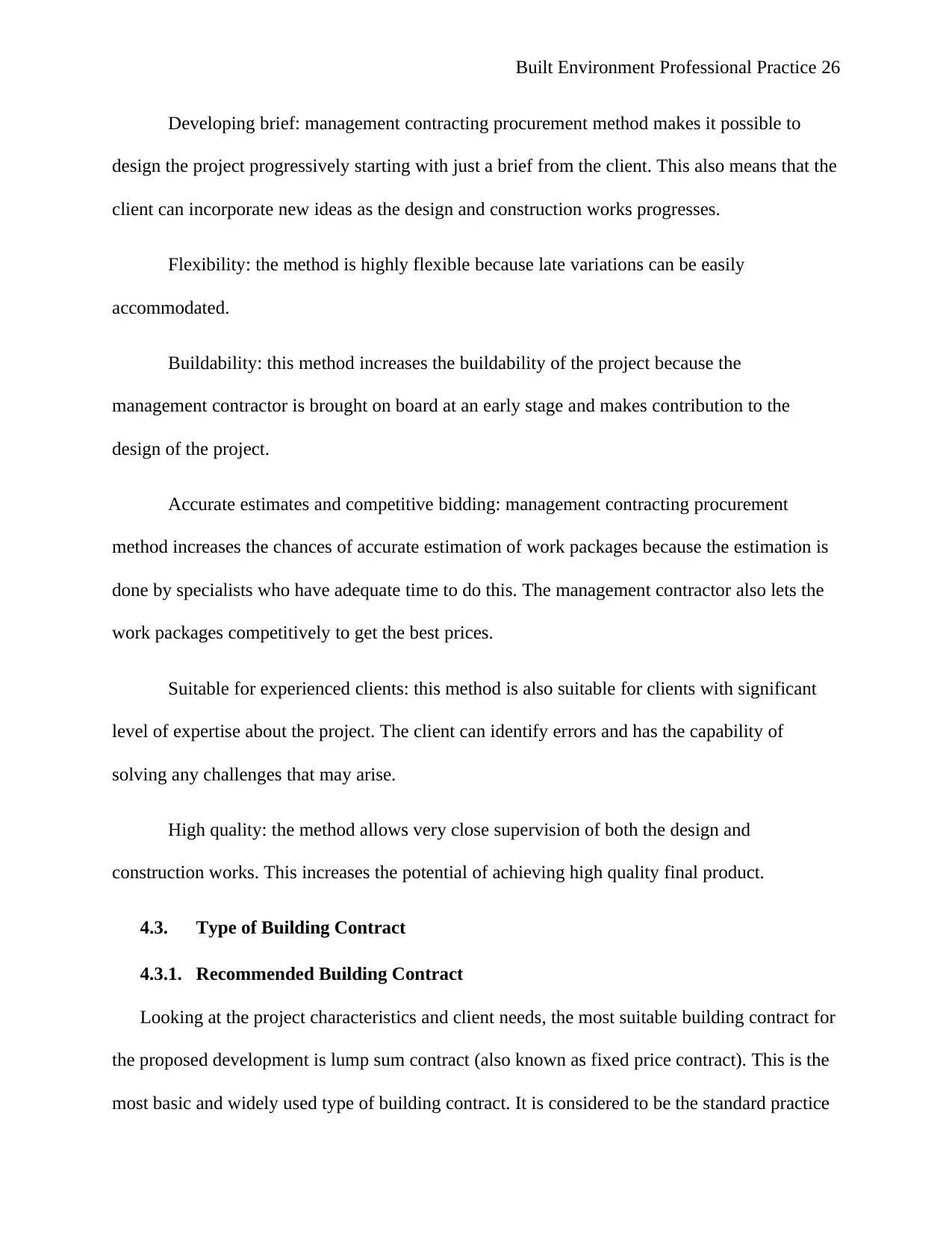
Built Environment Professional Practice 26
Developing brief: management contracting procurement method makes it possible to
design the project progressively starting with just a brief from the client. This also means that the
client can incorporate new ideas as the design and construction works progresses.
Flexibility: the method is highly flexible because late variations can be easily
accommodated.
Buildability: this method increases the buildability of the project because the
management contractor is brought on board at an early stage and makes contribution to the
design of the project.
Accurate estimates and competitive bidding: management contracting procurement
method increases the chances of accurate estimation of work packages because the estimation is
done by specialists who have adequate time to do this. The management contractor also lets the
work packages competitively to get the best prices.
Suitable for experienced clients: this method is also suitable for clients with significant
level of expertise about the project. The client can identify errors and has the capability of
solving any challenges that may arise.
High quality: the method allows very close supervision of both the design and
construction works. This increases the potential of achieving high quality final product.
4.3. Type of Building Contract
4.3.1. Recommended Building Contract
Looking at the project characteristics and client needs, the most suitable building contract for
the proposed development is lump sum contract (also known as fixed price contract). This is the
most basic and widely used type of building contract. It is considered to be the standard practice
Developing brief: management contracting procurement method makes it possible to
design the project progressively starting with just a brief from the client. This also means that the
client can incorporate new ideas as the design and construction works progresses.
Flexibility: the method is highly flexible because late variations can be easily
accommodated.
Buildability: this method increases the buildability of the project because the
management contractor is brought on board at an early stage and makes contribution to the
design of the project.
Accurate estimates and competitive bidding: management contracting procurement
method increases the chances of accurate estimation of work packages because the estimation is
done by specialists who have adequate time to do this. The management contractor also lets the
work packages competitively to get the best prices.
Suitable for experienced clients: this method is also suitable for clients with significant
level of expertise about the project. The client can identify errors and has the capability of
solving any challenges that may arise.
High quality: the method allows very close supervision of both the design and
construction works. This increases the potential of achieving high quality final product.
4.3. Type of Building Contract
4.3.1. Recommended Building Contract
Looking at the project characteristics and client needs, the most suitable building contract for
the proposed development is lump sum contract (also known as fixed price contract). This is the
most basic and widely used type of building contract. It is considered to be the standard practice
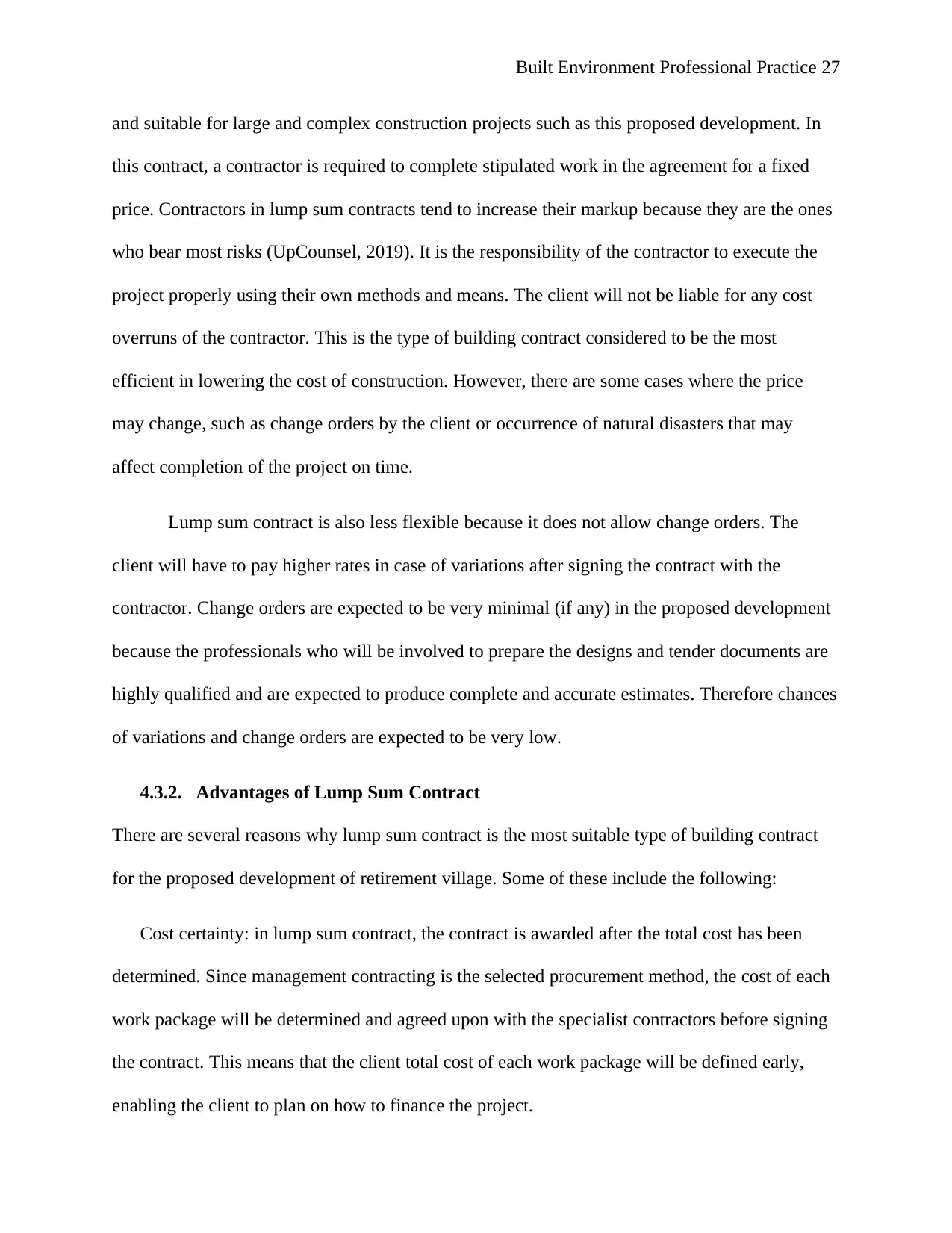
Built Environment Professional Practice 27
and suitable for large and complex construction projects such as this proposed development. In
this contract, a contractor is required to complete stipulated work in the agreement for a fixed
price. Contractors in lump sum contracts tend to increase their markup because they are the ones
who bear most risks (UpCounsel, 2019). It is the responsibility of the contractor to execute the
project properly using their own methods and means. The client will not be liable for any cost
overruns of the contractor. This is the type of building contract considered to be the most
efficient in lowering the cost of construction. However, there are some cases where the price
may change, such as change orders by the client or occurrence of natural disasters that may
affect completion of the project on time.
Lump sum contract is also less flexible because it does not allow change orders. The
client will have to pay higher rates in case of variations after signing the contract with the
contractor. Change orders are expected to be very minimal (if any) in the proposed development
because the professionals who will be involved to prepare the designs and tender documents are
highly qualified and are expected to produce complete and accurate estimates. Therefore chances
of variations and change orders are expected to be very low.
4.3.2. Advantages of Lump Sum Contract
There are several reasons why lump sum contract is the most suitable type of building contract
for the proposed development of retirement village. Some of these include the following:
Cost certainty: in lump sum contract, the contract is awarded after the total cost has been
determined. Since management contracting is the selected procurement method, the cost of each
work package will be determined and agreed upon with the specialist contractors before signing
the contract. This means that the client total cost of each work package will be defined early,
enabling the client to plan on how to finance the project.
and suitable for large and complex construction projects such as this proposed development. In
this contract, a contractor is required to complete stipulated work in the agreement for a fixed
price. Contractors in lump sum contracts tend to increase their markup because they are the ones
who bear most risks (UpCounsel, 2019). It is the responsibility of the contractor to execute the
project properly using their own methods and means. The client will not be liable for any cost
overruns of the contractor. This is the type of building contract considered to be the most
efficient in lowering the cost of construction. However, there are some cases where the price
may change, such as change orders by the client or occurrence of natural disasters that may
affect completion of the project on time.
Lump sum contract is also less flexible because it does not allow change orders. The
client will have to pay higher rates in case of variations after signing the contract with the
contractor. Change orders are expected to be very minimal (if any) in the proposed development
because the professionals who will be involved to prepare the designs and tender documents are
highly qualified and are expected to produce complete and accurate estimates. Therefore chances
of variations and change orders are expected to be very low.
4.3.2. Advantages of Lump Sum Contract
There are several reasons why lump sum contract is the most suitable type of building contract
for the proposed development of retirement village. Some of these include the following:
Cost certainty: in lump sum contract, the contract is awarded after the total cost has been
determined. Since management contracting is the selected procurement method, the cost of each
work package will be determined and agreed upon with the specialist contractors before signing
the contract. This means that the client total cost of each work package will be defined early,
enabling the client to plan on how to finance the project.
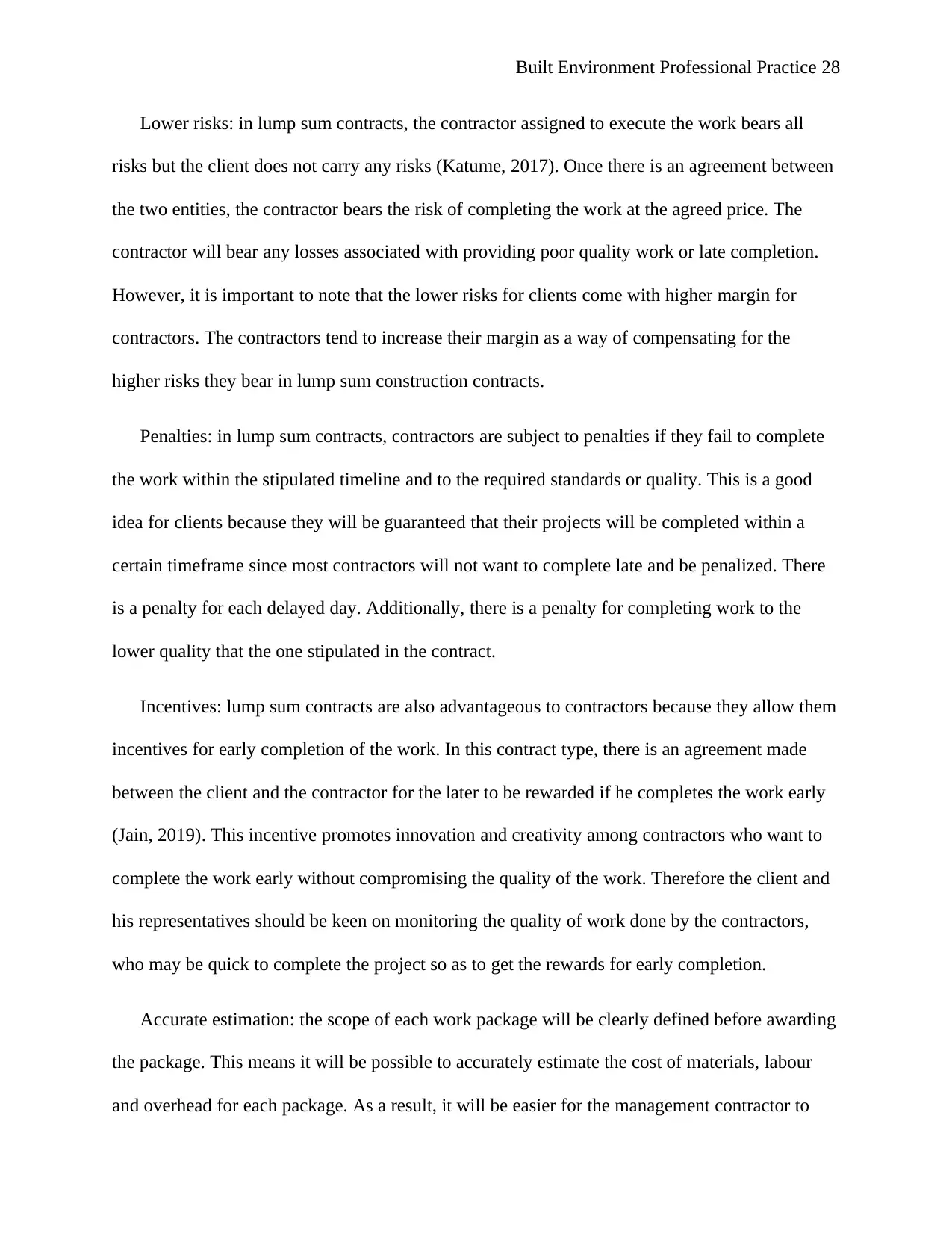
Built Environment Professional Practice 28
Lower risks: in lump sum contracts, the contractor assigned to execute the work bears all
risks but the client does not carry any risks (Katume, 2017). Once there is an agreement between
the two entities, the contractor bears the risk of completing the work at the agreed price. The
contractor will bear any losses associated with providing poor quality work or late completion.
However, it is important to note that the lower risks for clients come with higher margin for
contractors. The contractors tend to increase their margin as a way of compensating for the
higher risks they bear in lump sum construction contracts.
Penalties: in lump sum contracts, contractors are subject to penalties if they fail to complete
the work within the stipulated timeline and to the required standards or quality. This is a good
idea for clients because they will be guaranteed that their projects will be completed within a
certain timeframe since most contractors will not want to complete late and be penalized. There
is a penalty for each delayed day. Additionally, there is a penalty for completing work to the
lower quality that the one stipulated in the contract.
Incentives: lump sum contracts are also advantageous to contractors because they allow them
incentives for early completion of the work. In this contract type, there is an agreement made
between the client and the contractor for the later to be rewarded if he completes the work early
(Jain, 2019). This incentive promotes innovation and creativity among contractors who want to
complete the work early without compromising the quality of the work. Therefore the client and
his representatives should be keen on monitoring the quality of work done by the contractors,
who may be quick to complete the project so as to get the rewards for early completion.
Accurate estimation: the scope of each work package will be clearly defined before awarding
the package. This means it will be possible to accurately estimate the cost of materials, labour
and overhead for each package. As a result, it will be easier for the management contractor to
Lower risks: in lump sum contracts, the contractor assigned to execute the work bears all
risks but the client does not carry any risks (Katume, 2017). Once there is an agreement between
the two entities, the contractor bears the risk of completing the work at the agreed price. The
contractor will bear any losses associated with providing poor quality work or late completion.
However, it is important to note that the lower risks for clients come with higher margin for
contractors. The contractors tend to increase their margin as a way of compensating for the
higher risks they bear in lump sum construction contracts.
Penalties: in lump sum contracts, contractors are subject to penalties if they fail to complete
the work within the stipulated timeline and to the required standards or quality. This is a good
idea for clients because they will be guaranteed that their projects will be completed within a
certain timeframe since most contractors will not want to complete late and be penalized. There
is a penalty for each delayed day. Additionally, there is a penalty for completing work to the
lower quality that the one stipulated in the contract.
Incentives: lump sum contracts are also advantageous to contractors because they allow them
incentives for early completion of the work. In this contract type, there is an agreement made
between the client and the contractor for the later to be rewarded if he completes the work early
(Jain, 2019). This incentive promotes innovation and creativity among contractors who want to
complete the work early without compromising the quality of the work. Therefore the client and
his representatives should be keen on monitoring the quality of work done by the contractors,
who may be quick to complete the project so as to get the rewards for early completion.
Accurate estimation: the scope of each work package will be clearly defined before awarding
the package. This means it will be possible to accurately estimate the cost of materials, labour
and overhead for each package. As a result, it will be easier for the management contractor to
Paraphrase This Document
Need a fresh take? Get an instant paraphrase of this document with our AI Paraphraser
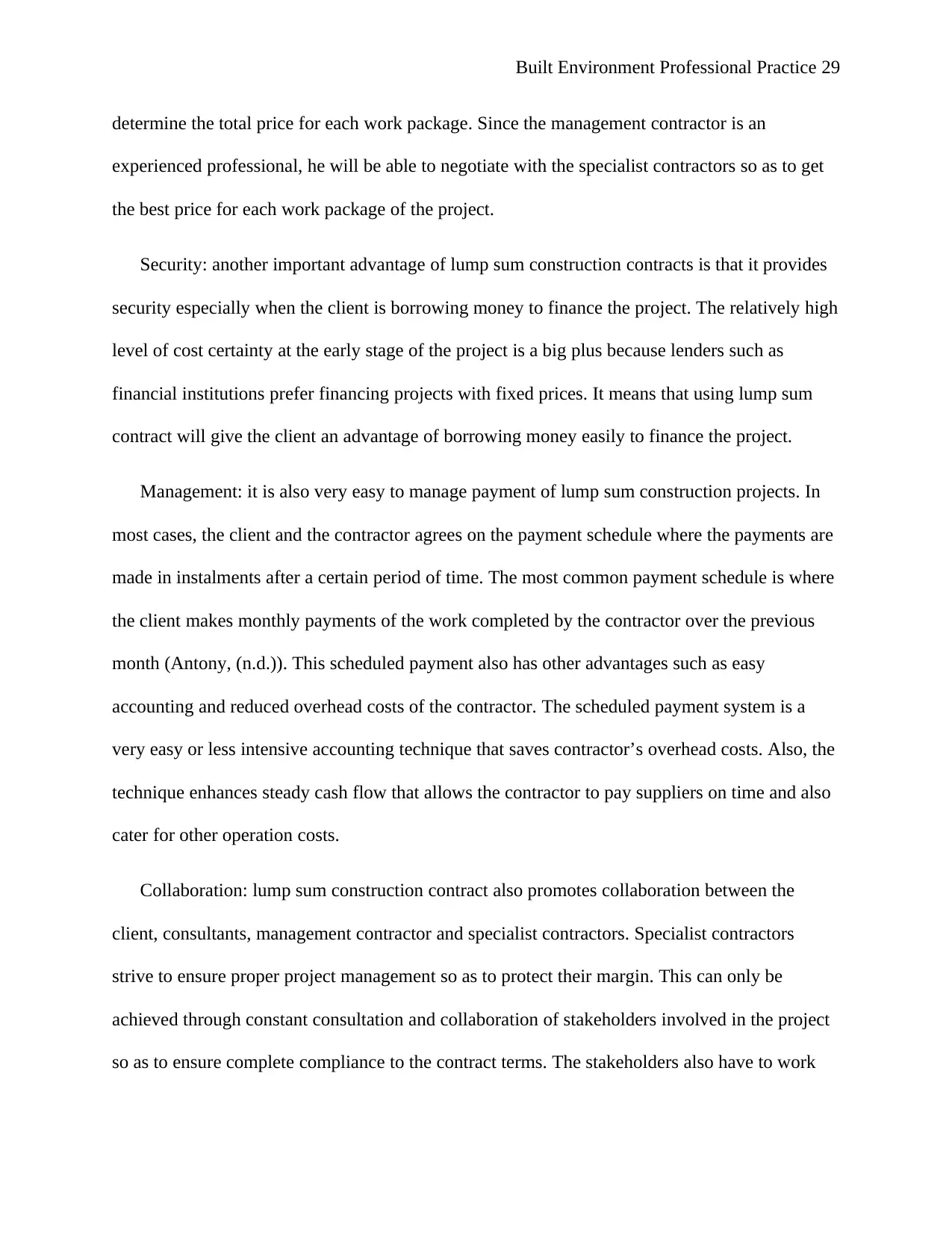
Built Environment Professional Practice 29
determine the total price for each work package. Since the management contractor is an
experienced professional, he will be able to negotiate with the specialist contractors so as to get
the best price for each work package of the project.
Security: another important advantage of lump sum construction contracts is that it provides
security especially when the client is borrowing money to finance the project. The relatively high
level of cost certainty at the early stage of the project is a big plus because lenders such as
financial institutions prefer financing projects with fixed prices. It means that using lump sum
contract will give the client an advantage of borrowing money easily to finance the project.
Management: it is also very easy to manage payment of lump sum construction projects. In
most cases, the client and the contractor agrees on the payment schedule where the payments are
made in instalments after a certain period of time. The most common payment schedule is where
the client makes monthly payments of the work completed by the contractor over the previous
month (Antony, (n.d.)). This scheduled payment also has other advantages such as easy
accounting and reduced overhead costs of the contractor. The scheduled payment system is a
very easy or less intensive accounting technique that saves contractor’s overhead costs. Also, the
technique enhances steady cash flow that allows the contractor to pay suppliers on time and also
cater for other operation costs.
Collaboration: lump sum construction contract also promotes collaboration between the
client, consultants, management contractor and specialist contractors. Specialist contractors
strive to ensure proper project management so as to protect their margin. This can only be
achieved through constant consultation and collaboration of stakeholders involved in the project
so as to ensure complete compliance to the contract terms. The stakeholders also have to work
determine the total price for each work package. Since the management contractor is an
experienced professional, he will be able to negotiate with the specialist contractors so as to get
the best price for each work package of the project.
Security: another important advantage of lump sum construction contracts is that it provides
security especially when the client is borrowing money to finance the project. The relatively high
level of cost certainty at the early stage of the project is a big plus because lenders such as
financial institutions prefer financing projects with fixed prices. It means that using lump sum
contract will give the client an advantage of borrowing money easily to finance the project.
Management: it is also very easy to manage payment of lump sum construction projects. In
most cases, the client and the contractor agrees on the payment schedule where the payments are
made in instalments after a certain period of time. The most common payment schedule is where
the client makes monthly payments of the work completed by the contractor over the previous
month (Antony, (n.d.)). This scheduled payment also has other advantages such as easy
accounting and reduced overhead costs of the contractor. The scheduled payment system is a
very easy or less intensive accounting technique that saves contractor’s overhead costs. Also, the
technique enhances steady cash flow that allows the contractor to pay suppliers on time and also
cater for other operation costs.
Collaboration: lump sum construction contract also promotes collaboration between the
client, consultants, management contractor and specialist contractors. Specialist contractors
strive to ensure proper project management so as to protect their margin. This can only be
achieved through constant consultation and collaboration of stakeholders involved in the project
so as to ensure complete compliance to the contract terms. The stakeholders also have to work

Built Environment Professional Practice 30
together so as to critically analyze any change orders and find the best way of implementing
them with the least risks.
It is evident that lump sum construction contract is not only beneficial to the client but also to the
contractor.
4.4. Roles and Risks
4.4.1. Roles and risks of the client
The roles of the client in the proposed development are: select and appoint competent and
experienced consultants, project manager and management contractor (and also sacking them);
provide or explain project brief and needs to the consultants, project manager and management
contractor; clearly define the roles, responsibilities and functions of the consultants, project
manager and management contractor; provide financial and other resources needed at different
stages of the project; verify and approve work done at every stage of the project before
proceeding to the next stage (Ai Solutions Ltd, 2015); ensure that necessary and complete
information is provided to all stakeholders involved in the project on time by providing effective
communication channels; supervise and occasionally check ongoing activities to ensure that they
comply with the required standards and regulations; enhance cooperation and coordination
between all stakeholders involved in the project; organize project progress meetings or request
for updates on the progress of the project; help in solving any disputes that may arise between
the consultants, project manager and management contractor; respond to any questions, requests
or enquiries made by other stakeholders involved in the project; approve or disapprove
completed work by the contractor; ensure that workers’ welfare is protected on site by providing
the necessary welfare facilities; review and maintain agreements to ensure that they remain
together so as to critically analyze any change orders and find the best way of implementing
them with the least risks.
It is evident that lump sum construction contract is not only beneficial to the client but also to the
contractor.
4.4. Roles and Risks
4.4.1. Roles and risks of the client
The roles of the client in the proposed development are: select and appoint competent and
experienced consultants, project manager and management contractor (and also sacking them);
provide or explain project brief and needs to the consultants, project manager and management
contractor; clearly define the roles, responsibilities and functions of the consultants, project
manager and management contractor; provide financial and other resources needed at different
stages of the project; verify and approve work done at every stage of the project before
proceeding to the next stage (Ai Solutions Ltd, 2015); ensure that necessary and complete
information is provided to all stakeholders involved in the project on time by providing effective
communication channels; supervise and occasionally check ongoing activities to ensure that they
comply with the required standards and regulations; enhance cooperation and coordination
between all stakeholders involved in the project; organize project progress meetings or request
for updates on the progress of the project; help in solving any disputes that may arise between
the consultants, project manager and management contractor; respond to any questions, requests
or enquiries made by other stakeholders involved in the project; approve or disapprove
completed work by the contractor; ensure that workers’ welfare is protected on site by providing
the necessary welfare facilities; review and maintain agreements to ensure that they remain

Built Environment Professional Practice 31
relevant and consistent throughout the project; and show leadership in all aspects of the project
(Wira, et al., 2009).
Some of the risks of the client in this project include: the final cost of the project exceeding
the estimate budget; late completion of the project; low quality of final project; poor performance
of contractors; shortage of resources; adverse weather; failure of contractors to perform as
required; poor safety; opposition from the public; political risks; regulatory risks; incurring
unnecessary or excessive costs; project cost uncertainty; and the main contractors going
bankrupt.
4.4.2. Roles and risks of architect
The roles of architect in this project are: ensuring that the client is aware of their duties
before starting to perform them; making sure that they have the required knowledge, skills and
experience to perform the work they have been appointed for; planning, monitoring and
managing safety and health during the pre-construction stage; compiling necessary
preconstruction information and sharing it with the project manager and management contractor;
cooperating and coordinating with all other stakeholders involved in the project; sharing any
necessary information with the other stakeholders to help them perform their duties more
diligently; reporting any instances they think may compromise the quality of work being done or
the safety and health of workers; preparing safety and health file and updating, revising and
reviewing it progressively throughout the project period; liaising with the project manager and
management contractor to assist in planning, coordination, managing and monitoring the
construction phase; ensuring that foreseeable risks are eliminated or putting in place design
measures that will minimize unforeseeable risks; ensuring that they create designs that meet the
needs of the client; enhancing cooperation and coordination between the client, project manager,
relevant and consistent throughout the project; and show leadership in all aspects of the project
(Wira, et al., 2009).
Some of the risks of the client in this project include: the final cost of the project exceeding
the estimate budget; late completion of the project; low quality of final project; poor performance
of contractors; shortage of resources; adverse weather; failure of contractors to perform as
required; poor safety; opposition from the public; political risks; regulatory risks; incurring
unnecessary or excessive costs; project cost uncertainty; and the main contractors going
bankrupt.
4.4.2. Roles and risks of architect
The roles of architect in this project are: ensuring that the client is aware of their duties
before starting to perform them; making sure that they have the required knowledge, skills and
experience to perform the work they have been appointed for; planning, monitoring and
managing safety and health during the pre-construction stage; compiling necessary
preconstruction information and sharing it with the project manager and management contractor;
cooperating and coordinating with all other stakeholders involved in the project; sharing any
necessary information with the other stakeholders to help them perform their duties more
diligently; reporting any instances they think may compromise the quality of work being done or
the safety and health of workers; preparing safety and health file and updating, revising and
reviewing it progressively throughout the project period; liaising with the project manager and
management contractor to assist in planning, coordination, managing and monitoring the
construction phase; ensuring that foreseeable risks are eliminated or putting in place design
measures that will minimize unforeseeable risks; ensuring that they create designs that meet the
needs of the client; enhancing cooperation and coordination between the client, project manager,
Secure Best Marks with AI Grader
Need help grading? Try our AI Grader for instant feedback on your assignments.
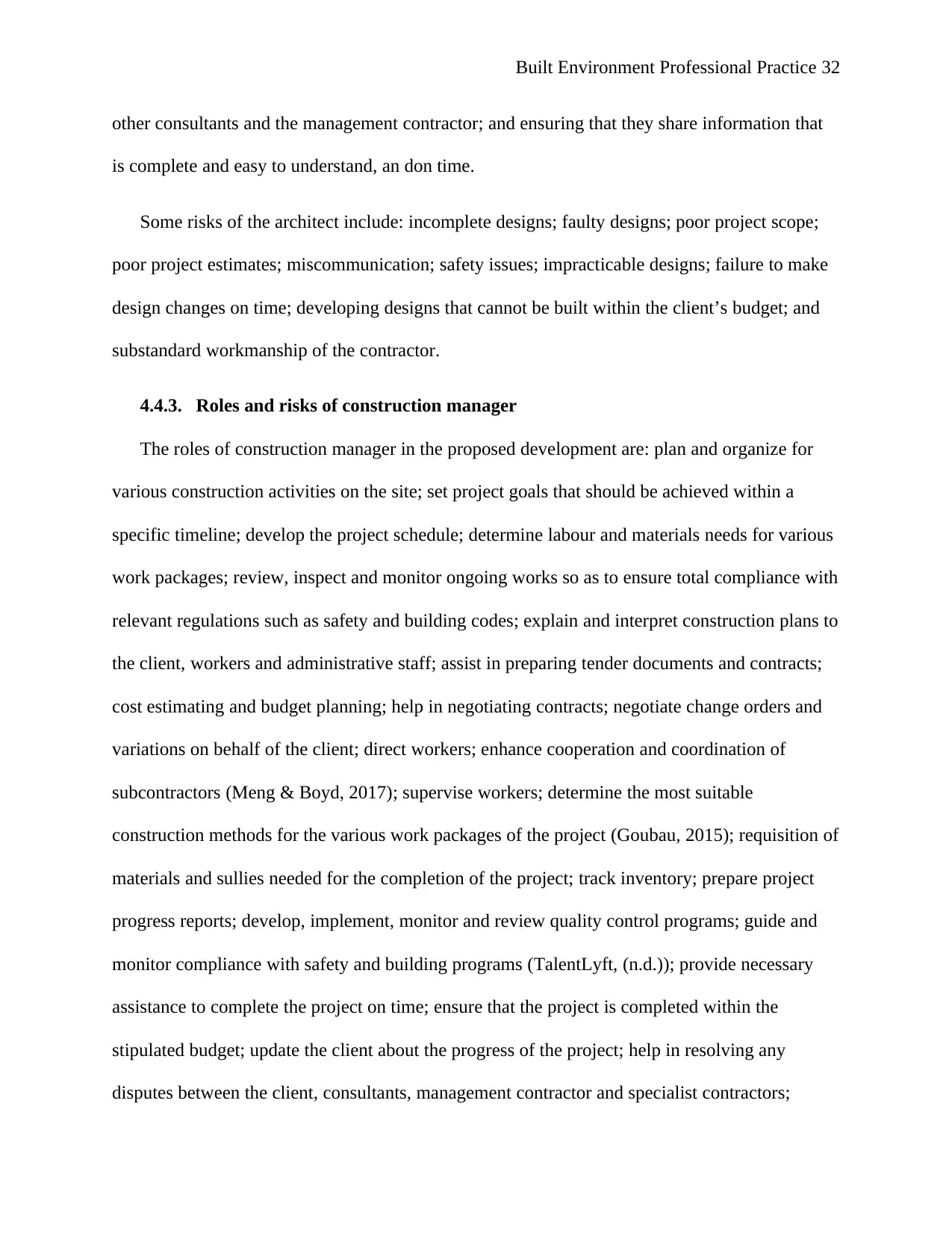
Built Environment Professional Practice 32
other consultants and the management contractor; and ensuring that they share information that
is complete and easy to understand, an don time.
Some risks of the architect include: incomplete designs; faulty designs; poor project scope;
poor project estimates; miscommunication; safety issues; impracticable designs; failure to make
design changes on time; developing designs that cannot be built within the client’s budget; and
substandard workmanship of the contractor.
4.4.3. Roles and risks of construction manager
The roles of construction manager in the proposed development are: plan and organize for
various construction activities on the site; set project goals that should be achieved within a
specific timeline; develop the project schedule; determine labour and materials needs for various
work packages; review, inspect and monitor ongoing works so as to ensure total compliance with
relevant regulations such as safety and building codes; explain and interpret construction plans to
the client, workers and administrative staff; assist in preparing tender documents and contracts;
cost estimating and budget planning; help in negotiating contracts; negotiate change orders and
variations on behalf of the client; direct workers; enhance cooperation and coordination of
subcontractors (Meng & Boyd, 2017); supervise workers; determine the most suitable
construction methods for the various work packages of the project (Goubau, 2015); requisition of
materials and sullies needed for the completion of the project; track inventory; prepare project
progress reports; develop, implement, monitor and review quality control programs; guide and
monitor compliance with safety and building programs (TalentLyft, (n.d.)); provide necessary
assistance to complete the project on time; ensure that the project is completed within the
stipulated budget; update the client about the progress of the project; help in resolving any
disputes between the client, consultants, management contractor and specialist contractors;
other consultants and the management contractor; and ensuring that they share information that
is complete and easy to understand, an don time.
Some risks of the architect include: incomplete designs; faulty designs; poor project scope;
poor project estimates; miscommunication; safety issues; impracticable designs; failure to make
design changes on time; developing designs that cannot be built within the client’s budget; and
substandard workmanship of the contractor.
4.4.3. Roles and risks of construction manager
The roles of construction manager in the proposed development are: plan and organize for
various construction activities on the site; set project goals that should be achieved within a
specific timeline; develop the project schedule; determine labour and materials needs for various
work packages; review, inspect and monitor ongoing works so as to ensure total compliance with
relevant regulations such as safety and building codes; explain and interpret construction plans to
the client, workers and administrative staff; assist in preparing tender documents and contracts;
cost estimating and budget planning; help in negotiating contracts; negotiate change orders and
variations on behalf of the client; direct workers; enhance cooperation and coordination of
subcontractors (Meng & Boyd, 2017); supervise workers; determine the most suitable
construction methods for the various work packages of the project (Goubau, 2015); requisition of
materials and sullies needed for the completion of the project; track inventory; prepare project
progress reports; develop, implement, monitor and review quality control programs; guide and
monitor compliance with safety and building programs (TalentLyft, (n.d.)); provide necessary
assistance to complete the project on time; ensure that the project is completed within the
stipulated budget; update the client about the progress of the project; help in resolving any
disputes between the client, consultants, management contractor and specialist contractors;

Built Environment Professional Practice 33
identify and implement strategies for managing risks; ensure that high quality construction
standards are met; and provide leadership (Anantatmula, 2010).
The risks of the construction manager include: un realistic project schedule; poor budget
estimates; miscommunication or sharing incomplete information; failure to manage variations;
poor quality work by contractors; failure to manage risks and resolve disputes; accidents; adverse
weather; natural disasters; poor quality work from contractors; loss of competent staff; failure to
get necessary resources from the client on time; disputes and conflicts; late completion; social
risks; political risks; and regulatory risks.
4.4.4. Roles and risks of contractor
The roles of the contractor in this project include: planning, monitoring and managing
construction work to ensure that it is done without safety and health risks; cooperating with other
stakeholders involved in the project so as to enhance smooth and successful project delivery;
complying with directions and instructions issued by the management contractor; ensuring that
they appoint subcontractors and suppliers with proper knowledge, experience, skills and
capability to accomplish the work they have been appointed for (Enshassi, et al., 2011);
identifying training needs and ensuring that their workers are trained on site where necessary;
ensuring safety of workers on site (Lee, et al., 2014); ensuring that all construction works on site
are supervised accordingly; issuing employees and workers instructions and information needed
to perform their work with zero health and safety risks; ensuring that the site is properly secured
and there is controlled access; liaising with the management contractor to ensure that welfare
facilities are provided on site; and ensuring that work completed is inspected and approved
before proceeding to the next stage of construction (Health and Safety Executive, 2015).
identify and implement strategies for managing risks; ensure that high quality construction
standards are met; and provide leadership (Anantatmula, 2010).
The risks of the construction manager include: un realistic project schedule; poor budget
estimates; miscommunication or sharing incomplete information; failure to manage variations;
poor quality work by contractors; failure to manage risks and resolve disputes; accidents; adverse
weather; natural disasters; poor quality work from contractors; loss of competent staff; failure to
get necessary resources from the client on time; disputes and conflicts; late completion; social
risks; political risks; and regulatory risks.
4.4.4. Roles and risks of contractor
The roles of the contractor in this project include: planning, monitoring and managing
construction work to ensure that it is done without safety and health risks; cooperating with other
stakeholders involved in the project so as to enhance smooth and successful project delivery;
complying with directions and instructions issued by the management contractor; ensuring that
they appoint subcontractors and suppliers with proper knowledge, experience, skills and
capability to accomplish the work they have been appointed for (Enshassi, et al., 2011);
identifying training needs and ensuring that their workers are trained on site where necessary;
ensuring safety of workers on site (Lee, et al., 2014); ensuring that all construction works on site
are supervised accordingly; issuing employees and workers instructions and information needed
to perform their work with zero health and safety risks; ensuring that the site is properly secured
and there is controlled access; liaising with the management contractor to ensure that welfare
facilities are provided on site; and ensuring that work completed is inspected and approved
before proceeding to the next stage of construction (Health and Safety Executive, 2015).
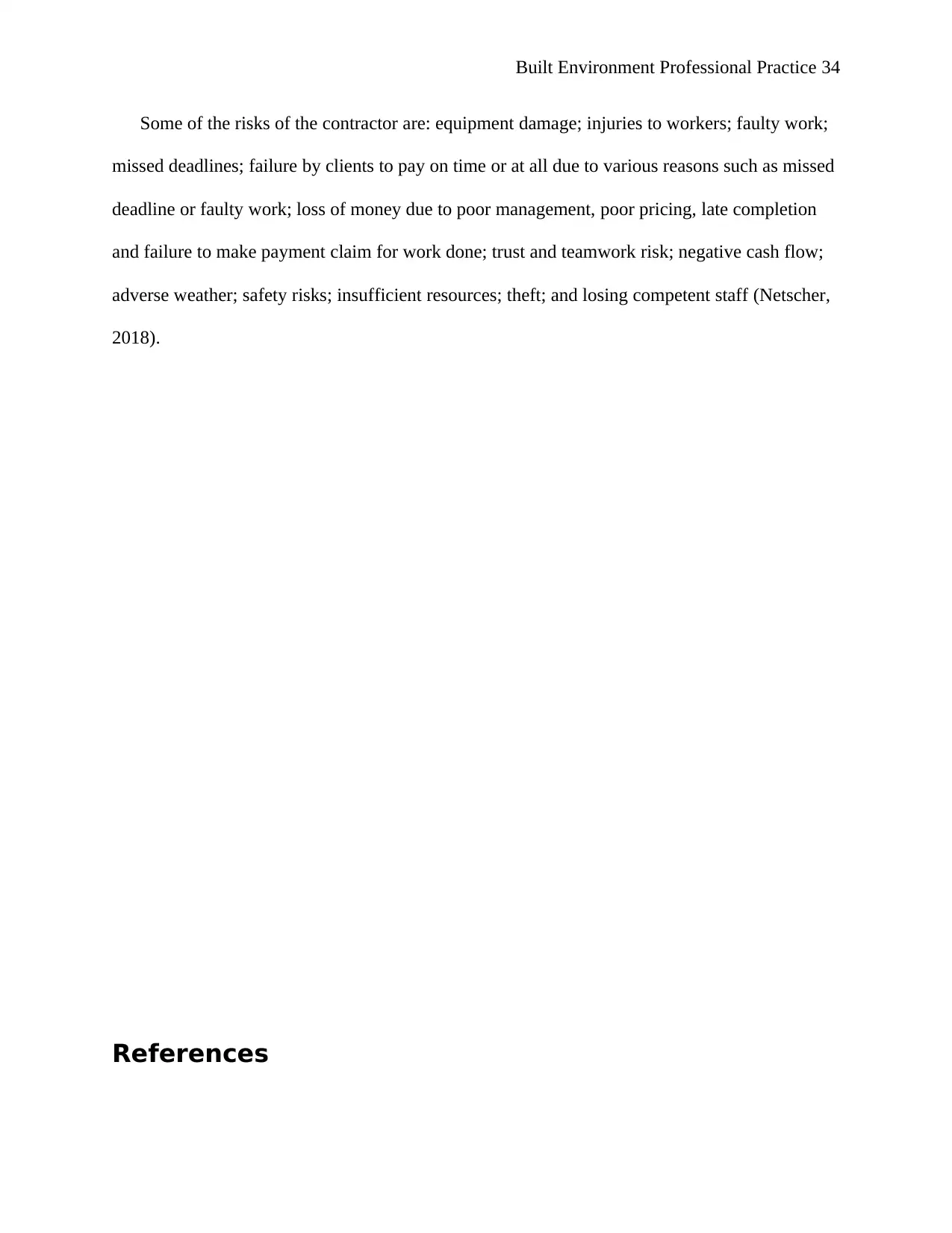
Built Environment Professional Practice 34
Some of the risks of the contractor are: equipment damage; injuries to workers; faulty work;
missed deadlines; failure by clients to pay on time or at all due to various reasons such as missed
deadline or faulty work; loss of money due to poor management, poor pricing, late completion
and failure to make payment claim for work done; trust and teamwork risk; negative cash flow;
adverse weather; safety risks; insufficient resources; theft; and losing competent staff (Netscher,
2018).
References
Some of the risks of the contractor are: equipment damage; injuries to workers; faulty work;
missed deadlines; failure by clients to pay on time or at all due to various reasons such as missed
deadline or faulty work; loss of money due to poor management, poor pricing, late completion
and failure to make payment claim for work done; trust and teamwork risk; negative cash flow;
adverse weather; safety risks; insufficient resources; theft; and losing competent staff (Netscher,
2018).
References
Paraphrase This Document
Need a fresh take? Get an instant paraphrase of this document with our AI Paraphraser
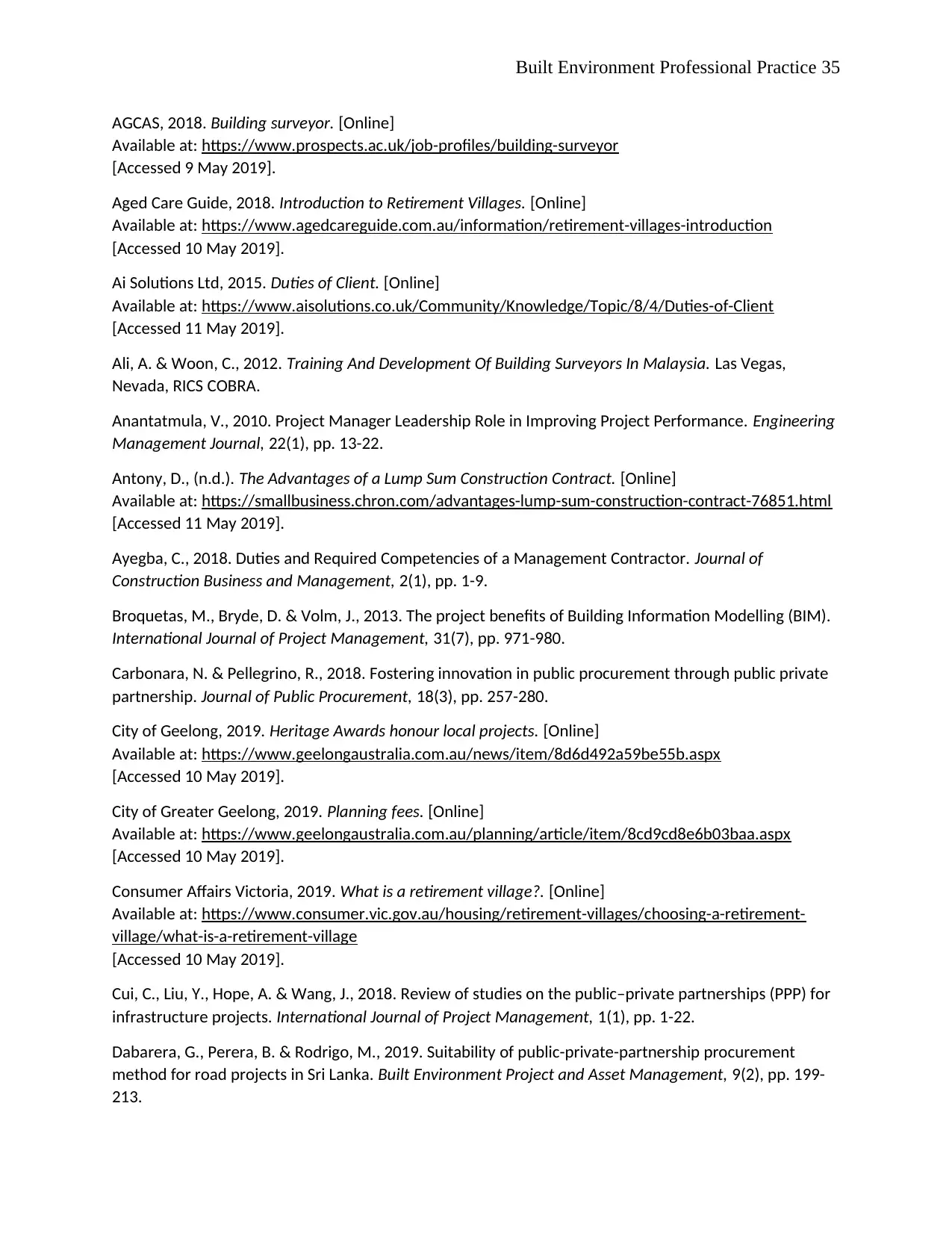
Built Environment Professional Practice 35
AGCAS, 2018. Building surveyor. [Online]
Available at: https://www.prospects.ac.uk/job-profiles/building-surveyor
[Accessed 9 May 2019].
Aged Care Guide, 2018. Introduction to Retirement Villages. [Online]
Available at: https://www.agedcareguide.com.au/information/retirement-villages-introduction
[Accessed 10 May 2019].
Ai Solutions Ltd, 2015. Duties of Client. [Online]
Available at: https://www.aisolutions.co.uk/Community/Knowledge/Topic/8/4/Duties-of-Client
[Accessed 11 May 2019].
Ali, A. & Woon, C., 2012. Training And Development Of Building Surveyors In Malaysia. Las Vegas,
Nevada, RICS COBRA.
Anantatmula, V., 2010. Project Manager Leadership Role in Improving Project Performance. Engineering
Management Journal, 22(1), pp. 13-22.
Antony, D., (n.d.). The Advantages of a Lump Sum Construction Contract. [Online]
Available at: https://smallbusiness.chron.com/advantages-lump-sum-construction-contract-76851.html
[Accessed 11 May 2019].
Ayegba, C., 2018. Duties and Required Competencies of a Management Contractor. Journal of
Construction Business and Management, 2(1), pp. 1-9.
Broquetas, M., Bryde, D. & Volm, J., 2013. The project benefits of Building Information Modelling (BIM).
International Journal of Project Management, 31(7), pp. 971-980.
Carbonara, N. & Pellegrino, R., 2018. Fostering innovation in public procurement through public private
partnership. Journal of Public Procurement, 18(3), pp. 257-280.
City of Geelong, 2019. Heritage Awards honour local projects. [Online]
Available at: https://www.geelongaustralia.com.au/news/item/8d6d492a59be55b.aspx
[Accessed 10 May 2019].
City of Greater Geelong, 2019. Planning fees. [Online]
Available at: https://www.geelongaustralia.com.au/planning/article/item/8cd9cd8e6b03baa.aspx
[Accessed 10 May 2019].
Consumer Affairs Victoria, 2019. What is a retirement village?. [Online]
Available at: https://www.consumer.vic.gov.au/housing/retirement-villages/choosing-a-retirement-
village/what-is-a-retirement-village
[Accessed 10 May 2019].
Cui, C., Liu, Y., Hope, A. & Wang, J., 2018. Review of studies on the public–private partnerships (PPP) for
infrastructure projects. International Journal of Project Management, 1(1), pp. 1-22.
Dabarera, G., Perera, B. & Rodrigo, M., 2019. Suitability of public-private-partnership procurement
method for road projects in Sri Lanka. Built Environment Project and Asset Management, 9(2), pp. 199-
213.
AGCAS, 2018. Building surveyor. [Online]
Available at: https://www.prospects.ac.uk/job-profiles/building-surveyor
[Accessed 9 May 2019].
Aged Care Guide, 2018. Introduction to Retirement Villages. [Online]
Available at: https://www.agedcareguide.com.au/information/retirement-villages-introduction
[Accessed 10 May 2019].
Ai Solutions Ltd, 2015. Duties of Client. [Online]
Available at: https://www.aisolutions.co.uk/Community/Knowledge/Topic/8/4/Duties-of-Client
[Accessed 11 May 2019].
Ali, A. & Woon, C., 2012. Training And Development Of Building Surveyors In Malaysia. Las Vegas,
Nevada, RICS COBRA.
Anantatmula, V., 2010. Project Manager Leadership Role in Improving Project Performance. Engineering
Management Journal, 22(1), pp. 13-22.
Antony, D., (n.d.). The Advantages of a Lump Sum Construction Contract. [Online]
Available at: https://smallbusiness.chron.com/advantages-lump-sum-construction-contract-76851.html
[Accessed 11 May 2019].
Ayegba, C., 2018. Duties and Required Competencies of a Management Contractor. Journal of
Construction Business and Management, 2(1), pp. 1-9.
Broquetas, M., Bryde, D. & Volm, J., 2013. The project benefits of Building Information Modelling (BIM).
International Journal of Project Management, 31(7), pp. 971-980.
Carbonara, N. & Pellegrino, R., 2018. Fostering innovation in public procurement through public private
partnership. Journal of Public Procurement, 18(3), pp. 257-280.
City of Geelong, 2019. Heritage Awards honour local projects. [Online]
Available at: https://www.geelongaustralia.com.au/news/item/8d6d492a59be55b.aspx
[Accessed 10 May 2019].
City of Greater Geelong, 2019. Planning fees. [Online]
Available at: https://www.geelongaustralia.com.au/planning/article/item/8cd9cd8e6b03baa.aspx
[Accessed 10 May 2019].
Consumer Affairs Victoria, 2019. What is a retirement village?. [Online]
Available at: https://www.consumer.vic.gov.au/housing/retirement-villages/choosing-a-retirement-
village/what-is-a-retirement-village
[Accessed 10 May 2019].
Cui, C., Liu, Y., Hope, A. & Wang, J., 2018. Review of studies on the public–private partnerships (PPP) for
infrastructure projects. International Journal of Project Management, 1(1), pp. 1-22.
Dabarera, G., Perera, B. & Rodrigo, M., 2019. Suitability of public-private-partnership procurement
method for road projects in Sri Lanka. Built Environment Project and Asset Management, 9(2), pp. 199-
213.
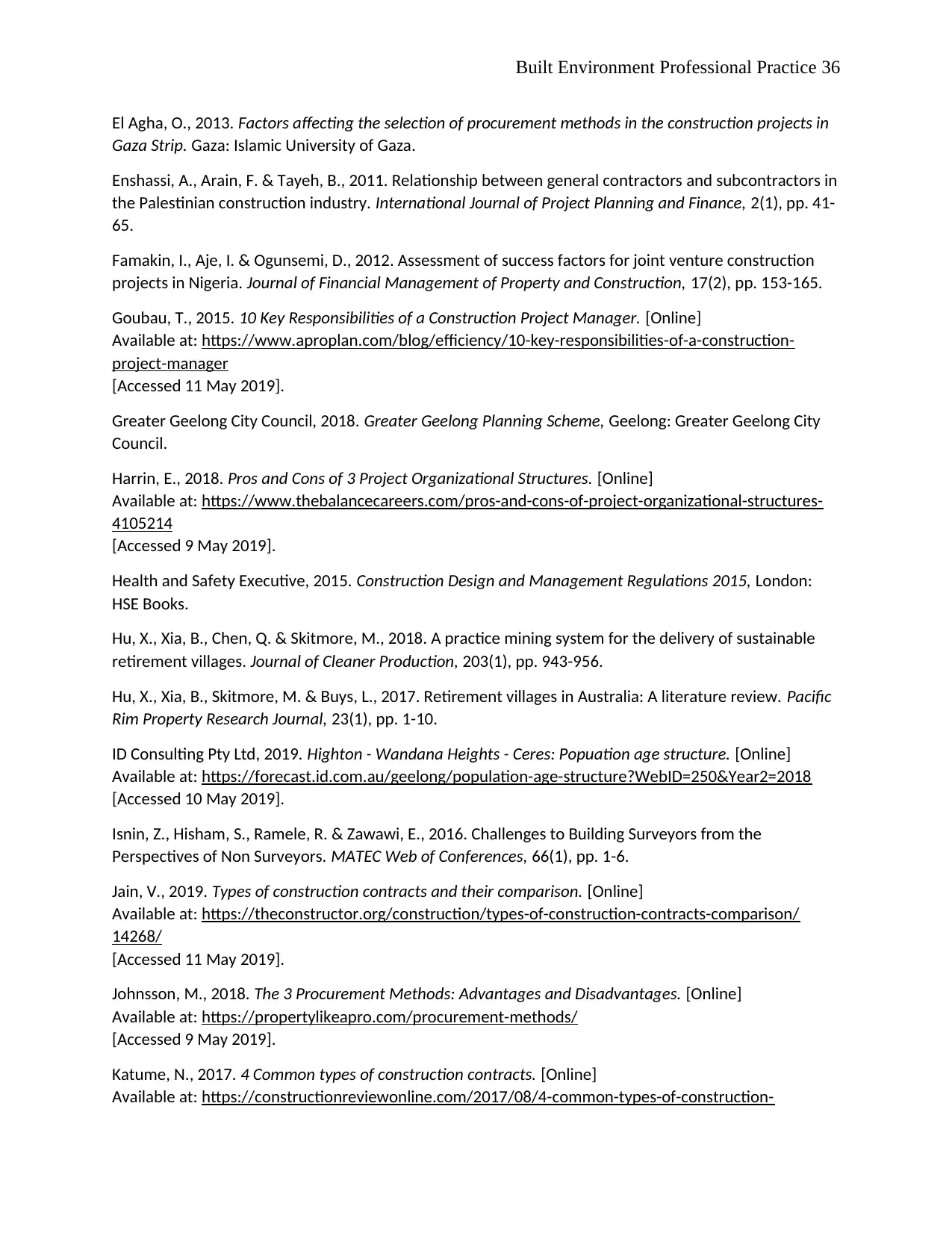
Built Environment Professional Practice 36
El Agha, O., 2013. Factors affecting the selection of procurement methods in the construction projects in
Gaza Strip. Gaza: Islamic University of Gaza.
Enshassi, A., Arain, F. & Tayeh, B., 2011. Relationship between general contractors and subcontractors in
the Palestinian construction industry. International Journal of Project Planning and Finance, 2(1), pp. 41-
65.
Famakin, I., Aje, I. & Ogunsemi, D., 2012. Assessment of success factors for joint venture construction
projects in Nigeria. Journal of Financial Management of Property and Construction, 17(2), pp. 153-165.
Goubau, T., 2015. 10 Key Responsibilities of a Construction Project Manager. [Online]
Available at: https://www.aproplan.com/blog/efficiency/10-key-responsibilities-of-a-construction-
project-manager
[Accessed 11 May 2019].
Greater Geelong City Council, 2018. Greater Geelong Planning Scheme, Geelong: Greater Geelong City
Council.
Harrin, E., 2018. Pros and Cons of 3 Project Organizational Structures. [Online]
Available at: https://www.thebalancecareers.com/pros-and-cons-of-project-organizational-structures-
4105214
[Accessed 9 May 2019].
Health and Safety Executive, 2015. Construction Design and Management Regulations 2015, London:
HSE Books.
Hu, X., Xia, B., Chen, Q. & Skitmore, M., 2018. A practice mining system for the delivery of sustainable
retirement villages. Journal of Cleaner Production, 203(1), pp. 943-956.
Hu, X., Xia, B., Skitmore, M. & Buys, L., 2017. Retirement villages in Australia: A literature review. Pacific
Rim Property Research Journal, 23(1), pp. 1-10.
ID Consulting Pty Ltd, 2019. Highton - Wandana Heights - Ceres: Popuation age structure. [Online]
Available at: https://forecast.id.com.au/geelong/population-age-structure?WebID=250&Year2=2018
[Accessed 10 May 2019].
Isnin, Z., Hisham, S., Ramele, R. & Zawawi, E., 2016. Challenges to Building Surveyors from the
Perspectives of Non Surveyors. MATEC Web of Conferences, 66(1), pp. 1-6.
Jain, V., 2019. Types of construction contracts and their comparison. [Online]
Available at: https://theconstructor.org/construction/types-of-construction-contracts-comparison/
14268/
[Accessed 11 May 2019].
Johnsson, M., 2018. The 3 Procurement Methods: Advantages and Disadvantages. [Online]
Available at: https://propertylikeapro.com/procurement-methods/
[Accessed 9 May 2019].
Katume, N., 2017. 4 Common types of construction contracts. [Online]
Available at: https://constructionreviewonline.com/2017/08/4-common-types-of-construction-
El Agha, O., 2013. Factors affecting the selection of procurement methods in the construction projects in
Gaza Strip. Gaza: Islamic University of Gaza.
Enshassi, A., Arain, F. & Tayeh, B., 2011. Relationship between general contractors and subcontractors in
the Palestinian construction industry. International Journal of Project Planning and Finance, 2(1), pp. 41-
65.
Famakin, I., Aje, I. & Ogunsemi, D., 2012. Assessment of success factors for joint venture construction
projects in Nigeria. Journal of Financial Management of Property and Construction, 17(2), pp. 153-165.
Goubau, T., 2015. 10 Key Responsibilities of a Construction Project Manager. [Online]
Available at: https://www.aproplan.com/blog/efficiency/10-key-responsibilities-of-a-construction-
project-manager
[Accessed 11 May 2019].
Greater Geelong City Council, 2018. Greater Geelong Planning Scheme, Geelong: Greater Geelong City
Council.
Harrin, E., 2018. Pros and Cons of 3 Project Organizational Structures. [Online]
Available at: https://www.thebalancecareers.com/pros-and-cons-of-project-organizational-structures-
4105214
[Accessed 9 May 2019].
Health and Safety Executive, 2015. Construction Design and Management Regulations 2015, London:
HSE Books.
Hu, X., Xia, B., Chen, Q. & Skitmore, M., 2018. A practice mining system for the delivery of sustainable
retirement villages. Journal of Cleaner Production, 203(1), pp. 943-956.
Hu, X., Xia, B., Skitmore, M. & Buys, L., 2017. Retirement villages in Australia: A literature review. Pacific
Rim Property Research Journal, 23(1), pp. 1-10.
ID Consulting Pty Ltd, 2019. Highton - Wandana Heights - Ceres: Popuation age structure. [Online]
Available at: https://forecast.id.com.au/geelong/population-age-structure?WebID=250&Year2=2018
[Accessed 10 May 2019].
Isnin, Z., Hisham, S., Ramele, R. & Zawawi, E., 2016. Challenges to Building Surveyors from the
Perspectives of Non Surveyors. MATEC Web of Conferences, 66(1), pp. 1-6.
Jain, V., 2019. Types of construction contracts and their comparison. [Online]
Available at: https://theconstructor.org/construction/types-of-construction-contracts-comparison/
14268/
[Accessed 11 May 2019].
Johnsson, M., 2018. The 3 Procurement Methods: Advantages and Disadvantages. [Online]
Available at: https://propertylikeapro.com/procurement-methods/
[Accessed 9 May 2019].
Katume, N., 2017. 4 Common types of construction contracts. [Online]
Available at: https://constructionreviewonline.com/2017/08/4-common-types-of-construction-
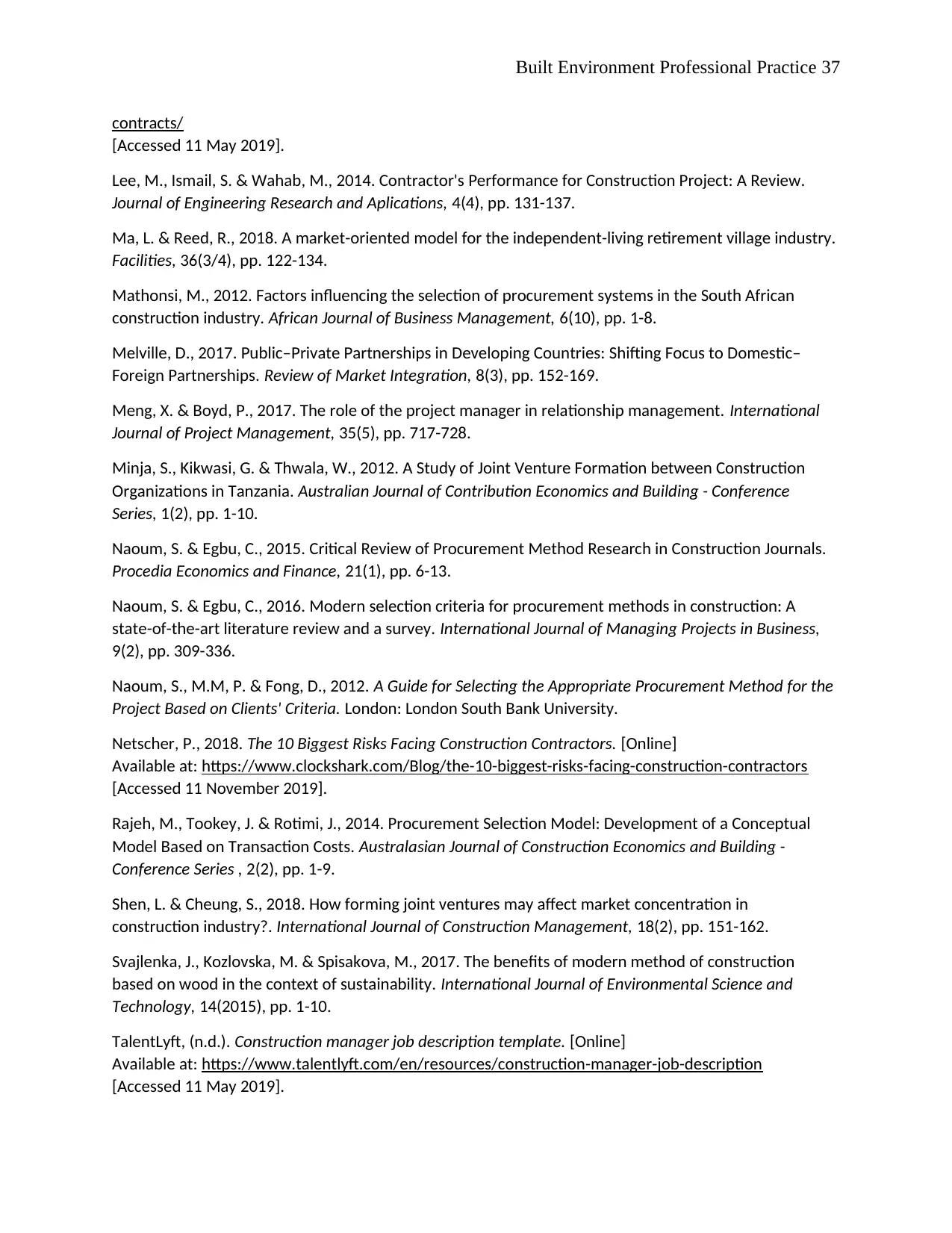
Built Environment Professional Practice 37
contracts/
[Accessed 11 May 2019].
Lee, M., Ismail, S. & Wahab, M., 2014. Contractor's Performance for Construction Project: A Review.
Journal of Engineering Research and Aplications, 4(4), pp. 131-137.
Ma, L. & Reed, R., 2018. A market-oriented model for the independent-living retirement village industry.
Facilities, 36(3/4), pp. 122-134.
Mathonsi, M., 2012. Factors influencing the selection of procurement systems in the South African
construction industry. African Journal of Business Management, 6(10), pp. 1-8.
Melville, D., 2017. Public–Private Partnerships in Developing Countries: Shifting Focus to Domestic–
Foreign Partnerships. Review of Market Integration, 8(3), pp. 152-169.
Meng, X. & Boyd, P., 2017. The role of the project manager in relationship management. International
Journal of Project Management, 35(5), pp. 717-728.
Minja, S., Kikwasi, G. & Thwala, W., 2012. A Study of Joint Venture Formation between Construction
Organizations in Tanzania. Australian Journal of Contribution Economics and Building - Conference
Series, 1(2), pp. 1-10.
Naoum, S. & Egbu, C., 2015. Critical Review of Procurement Method Research in Construction Journals.
Procedia Economics and Finance, 21(1), pp. 6-13.
Naoum, S. & Egbu, C., 2016. Modern selection criteria for procurement methods in construction: A
state-of-the-art literature review and a survey. International Journal of Managing Projects in Business,
9(2), pp. 309-336.
Naoum, S., M.M, P. & Fong, D., 2012. A Guide for Selecting the Appropriate Procurement Method for the
Project Based on Clients' Criteria. London: London South Bank University.
Netscher, P., 2018. The 10 Biggest Risks Facing Construction Contractors. [Online]
Available at: https://www.clockshark.com/Blog/the-10-biggest-risks-facing-construction-contractors
[Accessed 11 November 2019].
Rajeh, M., Tookey, J. & Rotimi, J., 2014. Procurement Selection Model: Development of a Conceptual
Model Based on Transaction Costs. Australasian Journal of Construction Economics and Building -
Conference Series , 2(2), pp. 1-9.
Shen, L. & Cheung, S., 2018. How forming joint ventures may affect market concentration in
construction industry?. International Journal of Construction Management, 18(2), pp. 151-162.
Svajlenka, J., Kozlovska, M. & Spisakova, M., 2017. The benefits of modern method of construction
based on wood in the context of sustainability. International Journal of Environmental Science and
Technology, 14(2015), pp. 1-10.
TalentLyft, (n.d.). Construction manager job description template. [Online]
Available at: https://www.talentlyft.com/en/resources/construction-manager-job-description
[Accessed 11 May 2019].
contracts/
[Accessed 11 May 2019].
Lee, M., Ismail, S. & Wahab, M., 2014. Contractor's Performance for Construction Project: A Review.
Journal of Engineering Research and Aplications, 4(4), pp. 131-137.
Ma, L. & Reed, R., 2018. A market-oriented model for the independent-living retirement village industry.
Facilities, 36(3/4), pp. 122-134.
Mathonsi, M., 2012. Factors influencing the selection of procurement systems in the South African
construction industry. African Journal of Business Management, 6(10), pp. 1-8.
Melville, D., 2017. Public–Private Partnerships in Developing Countries: Shifting Focus to Domestic–
Foreign Partnerships. Review of Market Integration, 8(3), pp. 152-169.
Meng, X. & Boyd, P., 2017. The role of the project manager in relationship management. International
Journal of Project Management, 35(5), pp. 717-728.
Minja, S., Kikwasi, G. & Thwala, W., 2012. A Study of Joint Venture Formation between Construction
Organizations in Tanzania. Australian Journal of Contribution Economics and Building - Conference
Series, 1(2), pp. 1-10.
Naoum, S. & Egbu, C., 2015. Critical Review of Procurement Method Research in Construction Journals.
Procedia Economics and Finance, 21(1), pp. 6-13.
Naoum, S. & Egbu, C., 2016. Modern selection criteria for procurement methods in construction: A
state-of-the-art literature review and a survey. International Journal of Managing Projects in Business,
9(2), pp. 309-336.
Naoum, S., M.M, P. & Fong, D., 2012. A Guide for Selecting the Appropriate Procurement Method for the
Project Based on Clients' Criteria. London: London South Bank University.
Netscher, P., 2018. The 10 Biggest Risks Facing Construction Contractors. [Online]
Available at: https://www.clockshark.com/Blog/the-10-biggest-risks-facing-construction-contractors
[Accessed 11 November 2019].
Rajeh, M., Tookey, J. & Rotimi, J., 2014. Procurement Selection Model: Development of a Conceptual
Model Based on Transaction Costs. Australasian Journal of Construction Economics and Building -
Conference Series , 2(2), pp. 1-9.
Shen, L. & Cheung, S., 2018. How forming joint ventures may affect market concentration in
construction industry?. International Journal of Construction Management, 18(2), pp. 151-162.
Svajlenka, J., Kozlovska, M. & Spisakova, M., 2017. The benefits of modern method of construction
based on wood in the context of sustainability. International Journal of Environmental Science and
Technology, 14(2015), pp. 1-10.
TalentLyft, (n.d.). Construction manager job description template. [Online]
Available at: https://www.talentlyft.com/en/resources/construction-manager-job-description
[Accessed 11 May 2019].
Secure Best Marks with AI Grader
Need help grading? Try our AI Grader for instant feedback on your assignments.
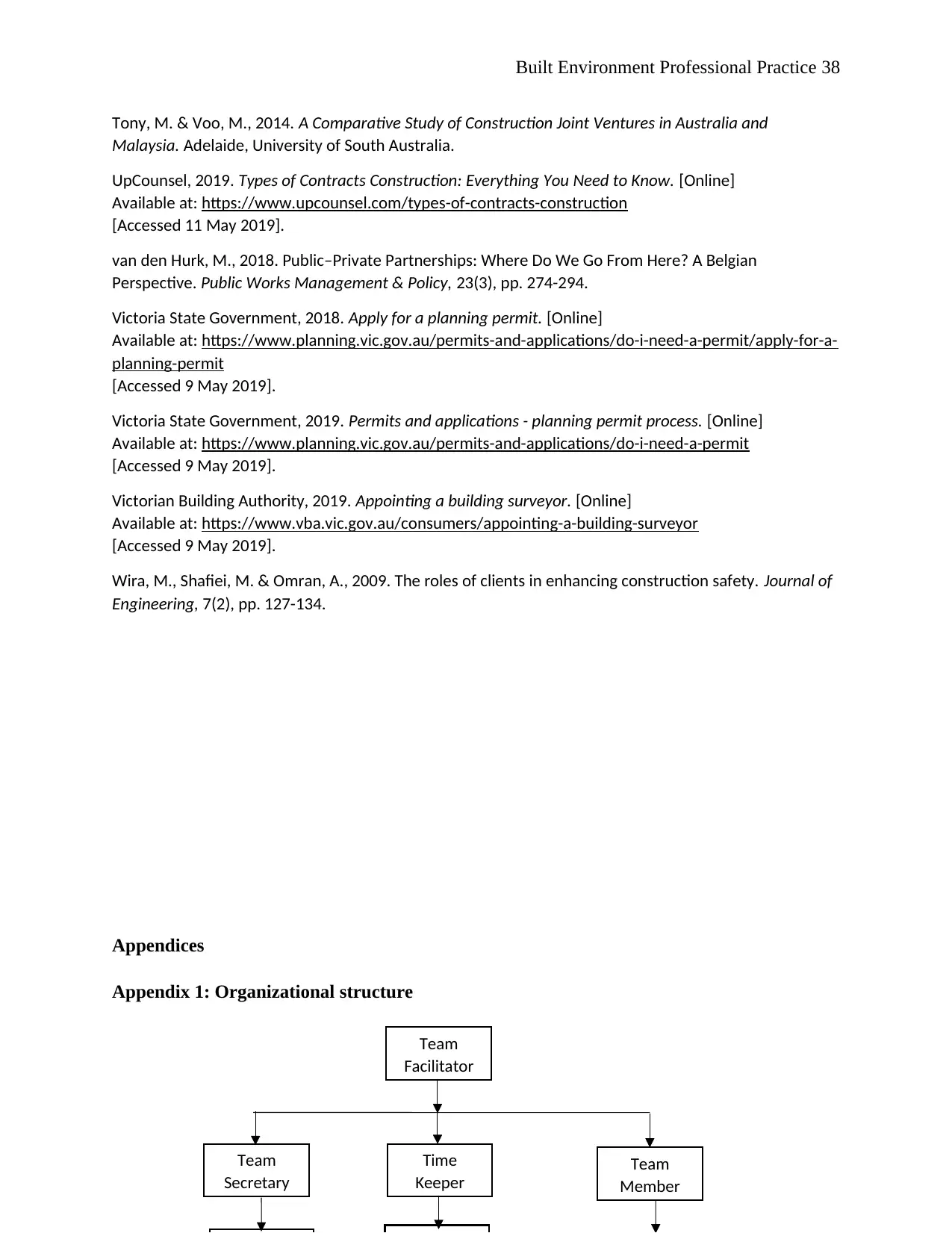
Built Environment Professional Practice 38
Tony, M. & Voo, M., 2014. A Comparative Study of Construction Joint Ventures in Australia and
Malaysia. Adelaide, University of South Australia.
UpCounsel, 2019. Types of Contracts Construction: Everything You Need to Know. [Online]
Available at: https://www.upcounsel.com/types-of-contracts-construction
[Accessed 11 May 2019].
van den Hurk, M., 2018. Public–Private Partnerships: Where Do We Go From Here? A Belgian
Perspective. Public Works Management & Policy, 23(3), pp. 274-294.
Victoria State Government, 2018. Apply for a planning permit. [Online]
Available at: https://www.planning.vic.gov.au/permits-and-applications/do-i-need-a-permit/apply-for-a-
planning-permit
[Accessed 9 May 2019].
Victoria State Government, 2019. Permits and applications - planning permit process. [Online]
Available at: https://www.planning.vic.gov.au/permits-and-applications/do-i-need-a-permit
[Accessed 9 May 2019].
Victorian Building Authority, 2019. Appointing a building surveyor. [Online]
Available at: https://www.vba.vic.gov.au/consumers/appointing-a-building-surveyor
[Accessed 9 May 2019].
Wira, M., Shafiei, M. & Omran, A., 2009. The roles of clients in enhancing construction safety. Journal of
Engineering, 7(2), pp. 127-134.
Appendices
Appendix 1: Organizational structure
Team
Facilitator
Team
Secretary
Team
Member
Time
Keeper
Tony, M. & Voo, M., 2014. A Comparative Study of Construction Joint Ventures in Australia and
Malaysia. Adelaide, University of South Australia.
UpCounsel, 2019. Types of Contracts Construction: Everything You Need to Know. [Online]
Available at: https://www.upcounsel.com/types-of-contracts-construction
[Accessed 11 May 2019].
van den Hurk, M., 2018. Public–Private Partnerships: Where Do We Go From Here? A Belgian
Perspective. Public Works Management & Policy, 23(3), pp. 274-294.
Victoria State Government, 2018. Apply for a planning permit. [Online]
Available at: https://www.planning.vic.gov.au/permits-and-applications/do-i-need-a-permit/apply-for-a-
planning-permit
[Accessed 9 May 2019].
Victoria State Government, 2019. Permits and applications - planning permit process. [Online]
Available at: https://www.planning.vic.gov.au/permits-and-applications/do-i-need-a-permit
[Accessed 9 May 2019].
Victorian Building Authority, 2019. Appointing a building surveyor. [Online]
Available at: https://www.vba.vic.gov.au/consumers/appointing-a-building-surveyor
[Accessed 9 May 2019].
Wira, M., Shafiei, M. & Omran, A., 2009. The roles of clients in enhancing construction safety. Journal of
Engineering, 7(2), pp. 127-134.
Appendices
Appendix 1: Organizational structure
Team
Facilitator
Team
Secretary
Team
Member
Time
Keeper
1 out of 38
Related Documents
Your All-in-One AI-Powered Toolkit for Academic Success.
+13062052269
info@desklib.com
Available 24*7 on WhatsApp / Email
![[object Object]](/_next/static/media/star-bottom.7253800d.svg)
Unlock your academic potential
© 2024 | Zucol Services PVT LTD | All rights reserved.





